
Narrative Essay Topics: TOP 200 Choices for Students

Imagine yourself facing a blank page, ready to fill it with your memories and imagination. What story will you tell today?
As students, you often have to write narratives that capture people's attention. But with so many stories to choose from, where do you start? How do you find the perfect topic that will grab our readers' interest and make them think?
Join our essay service experts as we explore 200 topics for college where stories are waiting to be told, and experiences are ready to be shared. From everyday events to unforgettable moments, each topic is a chance to connect with your readers and make them feel something.

Best Narrative Essay Topics: How to Choose the One That Resonates
A narrative essay is a type of writing that tells a personal story, including characters, plot, setting, and the order of events. Its main goal is to connect with readers emotionally and share a specific message or insight through the retelling of a meaningful experience.
Students write narrative essays as part of their studies for several reasons. Firstly, it allows them to express themselves creatively by sharing their unique experiences, thoughts, and feelings. Secondly, it helps them develop important writing skills like organizing ideas and thoughts effectively.
.webp)
Choosing good narrative essay ideas involves looking at personal experiences, interests, and the potential for engaging storytelling. Here's a simple guide to help you pick the right topic:
- Think about significant moments in your life that had a lasting impact, such as personal growth or overcoming challenges.
- Choose topics related to your hobbies, interests, or areas of expertise to make your story more engaging.
- Consider what your audience would be interested in and choose topics that resonate with them.
- Focus on a specific event or detail to make your narrative more focused and impactful.
- Look for universal themes like love or personal transformation that connect with readers on a deeper level.
- Brainstorm ideas and write freely to uncover compelling topics.
- Decide on storytelling techniques like flashbacks or foreshadowing and choose a topic that fits.
- Get feedback from friends, peers, or instructors to see if your topics are interesting and impactful.
- Choose topics that evoke strong emotions for a more compelling narrative.
- Select a topic that you personally connect with to make your story authentic.
Once you've chosen a topic, brainstorm ideas and create an outline for your essay. Follow your professor's instructions carefully and consider seeking help from our narrative essay writing service if needed.
Bring your stories to life with EssayPro. Select from a vast array of narrative essay topics and let our professionals help you weave your tales into captivating essays. Whether it's adventure, reflection, or imagination, we're here to assist.
Do You Need Professional Help with Your Hometask?
Ideas for Narrative Essay Topics
After exploring how students write narrative paragraphs, we've put together a list of narrative essay topics designed specifically for college and school students. This list covers a wide range of subjects, so pick one that speaks to you! If you want to see how to develop a topic into a written essay, check out our narrative essay example .
Literacy Narrative Essay Topics for College Students
How about delving into captivating literacy narrative essay topics designed specifically for college-level writing? Exciting, isn't it?
- How did learning to read change my perspective on the world?
- What was my favorite childhood book and why?
- How did writing my first story impact my love for storytelling?
- What challenges did I face when learning a new language?
- How did keeping a journal help me improve my writing skills?
- How did my family influence my attitude toward reading?
- What role did literature play in shaping my identity?
- How did participating in a book club enhance my reading experience?
- How did technology affect my reading habits?
- What was the most memorable book I read in school?
- How did my favorite teacher inspire my passion for literature?
- What impact did reading diverse perspectives have on my worldview?
- How did overcoming a reading difficulty shape my relationship with books?
- What lessons did I learn from writing my first poem?
- How did storytelling traditions in my culture influence my literacy journey?
Personal Narrative Essay Topics on Relationships
Take a moment to reflect on your past experiences and craft compelling personal narratives with these essay ideas.
- How did my relationship with my best friend change over time?
- What lessons did I learn from my first romantic relationship?
- How did my relationship with my sibling influence who I am today?
- What challenges did I face in maintaining a long-distance friendship?
- How did a conflict with a family member teach me about communication?
- What role do my pets play in my life and relationships?
- How did volunteering together strengthen my bond with a friend?
- What impact did a mentor have on my personal growth?
- How did a betrayal affect my trust in relationships?
- What did I learn from a failed friendship?
- How did traveling with a friend deepen our connection?
- What role does forgiveness play in maintaining healthy relationships?
- How did my relationship with my parents evolve as I grew older?
- What lessons did I learn about teamwork from a group project?
- How did a disagreement with a colleague teach me about compromise?
Best Narrative Essay Topics on Education and Learning
Consider the beauty of sharing your personal experiences and emotions in a captivating manner through these ideas for personal narrative essays.
- How did a particular teacher inspire me to excel in school?
- What challenges did I face while adapting to online learning?
- How did participating in extracurricular activities shape my educational experience?
- What lessons did I learn from a memorable field trip?
- How did studying abroad broaden my perspective on education?
- What role does technology play in modern education?
- How did overcoming a learning obstacle impact my academic journey?
- What did I gain from tutoring a classmate in a challenging subject?
- How did a hands-on learning experience change my understanding of a topic?
- What impact did a mentor have on my educational and career aspirations?
- How did peer collaboration enhance my learning in a group project?
- What lessons did I learn from a failure or setback in school?
- How did my cultural background influence my approach to education?
- What role does self-directed learning play in my academic success?
- How did participating in a debate or public speaking event shape my communication skills?
At this point, we think you might've already been interested in our term paper writing service that helps busy students succeed in college.
Personal Narrative Essay Ideas on Reflection on Life
Why not ignite your creativity with a range of narrative essay topics, from extraordinary moments to everyday experiences?
- How did confronting a fear change my view on courage and growth?
- How do family traditions shape my personal values and beliefs?
- What does success mean to me, and how has it evolved?
- Reflecting on friendships as a source of support in tough times.
- How have travel experiences expanded my global perspective?
- How do my hobbies and passions bring fulfillment to my life?
- Exploring the link between self-love and mental well-being.
- How can challenges lead to unexpected personal growth?
- Reflecting on the importance of setting and reaching personal goals.
- What pivotal moments mark my journey to self-acceptance?
- Investigating how forgiveness resolves personal conflicts.
- How do cultural expectations shape my idea of success?
- Reflecting on the significance of self-care for overall well-being.
- Exploring how technology influences my connections and worldview.
- What did I learn from facing a life-changing decision?
Ideas for a Narrative Essay on Culture and Society
Engaging your readers with narrative essays on culture and society is a great way to spark interest, offering captivating ideas for exploration.
- How has my cultural heritage shaped my identity?
- Reflecting on a tradition or ceremony that holds significance in my culture.
- Exploring the impact of globalization on local traditions and customs.
- How does language influence the way I perceive the world around me?
- Investigating the role of food in cultural identity and expression.
- Reflecting on a cultural celebration or festival that left a lasting impression.
- How does media portrayal affect societal perceptions of different cultures?
- Exploring the intersection of culture and religion in shaping values and beliefs.
- Reflecting on experiences of cultural assimilation or integration.
- How do stereotypes impact individuals within a cultural group?
- Investigating the role of art and literature in preserving cultural heritage.
- Reflecting on the challenges and benefits of multiculturalism in society.
- Exploring the significance of storytelling in passing down cultural traditions.
- How do cultural norms influence gender roles and expectations?
- Reflecting on the cultural exchange experiences that have broadened my perspective.
Since you're working on essays, we think it's suitable to suggest you learn more about the case study format , which is another common college assignment.
Narrative Writing Topics on Hobbies and Interests
Wow your readers by turning your passions and hobbies into compelling narrative essay topics that will get them thinking.
- Describe a memorable adventure or experience related to your favorite hobby.
- Reflect on how your hobby has evolved over time and its significance in your life.
- Write about a moment when your hobby provided a sense of escape or relaxation.
- Explore the role of hobbies in promoting mental health and well-being.
- Share a story of how you discovered your passion for a particular hobby.
- Describe a challenge you faced while pursuing your hobby and how you overcame it.
- Reflect on the impact of your hobby on your relationships with others.
- Write about a hobby-related achievement or milestone that you are proud of.
- Explore how your hobby connects you to a community or group of like-minded individuals.
- Describe the process of learning a new hobby and the lessons you gained from it.
- Reflect on the role of hobbies in balancing work, leisure, and personal growth.
- Write about a hobby-related project or creation that you are passionate about.
- Explore the connection between your hobbies and your broader interests and values.
- Describe a favorite memory or experience involving your hobby.
- Reflect on how your hobbies have influenced your perspective on life and the world around you.
Narrative Essay Titles on Life-Changing Moments
Life is full of unexpected twists that can lead to life-changing moments. Take a look at these narrative essay titles for stories that have had a lasting impact on your life.
- How did meeting a lifelong friend change my life?
- What lessons did I learn from overcoming a major obstacle?
- How did traveling to a new country broaden my perspective?
- Reflecting on the day I discovered my passion.
- How did a health scare transform my lifestyle?
- What impact did volunteering in my community have on me?
- How did I find strength in a moment of loss?
- Reflecting on the decision that altered my path.
- How did a random act of kindness change my outlook?
- What lessons did I learn from a failed endeavor?
- How did confronting a fear empower me?
- Reflecting on the day I realized my potential.
- How did experiencing a natural disaster shape my priorities?
- What insights did I gain from a cultural exchange?
- How did a mentor's guidance impact my life trajectory?
Have you ever wondered about the challenges of essay writing? What happens when you're assigned a larger paper, like coursework? Make a preemptive strike by exploring coursework writing service right now!
Good Narrative Topics on Travel and Adventure
Consider creating intriguing titles for your narrative essay ideas by exploring thrilling travel adventures.
- What was my most unforgettable travel experience?
- How did a solo journey change my perspective on life?
- Reflecting on an unexpected adventure in a foreign land.
- How did traveling on a budget lead to unexpected discoveries?
- What lessons did I learn from getting lost in a new city?
- How did a cultural immersion experience broaden my understanding of the world?
- Reflecting on the friendships formed during a travel adventure.
- What was the scariest moment I encountered while traveling?
- How did volunteering abroad impact my outlook on life?
- What cultural differences surprised me the most while traveling?
- Reflecting on the beauty of nature experienced during a hiking trip.
- How did traveling to a remote destination challenge my comfort zone?
- What was the most delicious food I tried while traveling?
- Reflecting on the kindness of strangers encountered during a journey.
- How did a travel mishap turn into a memorable experience?
Narrative Essay Topic Ideas on Career and Work Experience
College students can uncover captivating narrative essay ideas by exploring potential career paths or reminiscing about past job experiences.
- What was my first job, and what did I learn from it?
- Reflecting on a challenging project that taught me resilience.
- How did a career setback lead to unexpected opportunities?
- What lessons did I learn from transitioning to a new career?
- Reflecting on a mentor who influenced my career path.
- How did a workplace conflict teach me about communication?
- What was the most rewarding moment in my career so far?
- Reflecting on the importance of work-life balance in my career journey.
- How did networking help me advance in my career?
- What challenges did I face as a new graduate entering the workforce?
- Reflecting on the decision to pursue a passion versus stability in my career.
- How did a career change impact my sense of fulfillment?
- What skills did I develop through volunteer work that helped in my career?
- Reflecting on the role of mentors in my professional growth.
- How did a career milestone shape my future aspirations?
Interesting Narrative Essay Topics about Challenges and Obstacles
If you're not sure what to write about for your narrative essay, think back to the tough times you've had and how you managed to get through them.
- How did I overcome my fear of failure?
- Reflecting on a time when I felt like giving up but persevered.
- How did a personal setback lead to unexpected growth?
- What lessons did I learn from navigating a difficult relationship?
- Reflecting on a time when I had to step out of my comfort zone.
- How did I overcome a major health challenge?
- What strategies did I use to overcome procrastination?
- Reflecting on the resilience I developed after facing adversity.
- How did I navigate financial challenges and come out stronger?
- What did I learn from failing at something I was passionate about?
- Reflecting on the obstacles I faced while pursuing my dreams.
- How did I overcome imposter syndrome in my academic or professional life?
- What role did self-care play in helping me overcome challenges?
- Reflecting on a time when I had to stand up for myself in the face of adversity.
- How did I find motivation and inspiration during tough times?
Final Remarks
As we wrap up, our list of 200 narrative essay topics is here to fuel your creativity for your next writing project! Whether you're sharing a memorable event, reliving a childhood memory, or expressing a profound insight, crafting a narrative essay can be an uplifting experience that resonates deeply with readers.
And if you're gearing up for college admissions, why not check out our admission essay writing service ? We've already assisted countless students in securing their spots at their dream colleges, and we'd love to help you, too!
Give Us Your Task
We provide coursework writing help as well as editing and proofreading. Every paper we deal with is written and triple-checked by a team of experts—which means that you are guaranteed to get top-quality work from our term paper writing service . Order now!
Related Articles
.webp)
Narrative Analysis 101
Everything you need to know to get started
By: Ethar Al-Saraf (PhD)| Expert Reviewed By: Eunice Rautenbach (DTech) | March 2023
If you’re new to research, the host of qualitative analysis methods available to you can be a little overwhelming. In this post, we’ll unpack the sometimes slippery topic of narrative analysis . We’ll explain what it is, consider its strengths and weaknesses , and look at when and when not to use this analysis method.
Overview: Narrative Analysis
- What is narrative analysis (simple definition)
- The two overarching approaches
- The strengths & weaknesses of narrative analysis
- When (and when not) to use it
- Key takeaways
What Is Narrative Analysis?
Simply put, narrative analysis is a qualitative analysis method focused on interpreting human experiences and motivations by looking closely at the stories (the narratives) people tell in a particular context.
In other words, a narrative analysis interprets long-form participant responses or written stories as data, to uncover themes and meanings . That data could be taken from interviews, monologues, written stories, or even recordings. In other words, narrative analysis can be used on both primary and secondary data to provide evidence from the experiences described.
That’s all quite conceptual, so let’s look at an example of how narrative analysis could be used.
Let’s say you’re interested in researching the beliefs of a particular author on popular culture. In that case, you might identify the characters , plotlines , symbols and motifs used in their stories. You could then use narrative analysis to analyse these in combination and against the backdrop of the relevant context.
This would allow you to interpret the underlying meanings and implications in their writing, and what they reveal about the beliefs of the author. In other words, you’d look to understand the views of the author by analysing the narratives that run through their work.
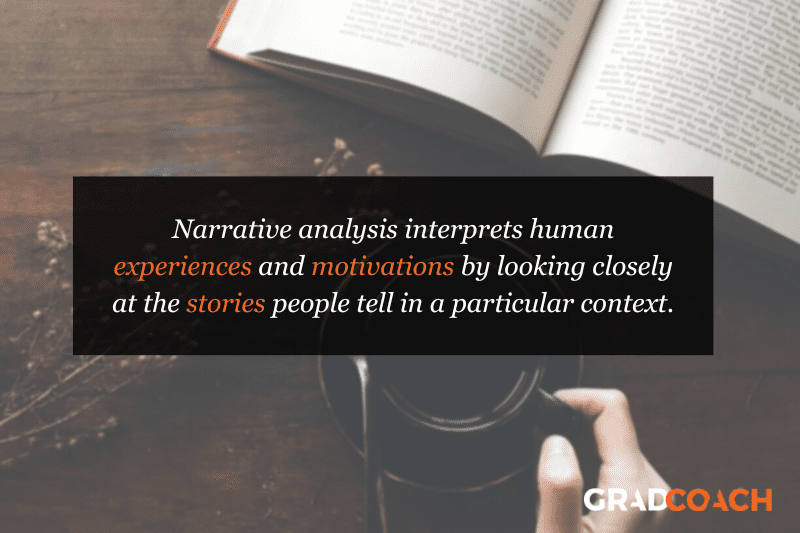
The Two Overarching Approaches
Generally speaking, there are two approaches that one can take to narrative analysis. Specifically, an inductive approach or a deductive approach. Each one will have a meaningful impact on how you interpret your data and the conclusions you can draw, so it’s important that you understand the difference.
First up is the inductive approach to narrative analysis.
The inductive approach takes a bottom-up view , allowing the data to speak for itself, without the influence of any preconceived notions . With this approach, you begin by looking at the data and deriving patterns and themes that can be used to explain the story, as opposed to viewing the data through the lens of pre-existing hypotheses, theories or frameworks. In other words, the analysis is led by the data.
For example, with an inductive approach, you might notice patterns or themes in the way an author presents their characters or develops their plot. You’d then observe these patterns, develop an interpretation of what they might reveal in the context of the story, and draw conclusions relative to the aims of your research.
Contrasted to this is the deductive approach.
With the deductive approach to narrative analysis, you begin by using existing theories that a narrative can be tested against . Here, the analysis adopts particular theoretical assumptions and/or provides hypotheses, and then looks for evidence in a story that will either verify or disprove them.
For example, your analysis might begin with a theory that wealthy authors only tell stories to get the sympathy of their readers. A deductive analysis might then look at the narratives of wealthy authors for evidence that will substantiate (or refute) the theory and then draw conclusions about its accuracy, and suggest explanations for why that might or might not be the case.
Which approach you should take depends on your research aims, objectives and research questions . If these are more exploratory in nature, you’ll likely take an inductive approach. Conversely, if they are more confirmatory in nature, you’ll likely opt for the deductive approach.
Need a helping hand?
Strengths & Weaknesses
Now that we have a clearer view of what narrative analysis is and the two approaches to it, it’s important to understand its strengths and weaknesses , so that you can make the right choices in your research project.
A primary strength of narrative analysis is the rich insight it can generate by uncovering the underlying meanings and interpretations of human experience. The focus on an individual narrative highlights the nuances and complexities of their experience, revealing details that might be missed or considered insignificant by other methods.
Another strength of narrative analysis is the range of topics it can be used for. The focus on human experience means that a narrative analysis can democratise your data analysis, by revealing the value of individuals’ own interpretation of their experience in contrast to broader social, cultural, and political factors.
All that said, just like all analysis methods, narrative analysis has its weaknesses. It’s important to understand these so that you can choose the most appropriate method for your particular research project.
The first drawback of narrative analysis is the problem of subjectivity and interpretation . In other words, a drawback of the focus on stories and their details is that they’re open to being understood differently depending on who’s reading them. This means that a strong understanding of the author’s cultural context is crucial to developing your interpretation of the data. At the same time, it’s important that you remain open-minded in how you interpret your chosen narrative and avoid making any assumptions .
A second weakness of narrative analysis is the issue of reliability and generalisation . Since narrative analysis depends almost entirely on a subjective narrative and your interpretation, the findings and conclusions can’t usually be generalised or empirically verified. Although some conclusions can be drawn about the cultural context, they’re still based on what will almost always be anecdotal data and not suitable for the basis of a theory, for example.
Last but not least, the focus on long-form data expressed as stories means that narrative analysis can be very time-consuming . In addition to the source data itself, you will have to be well informed on the author’s cultural context as well as other interpretations of the narrative, where possible, to ensure you have a holistic view. So, if you’re going to undertake narrative analysis, make sure that you allocate a generous amount of time to work through the data.

When To Use Narrative Analysis
As a qualitative method focused on analysing and interpreting narratives describing human experiences, narrative analysis is usually most appropriate for research topics focused on social, personal, cultural , or even ideological events or phenomena and how they’re understood at an individual level.
For example, if you were interested in understanding the experiences and beliefs of individuals suffering social marginalisation, you could use narrative analysis to look at the narratives and stories told by people in marginalised groups to identify patterns , symbols , or motifs that shed light on how they rationalise their experiences.
In this example, narrative analysis presents a good natural fit as it’s focused on analysing people’s stories to understand their views and beliefs at an individual level. Conversely, if your research was geared towards understanding broader themes and patterns regarding an event or phenomena, analysis methods such as content analysis or thematic analysis may be better suited, depending on your research aim .
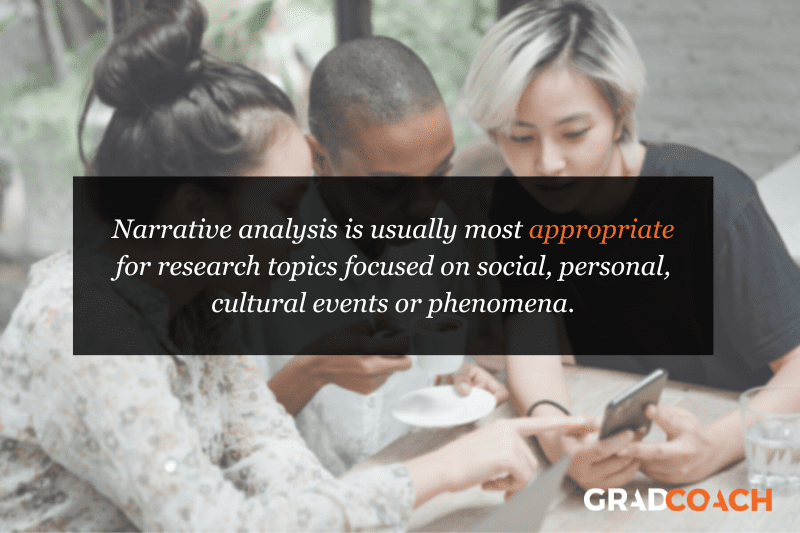
Let’s recap
In this post, we’ve explored the basics of narrative analysis in qualitative research. The key takeaways are:
- Narrative analysis is a qualitative analysis method focused on interpreting human experience in the form of stories or narratives .
- There are two overarching approaches to narrative analysis: the inductive (exploratory) approach and the deductive (confirmatory) approach.
- Like all analysis methods, narrative analysis has a particular set of strengths and weaknesses .
- Narrative analysis is generally most appropriate for research focused on interpreting individual, human experiences as expressed in detailed , long-form accounts.
If you’d like to learn more about narrative analysis and qualitative analysis methods in general, be sure to check out the rest of the Grad Coach blog here . Alternatively, if you’re looking for hands-on help with your project, take a look at our 1-on-1 private coaching service .

Psst… there’s more (for free)
This post is part of our dissertation mini-course, which covers everything you need to get started with your dissertation, thesis or research project.
You Might Also Like:
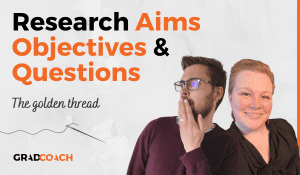
Thanks. I need examples of narrative analysis
Here are some examples of research topics that could utilise narrative analysis:
Personal Narratives of Trauma: Analysing personal stories of individuals who have experienced trauma to understand the impact, coping mechanisms, and healing processes.
Identity Formation in Immigrant Communities: Examining the narratives of immigrants to explore how they construct and negotiate their identities in a new cultural context.
Media Representations of Gender: Analysing narratives in media texts (such as films, television shows, or advertisements) to investigate the portrayal of gender roles, stereotypes, and power dynamics.
Where can I find an example of a narrative analysis table ?
Please i need help with my project,
how can I cite this article in APA 7th style?
please mention the sources as well.
My research is mixed approach. I use interview,key_inforamt interview,FGD and document.so,which qualitative analysis is appropriate to analyze these data.Thanks
Which qualitative analysis methode is appropriate to analyze data obtain from intetview,key informant intetview,Focus group discussion and document.
I’ve finished my PhD. Now I need a “platform” that will help me objectively ascertain the tacit assumptions that are buried within a narrative. Can you help?
Submit a Comment Cancel reply
Your email address will not be published. Required fields are marked *
Save my name, email, and website in this browser for the next time I comment.
- Print Friendly

The Ultimate Guide to Qualitative Research - Part 2: Handling Qualitative Data

- Handling qualitative data
- Transcripts
- Field notes
- Survey data and responses
- Visual and audio data
- Data organization
- Data coding
- Coding frame
- Auto and smart coding
- Organizing codes
- Qualitative data analysis
- Content analysis
Thematic analysis
- Thematic analysis vs. content analysis
- Introduction
Types of narrative research
Research methods for a narrative analysis, narrative analysis, considerations for narrative analysis.
- Phenomenological research
- Discourse analysis
- Grounded theory
- Deductive reasoning
- Inductive reasoning
- Inductive vs. deductive reasoning
- Qualitative data interpretation
- Qualitative analysis software
Narrative analysis in research
Narrative analysis is an approach to qualitative research that involves the documentation of narratives both for the purpose of understanding events and phenomena and understanding how people communicate stories.

Let's look at the basics of narrative research, then examine the process of conducting a narrative inquiry and how ATLAS.ti can help you conduct a narrative analysis.
Qualitative researchers can employ various forms of narrative research, but all of these distinct approaches utilize perspectival data as the means for contributing to theory.
A biography is the most straightforward form of narrative research. Data collection for a biography generally involves summarizing the main points of an individual's life or at least the part of their history involved with events that a researcher wants to examine. Generally speaking, a biography aims to provide a more complete record of an individual person's life in a manner that might dispel any inaccuracies that exist in popular thought or provide a new perspective on that person’s history. Narrative researchers may also construct a new biography of someone who doesn’t have a public or online presence to delve deeper into that person’s history relating to the research topic.
The purpose of biographies as a function of narrative inquiry is to shed light on the lived experience of a particular person that a more casual examination of someone's life might overlook. Newspaper articles and online posts might give someone an overview of information about any individual. At the same time, a more involved survey or interview can provide sufficiently comprehensive knowledge about a person useful for narrative analysis and theoretical development.
Life history
This is probably the most involved form of narrative research as it requires capturing as much of the total human experience of an individual person as possible. While it involves elements of biographical research, constructing a life history also means collecting first-person knowledge from the subject through narrative interviews and observations while drawing on other forms of data , such as field notes and in-depth interviews with others.
Even a newspaper article or blog post about the person can contribute to the contextual meaning informing the life history. The objective of conducting a life history is to construct a complete picture of the person from past to present in a manner that gives your research audience the means to immerse themselves in the human experience of the person you are studying.
Oral history
While all forms of narrative research rely on narrative interviews with research participants, oral histories begin with and branch out from the individual's point of view as the driving force of data collection .
Major events like wars and natural disasters are often observed and described at scale, but a bird's eye view of such events may not provide a complete story. Oral history can assist researchers in providing a unique and perhaps unexplored perspective from in-depth interviews with a narrator's own words of what happened, how they experienced it, and what reasons they give for their actions. Researchers who collect this sort of information can then help fill in the gaps common knowledge may not have grasped.
The objective of an oral history is to provide a perspective built on personal experience. The unique viewpoint that personal narratives can provide has the potential to raise analytical insights that research methods at scale may overlook. Narrative analysis of oral histories can hence illuminate potential inquiries that can be addressed in future studies.

Whatever your research, get it done with ATLAS.ti.
From case study research to interviews, turn to ATLAS.ti for your qualitative research. Click here for a free trial.
To conduct narrative analysis, researchers need a narrative and research question . A narrative alone might make for an interesting story that instills information, but analyzing a narrative to generate knowledge requires ordering that information to identify patterns, intentions, and effects.
Narrative analysis presents a distinctive research approach among various methodologies , and it can pose significant challenges due to its inherent interpretative nature. Essentially, this method revolves around capturing and examining the verbal or written accounts and visual depictions shared by individuals. Narrative inquiry strives to unravel the essence of what is conveyed by closely observing the content and manner of expression.
Furthermore, narrative research assumes a dual role, serving both as a research technique and a subject of investigation. Regarded as "real-world measures," narrative methods provide valuable tools for exploring actual societal issues. The narrative approach encompasses an individual's life story and the profound significance embedded within their lived experiences. Typically, a composite of narratives is synthesized, intermingling and mutually influencing each other.

Designing a research inquiry
Sometimes, narrative research is less about the storyteller or the story they are telling than it is about generating knowledge that contributes to a greater understanding of social behavior and cultural practices. While it might be interesting or useful to hear a comedian tell a story that makes their audience laugh, a narrative analysis of that story can identify how the comedian constructs their narrative or what causes the audience to laugh.
As with all research, a narrative inquiry starts with a research question that is tied to existing relevant theory regarding the object of analysis (i.e., the person or event for which the narrative is constructed). If your research question involves studying racial inequalities in university contexts, for example, then the narrative analysis you are seeking might revolve around the lived experiences of students of color. If you are analyzing narratives from children's stories, then your research question might relate to identifying aspects of children's stories that grab the attention of young readers. The point is that researchers conducting a narrative inquiry do not do so merely to collect more information about their object of inquiry. Ultimately, narrative research is tied to developing a more contextualized or broader understanding of the social world.
Data collection
Having crafted the research questions and chosen the appropriate form of narrative research for your study, you can start to collect your data for the eventual narrative analysis.

Needless to say, the key point in narrative research is the narrative. The story is either the unit of analysis or the focal point from which researchers pursue other methods of research. Interviews and observations are great ways to collect narratives. Particularly with biographies and life histories, one of the best ways to study your object of inquiry is to interview them. If you are conducting narrative research for discourse analysis, then observing or recording narratives (e.g., storytelling, audiobooks, podcasts) is ideal for later narrative analysis.
Triangulating data
If you are collecting a life history or an oral history, then you will need to rely on collecting evidence from different sources to support the analysis of the narrative. In research, triangulation is the concept of drawing on multiple methods or sources of data to get a more comprehensive picture of your object of inquiry.
While a narrative inquiry is constructed around the story or its storyteller, assertions that can be made from an analysis of the story can benefit from supporting evidence (or lack thereof) collected by other means.
Even a lack of supporting evidence might be telling. For example, suppose your object of inquiry tells a story about working minimum wage jobs all throughout college to pay for their tuition. Looking for triangulation, in this case, means searching through records and other forms of information to support the claims being put forth. If it turns out that the storyteller's claims bear further warranting - maybe you discover that family or scholarships supported them during college - your analysis might uncover new inquiries as to why the story was presented the way it was. Perhaps they are trying to impress their audience or construct a narrative identity about themselves that reinforces their thinking about who they are. The important point here is that triangulation is a necessary component of narrative research to learn more about the object of inquiry from different angles.
Conduct data analysis for your narrative research with ATLAS.ti.
Dedicated research software like ATLAS.ti helps the researcher catalog, penetrate, and analyze the data generated in any qualitative research project. Start with a free trial today.
This brings us to the analysis part of narrative research. As explained above, a narrative can be viewed as a straightforward story to understand and internalize. As researchers, however, we have many different approaches available to us for analyzing narrative data depending on our research inquiry.
In this section, we will examine some of the most common forms of analysis while looking at how you can employ tools in ATLAS.ti to analyze your qualitative data .
Qualitative research often employs thematic analysis , which refers to a search for commonly occurring themes that appear in the data. The important point of thematic analysis in narrative research is that the themes arise from the data produced by the research participants. In other words, the themes in a narrative study are strongly based on how the research participants see them rather than focusing on how researchers or existing theory see them.
ATLAS.ti can be used for thematic analysis in any research field or discipline. Data in narrative research is summarized through the coding process , where the researcher codes large segments of data with short, descriptive labels that can succinctly describe the data thematically. The emerging patterns among occurring codes in the perspectival data thus inform the identification of themes that arise from the collected narratives.
Structural analysis
The search for structure in a narrative is less about what is conveyed in the narrative and more about how the narrative is told. The differences in narrative forms ultimately tell us something useful about the meaning-making epistemologies and values of the people telling them and the cultures they inhabit.
Just like in thematic analysis, codes in ATLAS.ti can be used to summarize data, except that in this case, codes could be created to specifically examine structure by identifying the particular parts or moves in a narrative (e.g., introduction, conflict, resolution). Code-Document Analysis in ATLAS.ti can then tell you which of your narratives (represented by discrete documents) contain which parts of a common narrative.
It may also be useful to conduct a content analysis of narratives to analyze them structurally. English has many signal words and phrases (e.g., "for example," "as a result," and "suddenly") to alert listeners and readers that they are coming to a new step in the narrative.
In this case, both the Text Search and Word Frequencies tools in ATLAS.ti can help you identify the various aspects of the narrative structure (including automatically identifying discrete parts of speech) and the frequency in which they occur across different narratives.
Functional analysis
Whereas a straightforward structural analysis identifies the particular parts of a narrative, a functional analysis looks at what the narrator is trying to accomplish through the content and structure of their narrative. For example, if a research participant telling their narrative asks the interviewer rhetorical questions, they might be doing so to make the interviewer think or adopt the participant's perspective.
A functional analysis often requires the researcher to take notes and reflect on their experiences while collecting data from research participants. ATLAS.ti offers a dedicated space for memos , which can serve to jot down useful contextual information that the researcher can refer to while coding and analyzing data.
Dialogic analysis
There is a nuanced difference between what a narrator tries to accomplish when telling a narrative and how the listener is affected by the narrative. There may be an overlap between the two, but the extent to which a narrative might resonate with people can give us useful insights about a culture or society.
The topic of humor is one such area that can benefit from dialogic analysis, considering that there are vast differences in how cultures perceive humor in terms of how a joke is constructed or what cultural references are required to understand a joke.
Imagine that you are analyzing a reading of a children's book in front of an audience of children at a library. If it is supposed to be funny, how do you determine what parts of the book are funny and why?
The coding process in ATLAS.ti can help with dialogic analysis of a transcript from that reading. In such an analysis, you can have two sets of codes, one for thematically summarizing the elements of the book reading and one for marking when the children laugh.
The Code Co-Occurrence Analysis tool can then tell you which codes occur during the times that there is laughter, giving you a sense of what parts of a children's narrative might be funny to its audience.
Narrative analysis and research hold immense significance within the realm of social science research, contributing a distinct and valuable approach. Whether employed as a component of a comprehensive presentation or pursued as an independent scholarly endeavor, narrative research merits recognition as a distinctive form of research and interpretation in its own right.
Subjectivity in narratives

It is crucial to acknowledge that every narrative is intricately intertwined with its cultural milieu and the subjective experiences of the storyteller. While the outcomes of research are undoubtedly influenced by the individual narratives involved, a conscientious adherence to narrative methodology and a critical reflection on one's research can foster transparent and rigorous investigations, minimizing the potential for misunderstandings.
Rather than striving to perceive narratives through an objective lens, it is imperative to contextualize them within their sociocultural fabric. By doing so, an analysis can embrace the diverse array of narratives and enable multiple perspectives to illuminate a phenomenon or story. Embracing such complexity, narrative methodologies find considerable application in social science research.
Connecting narratives to broader phenomena
In employing narrative analysis, researchers delve into the intricate tapestry of personal narratives, carefully considering the multifaceted interplay between individual experiences and broader societal dynamics.
This meticulous approach fosters a deeper understanding of the intricate web of meanings that shape the narratives under examination. Consequently, researchers can uncover rich insights and discern patterns that may have remained hidden otherwise. These can provide valuable contributions to both theory and practice.
In summary, narrative analysis occupies a vital position within social science research. By appreciating the cultural embeddedness of narratives, employing a thoughtful methodology, and critically reflecting on one's research, scholars can conduct robust investigations that shed light on the complexities of human experiences while avoiding potential pitfalls and fostering a nuanced understanding of the narratives explored.
Turn to ATLAS.ti for your narrative analysis.
Researchers can rely on ATLAS.ti for conducting qualitative research. See why with a free trial.
Have a language expert improve your writing
Run a free plagiarism check in 10 minutes, generate accurate citations for free.
- Knowledge Base
- How to write a narrative essay | Example & tips
How to Write a Narrative Essay | Example & Tips
Published on July 24, 2020 by Jack Caulfield . Revised on July 23, 2023.
A narrative essay tells a story. In most cases, this is a story about a personal experience you had. This type of essay , along with the descriptive essay , allows you to get personal and creative, unlike most academic writing .
Instantly correct all language mistakes in your text
Upload your document to correct all your mistakes in minutes

Table of contents
What is a narrative essay for, choosing a topic, interactive example of a narrative essay, other interesting articles, frequently asked questions about narrative essays.
When assigned a narrative essay, you might find yourself wondering: Why does my teacher want to hear this story? Topics for narrative essays can range from the important to the trivial. Usually the point is not so much the story itself, but the way you tell it.
A narrative essay is a way of testing your ability to tell a story in a clear and interesting way. You’re expected to think about where your story begins and ends, and how to convey it with eye-catching language and a satisfying pace.
These skills are quite different from those needed for formal academic writing. For instance, in a narrative essay the use of the first person (“I”) is encouraged, as is the use of figurative language, dialogue, and suspense.
Prevent plagiarism. Run a free check.
Narrative essay assignments vary widely in the amount of direction you’re given about your topic. You may be assigned quite a specific topic or choice of topics to work with.
- Write a story about your first day of school.
- Write a story about your favorite holiday destination.
You may also be given prompts that leave you a much wider choice of topic.
- Write about an experience where you learned something about yourself.
- Write about an achievement you are proud of. What did you accomplish, and how?
In these cases, you might have to think harder to decide what story you want to tell. The best kind of story for a narrative essay is one you can use to talk about a particular theme or lesson, or that takes a surprising turn somewhere along the way.
For example, a trip where everything went according to plan makes for a less interesting story than one where something unexpected happened that you then had to respond to. Choose an experience that might surprise the reader or teach them something.
Narrative essays in college applications
When applying for college , you might be asked to write a narrative essay that expresses something about your personal qualities.
For example, this application prompt from Common App requires you to respond with a narrative essay.
In this context, choose a story that is not only interesting but also expresses the qualities the prompt is looking for—here, resilience and the ability to learn from failure—and frame the story in a way that emphasizes these qualities.
An example of a short narrative essay, responding to the prompt “Write about an experience where you learned something about yourself,” is shown below.
Hover over different parts of the text to see how the structure works.
Since elementary school, I have always favored subjects like science and math over the humanities. My instinct was always to think of these subjects as more solid and serious than classes like English. If there was no right answer, I thought, why bother? But recently I had an experience that taught me my academic interests are more flexible than I had thought: I took my first philosophy class.
Before I entered the classroom, I was skeptical. I waited outside with the other students and wondered what exactly philosophy would involve—I really had no idea. I imagined something pretty abstract: long, stilted conversations pondering the meaning of life. But what I got was something quite different.
A young man in jeans, Mr. Jones—“but you can call me Rob”—was far from the white-haired, buttoned-up old man I had half-expected. And rather than pulling us into pedantic arguments about obscure philosophical points, Rob engaged us on our level. To talk free will, we looked at our own choices. To talk ethics, we looked at dilemmas we had faced ourselves. By the end of class, I’d discovered that questions with no right answer can turn out to be the most interesting ones.
The experience has taught me to look at things a little more “philosophically”—and not just because it was a philosophy class! I learned that if I let go of my preconceptions, I can actually get a lot out of subjects I was previously dismissive of. The class taught me—in more ways than one—to look at things with an open mind.
If you want to know more about AI tools , college essays , or fallacies make sure to check out some of our other articles with explanations and examples or go directly to our tools!
- Ad hominem fallacy
- Post hoc fallacy
- Appeal to authority fallacy
- False cause fallacy
- Sunk cost fallacy
College essays
- Choosing Essay Topic
- Write a College Essay
- Write a Diversity Essay
- College Essay Format & Structure
- Comparing and Contrasting in an Essay
(AI) Tools
- Grammar Checker
- Paraphrasing Tool
- Text Summarizer
- AI Detector
- Plagiarism Checker
- Citation Generator
If you’re not given much guidance on what your narrative essay should be about, consider the context and scope of the assignment. What kind of story is relevant, interesting, and possible to tell within the word count?
The best kind of story for a narrative essay is one you can use to reflect on a particular theme or lesson, or that takes a surprising turn somewhere along the way.
Don’t worry too much if your topic seems unoriginal. The point of a narrative essay is how you tell the story and the point you make with it, not the subject of the story itself.
Narrative essays are usually assigned as writing exercises at high school or in university composition classes. They may also form part of a university application.
When you are prompted to tell a story about your own life or experiences, a narrative essay is usually the right response.
The key difference is that a narrative essay is designed to tell a complete story, while a descriptive essay is meant to convey an intense description of a particular place, object, or concept.
Narrative and descriptive essays both allow you to write more personally and creatively than other kinds of essays , and similar writing skills can apply to both.
Cite this Scribbr article
If you want to cite this source, you can copy and paste the citation or click the “Cite this Scribbr article” button to automatically add the citation to our free Citation Generator.
Caulfield, J. (2023, July 23). How to Write a Narrative Essay | Example & Tips. Scribbr. Retrieved April 10, 2024, from https://www.scribbr.com/academic-essay/narrative-essay/
Is this article helpful?

Jack Caulfield
Other students also liked, how to write an expository essay, how to write a descriptive essay | example & tips, how to write your personal statement | strategies & examples, unlimited academic ai-proofreading.
✔ Document error-free in 5minutes ✔ Unlimited document corrections ✔ Specialized in correcting academic texts
OPINION article
Methods for conducting and publishing narrative research with undergraduates.

- 1 Psychology Department, Hamilton College, Clinton, NY, United States
- 2 Department of Psychological Sciences and Institute for Autism Research, Canisius College, Buffalo, NY, United States
Introduction
Narrative research systematically codes individual differences in the ways in which participants story crucial events in their lives to understand the extent to which they create meaning and purpose ( McAdams, 2008 ). These narrative descriptions of life events address a diverse array of topics, such as personality ( McAdams and Guo, 2015 ), development ( Fivush et al., 2006 ), clinical applications ( Banks and Salmon, 2013 ), well-being ( Adler et al., 2016 ), gender ( Grysman et al., 2016 ), and older adult memory decline ( Levine et al., 2002 ).
Narrative research is an ideal way to involve undergraduate students as contributors to broader projects and often as co-authors. In narrative or mixed method research, undergraduates have the opportunity to think critically about methodology during study construction and implementation, and then by engaging with questions of construct validity when exploring how different methods yield complementary data on one topic. In narrative research in psychology, students collect data, as in many traditional psychology laboratories, but they collect either typed or spoken narratives and then extensively code narratives before quantitative data analysis can occur. Narrative research thus provides a unique opportunity to blend the psychological realities captured by qualitative data with the rigors of quantitative methods.
Narrative researchers start by establishing the construct of interest, deciding when coding narratives for this construct is the most effective form of measurement, rather than a questionnaire or some other form of assessment. A coding manual is developed or adopted, and all coders study the manual, practice implementing it, and discuss the process and any disagreements until the team is confident that all coders are implementing the rules in a similar way. A reliability set is then initiated, such that coders assess a group of narratives from the data of interest independently, compare their codes, and conduct reliability statistics (e.g., Intraclass coefficient, Cohen's kappa). When a predetermined threshold of agreement has been reached and a sufficient percentage of the narrative data has been coded, the two raters are deemed sufficiently similar, disagreements are resolved (by conversation or vote), and one coder completes the remainder of the narrative data. Readers are directed to Syed and Nelson (2015) and to Adler et al. (2017) for further details regarding this process, as these papers provide greater depth regarding best practices coding.
Narrative Coding in an Undergraduate Laboratory: Common Challenges and Best Practices
When are students co-authors.
Narrative coding requires heavy investment of time and energy from the student, but time and energy are not the only qualities that matter when deciding on authorship. Because students are often shielded from hypotheses for the duration of coding in order to maintain objectivity and to not bias them in their coding decisions, researchers may be in a bind when data finally arrive; they want to move toward writing but students are not yet sufficiently knowledgeable to act as co-authors. Kosslyn (2002) outlines six criteria for establishing authorship (see also Fine and Kurdek, 1993 ), and includes a scoring system for the idea, design, implementation (i.e., creation of materials), conducting the experiment, data analysis, and writing. A student who puts countless hours into narrative coding has still only contributed to conducting the experiment or data analysis. If the goal is including students as authors, researchers should consider these many stages as entry points into the research process. After coding has completed, students should read background literature while data are analyzed and be included in the writing process, as detailed below (see “the route to publishing”). In addition, explicit conversations with students about their roles and expectations in a project are always advised.
Roadblocks to Student Education
One concern of a researcher managing a narrative lab is communicating the goals and methods of the interrater process to student research assistants, who have likely never encountered a process like this before. Adding to this challenge is the fact that often researchers shield undergraduates from the study's hypotheses to reduce bias and maintain their objectivity, which can serve as a roadblock both for students' education and involvement in the project and for their ability to make decisions in borderline cases. Clearly communicating the goals and methods involved in a coding project are essential, as is planning for the time needed to orient students to the hypotheses after coding if they are to be included in the later steps of data analysis and writing. In the following two sections, we expand on challenges that arise in this vein and how we have addressed them.
Interpersonal Dynamics
A critical challenge in the interrater process addresses students' experience of power relationships, self-esteem, and internalization of the coding process. In the early stages, students often disagree on how to code a given narrative. Especially when the professor mediates these early disagreements, students might feel intimidated by a professor who sides with one student more consistently than another. Furthermore, disagreeing with a fellow student may be perceived as putting them down; students often hedge explanations with statements like “I was on the fence between those two,” and “you're probably right.” These interpersonal concerns must be addressed early in the coding process, with the goal of translating a theoretical construct into guidelines for making difficult decisions with idiosyncratic data. In the course of this process, students make the most progress by explaining their assumptions and decision process, to help identify points of divergence. Rules-of-thumb that are established in this process will be essential for future cases, increasing agreement but also creating a shared sense of coding goals so that it can be implemented consistently in new circumstances. Thus, interpersonal concerns and intimidation undermine the interrater process by introducing motivations for picking a particular code, ultimately creating a bias in the name of saving face and achieving agreement rather than leading toward agreement because of a shared representation of micro-level decisions that support the coding system.
Clearly communicating the goal of the interrater process is key to establishing a productive coding environment, mitigating the pitfalls described above. One of us (AG) begins coding meetings by discussing the goals of the interrater process, emphasizing that disagreeing ultimately helps us clarify assumptions and prevents future disagreements. If the professor agrees with one person more than another, it is not a sign of favoritism or greater intelligence. Given the novelty of the coding task and undergraduate students' developmental stage, students sometimes need reassurance emphasizing that some people are better at some coding systems than others, or even that some are better coders, and that these skills should not be connected to overall worth.
The next set of challenges pertains to students' own life settings. Depending on the structure of research opportunities in a given department, students work limited hours per week on a project, are commonly only available during the academic semester, and are often pulled by competing commitments. Researchers should establish a framework to help students stay focused on the coding project and complete a meaningful unit of coding before various vacations, semesters abroad, or leaving the laboratory to pursue other interests. This paper discusses best practices that help circumvent these pitfalls, but we recommend designing projects with them in mind. Some coding systems are better suited to semester-long commitments of 3 h per week whereas others need larger time commitments, such as from students completing summer research. It is helpful to identify RAs' long-term plans across semesters, knowing who is going abroad, who expects to stay in the lab, and assigning projects accordingly.
Building a robust collaborative environment can shape an invested team who will be engaged in the sustained efforts needed for successful narrative research. In one of our labs (JLS), general lab meetings are conducted to discuss coding protocols and do collaborative practice. Then an experienced coder is paired with a new lab member. The experienced coder codes while walking the new coder through the decision process for a week's worth of assigned coding. The new coder practices on a standard set of practice narratives under the supervision of the experienced coder, discussing the process throughout. The new coder's work is checked for agreement with published codes and years of other practice coders. The new coder then codes new narratives under the supervision of the experienced coder for 2 weeks or until comfortable coding independently. The most experienced and conscientious junior applies for an internal grant each year to be the lab manager during senior year. This lab manager assigns weekly coding and assists with practical concerns. Coding challenges are discussed at weekly lab meetings. More experienced coders also lead weekly “discrepancy meetings” where two or three trained coders review discrepancies in a coded data set and come to a consensus rating. Such meetings give the students further learning and leadership opportunities. These meetings are done in small teams to accommodate the students' differing schedules and help build understanding of the constructs and a good dynamic in the team.
The Route to Publishing With Undergraduates in Narrative Psychology
When coding has successfully been completed, researchers then have the opportunity to publish their work with undergraduates. When talented students are involved on projects, the transition to writing completes their research experience. A timeline should be established and a process clearly identified: who is the lead author? Is that person writing the whole manuscript and the second author editing or are different sections being written? We have considered all these approaches depending on the abilities and circumstances of the undergraduate. In one example Grysman and Denney (2017) , AG sent successive sections to the student for editing throughout the writing process. In another, because of the student's ability in quantitative analysis and figure creation ( Grysman and Dimakis, 2018 ), the undergraduate took the lead on results, and edited the researcher's writing for the introduction and discussion. In a third (Meisels and Grysman, submitted), the undergraduate more centrally designed the study as an honors thesis, and is writing up the manuscript while the researcher edits and writes the heavier statistics and methodological pieces. In another example, Lodi-Smith et al. (2009) archival open-ended responses were available to code for new constructs, allowing for a shorter project time frame than collecting new narrative data. The undergraduate student's three-semester honors thesis provided the time, scope, and opportunity to code and analyze archival narratives of personality change during college. As narrative labs often have a rich pool of archival data from which new studies can emerge, they can be a rich source of novel data for undergraduate projects.
In sum, there isn't one model of how to yield publishable work, but once the core of a narrative lab has been established, the researcher can flexibly include undergraduates in the writing process to differing degrees. As in other programs of research, students have the opportunity to learn best practices in data collection and analysis in projects they are not actively coding. Because of the need to keep coders blind to study hypotheses it is often helpful to maintain multiple projects in different points of development. Students can gain experience across the research process helping collect new data, coding existing narratives, and analyzing and writing up the coding of previous cohorts of students.
Most importantly, narrative research gives students an opportunity to learn about individuals beyond what they learn in the systematic research process and outcomes of their research. The majority of undergraduate research assistants are not going on to careers as psychologists conducting academic research on narrative identity. Many undergraduate psychology students will work in clinical/counseling settings, in social work, or in related mental health fields. The skills learned in a narrative research lab can generalize far beyond the specific goals of the research team. By reading individual narratives, students and faculty have the opportunity to learn about the lived life, hearing the reality in how people story trauma, success, challenges, and change. They can begin to see subtlety and nuance beyond their own experience and come to appreciate the importance of asking questions and learning from the answers.
Author Contributions
All authors listed have made a substantial, direct and intellectual contribution to the work, and approved it for publication.
Funding for this article is supported by an internal grant from Hamilton College.
Conflict of Interest Statement
The authors declare that the research was conducted in the absence of any commercial or financial relationships that could be construed as a potential conflict of interest.
Adler, J. M., Dunlop, W. L., Fivush, R., Lilgendahl, J. P., Lodi-Smith, J., McAdams, D. P., et al. (2017). Research methods for studying narrative identity: a primer. Soc. Psychol. Pers. Sci. 8, 519–527.
Google Scholar
Adler, J. M., Lodi-Smith, J., Philippe, F. L., and Houle, I. (2016). The incremental validity of narrative identity in predicting well-being: a review of the field and recommendations for the future. Person. Soc. Psychol. Rev. 20, 142–175. doi: 10.1177/1088868315585068
PubMed Abstract | CrossRef Full Text | Google Scholar
Banks, M. V., and Salmon, K. (2013). Reasoning about the self in positive and negative ways: Relationship to psychological functioning in young adulthood. Memory 21, 10–26. doi: 10.1080/09658211.2012.707213
Fine, M. A., and Kurdek, L. A. (1993). Reflections on determining authorship credit and authorship order on faculty-student collaborations. Am. Psychol. 48:1141.
Fivush, R., Haden, C. A., and Reese, E. (2006). Elaborating on elaborations: Role of maternal reminiscing style in cognitive and social development. Child Dev. 77, 1568–1588. doi: 10.1111/j.1467-8624.2006.00960.x
CrossRef Full Text | Google Scholar
Grysman, A., and Denney, A. (2017). Context and content of gendered autobiographical memories: the roles of experimenter gender and medium of report. Memory 25, 132–145. doi: 10.1080/09658211.2015.1133829
Grysman, A., and Dimakis, S. (2018). Later adults' cultural life scripts of middle and later adulthood. Aging Neuropsychol. Cogn. 25, 406–426. doi: 10.1080/13825585.2017.1319458
Grysman, A., Fivush, R., Merrill, N. A., and Graci, M. (2016). The influence of gender and gender typicality on autobiographical memory across event types and age groups. Mem. Cognit. 44, 856–868. doi: 10.3758/s13421-016-0610-2
Kosslyn, S. (2002). Criteria for Authorship . Available online at: https://kosslynlab.fas.harvard.edu/files/kosslynlab/files/authorship_criteria_nov02.pdf
Levine, B., Svoboda, E., Hay, J. F., Winocur, G., and Moscovitch, M. (2002). Aging and autobiographical memory: dissociating episodic from semantic retrieval. Psychol. Aging 17, 677–689. doi: 10.1037/0882-7974.17.4.677
Lodi-Smith, J., Geise, A. C., Roberts, B. W., and Robins, R. W. (2009). Narrating personality change. J. Pers. Soc. Psychol. 96, 679–689. doi: 10.1037/a0014611
McAdams, D. P. (2008). The Person: An Introduction to the Science of Personality Psychology. Hoboken, NJ: John Wiley & Sons.
McAdams, D. P., and Guo, J. (2015). Narrating the generative life. Psychol. Sci. 26, 475–483. doi: 10.1177/0956797614568318
Syed, M., and Nelson, S. C. (2015). Guidelines for establishing reliability when coding narrative data. Emerg. Adulth. 3, 375–387. doi: 10.1177/2167696815587648
Keywords: narrative research, autobiographical memory, undergraduate, content coding, publishing with undergraduates
Citation: Grysman A and Lodi-Smith J (2019) Methods for Conducting and Publishing Narrative Research With Undergraduates. Front. Psychol . 9:2771. doi: 10.3389/fpsyg.2018.02771
Received: 20 November 2018; Accepted: 24 December 2018; Published: 17 January 2019.
Reviewed by:
Copyright © 2019 Grysman and Lodi-Smith. This is an open-access article distributed under the terms of the Creative Commons Attribution License (CC BY) . The use, distribution or reproduction in other forums is permitted, provided the original author(s) and the copyright owner(s) are credited and that the original publication in this journal is cited, in accordance with accepted academic practice. No use, distribution or reproduction is permitted which does not comply with these terms.
*Correspondence: Azriel Grysman, [email protected]
Disclaimer: All claims expressed in this article are solely those of the authors and do not necessarily represent those of their affiliated organizations, or those of the publisher, the editors and the reviewers. Any product that may be evaluated in this article or claim that may be made by its manufacturer is not guaranteed or endorsed by the publisher.

Doing Social Research and Publishing Results pp 265–271 Cite as
Narrative Research
- Candauda Arachchige Saliya 2
- First Online: 07 January 2023
301 Accesses
Narrative inquiry or narrative emerged as a subject stream in the field of qualitative research in the early twentieth century.
This is a preview of subscription content, log in via an institution .
Buying options
- Available as PDF
- Read on any device
- Instant download
- Own it forever
- Available as EPUB and PDF
- Compact, lightweight edition
- Dispatched in 3 to 5 business days
- Free shipping worldwide - see info
- Durable hardcover edition
Tax calculation will be finalised at checkout
Purchases are for personal use only
References/Further Reading
Adams, T. E. (2008). A review of narrative ethics. Qualitative Inquiry , 14 (175), 175–191.
Google Scholar
Beverley, J. (2005). Testimonio, Subalternity, and narrative authority. In N. K. Denzin, & Y. Lincoln (Ed.), The Sage Handbook of Qualitative Research . London: Sage.
Bruner, J. (2002). Making stories: Law, literature, life . Cambridge. MA: Harvard University Press.
Chase, E. S. (2005). Narrative inquiry; multiple lenses, approaches, voices. In N. K. Denzin & Y. S. Lincoln (Eds.), The Sage Handbook of Qualitative Research (3rd ed.), pp. 651–679. London. Sage.
Clandinin, D. J. (2007). Handbook of narrative inquiry: Mapping a methodology . Sage.
Clandinin, D. J., & Connolly, F. M. (2007). Narrative inquiry: Experience and story in qualitative research. San-Francisco: Jossey-Bass.
Download references
Author information
Authors and affiliations.
Sri Lanka Institute of Information Technology, Malabe, Colombo, Sri Lanka
Candauda Arachchige Saliya
You can also search for this author in PubMed Google Scholar
Corresponding author
Correspondence to Candauda Arachchige Saliya .
Rights and permissions
Reprints and permissions
Copyright information
© 2022 The Author(s), under exclusive license to Springer Nature Singapore Pte Ltd.
About this chapter
Cite this chapter.
Saliya, C.A. (2022). Narrative Research. In: Doing Social Research and Publishing Results. Springer, Singapore. https://doi.org/10.1007/978-981-19-3780-4_16
Download citation
DOI : https://doi.org/10.1007/978-981-19-3780-4_16
Published : 07 January 2023
Publisher Name : Springer, Singapore
Print ISBN : 978-981-19-3779-8
Online ISBN : 978-981-19-3780-4
eBook Packages : Social Sciences Social Sciences (R0)
Share this chapter
Anyone you share the following link with will be able to read this content:
Sorry, a shareable link is not currently available for this article.
Provided by the Springer Nature SharedIt content-sharing initiative
- Publish with us
Policies and ethics
- Find a journal
- Track your research
An official website of the United States government
The .gov means it’s official. Federal government websites often end in .gov or .mil. Before sharing sensitive information, make sure you’re on a federal government site.
The site is secure. The https:// ensures that you are connecting to the official website and that any information you provide is encrypted and transmitted securely.
- Publications
- Account settings
Preview improvements coming to the PMC website in October 2024. Learn More or Try it out now .
- Advanced Search
- Journal List
- v.8(11); 2016 Nov

How to Conduct a Systematic Review: A Narrative Literature Review
Nusrat jahan.
1 Psychiatry, Mount Sinai Chicago
Sadiq Naveed
2 Psychiatry, KVC Prairie Ridge Hospital
Muhammad Zeshan
3 Department of Psychiatry, Bronx Lebanon Hospital Icahn School of Medicine at Mount Sinai, Bronx, NY
Muhammad A Tahir
4 Psychiatry, Suny Upstate Medical University, Syracuse, NY
Systematic reviews are ranked very high in research and are considered the most valid form of medical evidence. They provide a complete summary of the current literature relevant to a research question and can be of immense use to medical professionals. Our goal with this paper is to conduct a narrative review of the literature about systematic reviews and outline the essential elements of a systematic review along with the limitations of such a review.
Introduction and background
A literature review provides an important insight into a particular scholarly topic. It compiles published research on a topic, surveys different sources of research, and critically examines these sources [ 1 ]. A literature review may be argumentative, integrative, historical, methodological, systematic, or theoretical, and these approaches may be adopted depending upon the types of analysis in a particular study [ 2 ].
Our topic of interest in this article is to understand the different steps of conducting a systematic review. Systematic reviews, according to Wright, et al., are defined as a “review of the evidence on a clearly formulated question that uses systematic and explicit methods to identify, select and critically appraise relevant primary research, and to extract and analyze data from the studies that are included in the review” [ 3 ]. A systematic review provides an unbiased assessment of these studies [ 4 ]. Such reviews emerged in the 1970s in the field of social sciences. Systematic reviews, as well as the meta-analyses of the appropriate studies, can be the best form of evidence available to clinicians [ 3 ]. The unsystematic narrative review is more likely to include only research selected by the authors, which introduces bias and, therefore, frequently lags behind and contradicts the available evidence [ 5 ].
Epidemiologist Archie Cochrane played a vital role in formulating the methodology of the systematic review [ 6 ]. Dr. Cochrane loved to study patterns of disease and how these related to the environment. In the early 1970s, he found that many decisions in health care were made without reliable, up-to-date evidence about the treatments used [ 6 ].
A systematic review may or may not include meta-analysis, depending on whether results from different studies can be combined to provide a meaningful conclusion. David Sackett defined meta-analysis as a “specific statistical strategy for assembling the results of several studies into a single estimate” [ 7 - 8 ].
While the systematic review has several advantages, it has several limitations which can affect the conclusion. Inadequate literature searches and heterogeneous studies can lead to false conclusions. Similarly, the quality of assessment is an important step in systematic reviews, and it can lead to adverse consequences if not done properly.
The purpose of this article is to understand the important steps involved in conducting a systematic review of all kinds of clinical studies. We conducted a narrative review of the literature about systematic reviews with a special focus on articles that discuss conducting reviews of randomized controlled trials. We discuss key guidelines and important terminologies and present the advantages and limitations of systematic reviews.
Narrative reviews are a discussion of important topics on a theoretical point of view, and they are considered an important educational tool in continuing medical education [ 9 ]. Narrative reviews take a less formal approach than systematic reviews in that narrative reviews do not require the presentation of the more rigorous aspects characteristic of a systematic review such as reporting methodology, search terms, databases used, and inclusion and exclusion criteria [ 9 ]. With this in mind, our narrative review will give a detailed explanation of the important steps of a systematic review.
Preferred reporting items for systematic review and meta-analysis protocols (PRISMA-P) checklist
Systematic reviews are conducted based on predefined criteria and protocol. The PRISMA-P checklist, developed by Moher, et al., contains 17 items (26 including sub-items) comprising the important steps of a systematic review, including information about authors, co-authors, their mailing and email addresses, affiliations, and any new or updated version of a previous systematic review [ 9 ]. It also identifies a plan for documenting important protocol amendments, registry names, registration numbers, financial disclosures, and other support services [ 10 ]. Moher, et al. also state that methods of systematic reviews involve developing eligibility criteria and describing information sources, search strategies, study selection processes, outcomes, assessment of bias in individual studies, and data synthesis [ 10 ].
Research question
Writing a research question is the first step in conducting a systematic review and is of paramount importance as it outlines both the need and validity of systematic reviews (Nguyen, et al., unpublished data). It also increases the efficiency of the review by limiting the time and cost of identifying and obtaining relevant literature [ 11 ]. The research question should summarize the main objective of a systematic review.
An example research question might read, “How does attention-deficit/hyperactivity disorder (ADHD) affect the academic performance of middle school children in North America?” The question focuses on the type of data, analysis, and topic to be discussed (i.e., ADHD among North American middle school students). Try to avoid research questions that are too narrow or broad—they can lead to the selection of only a few studies and the ability to generalize results to any other populations may be limited. An example of a research question that is too narrow would be, “What is the prevalence of ADHD in children and adolescents in Chicago, IL?” Alternately, if the research question is too broad, it can be difficult to reach a conclusion due to poor methodology. An example of a research question that is too broad in scope would be, “What are the effects of ADHD on the functioning of children and adolescents in North America?”
Different tools that can be used to help devise a research question, depending on the type of question, are: population, intervention, comparator, and outcomes (PICO); sample, phenomenon of interest, design, evaluation, and research type (SPIDER); setting, perspective, intervention, comparison, and evaluation (SPICE); and expectation, client group, location, impact, professionals, and service (ECLIPSE).
The PICO approach is mostly used to compare different interventions with each other. It helps to formulate a research question related to prognosis, diagnosis, and therapies [ 12 ].
Scenario: A 50-year-old white woman visited her psychiatrist with a diagnosis of major depressive disorder. She was prescribed fluoxetine, which she feels has been helpful. However, she experienced some unpleasant side effects of nausea and abdominal discomfort. She has recently been told by a friend about the use of St. John’s wort in treating depression and would like to try this in treating her current depression. (Formulating research questions, unpublished data).
In the above-mentioned scenario, the sample population is a 50-year-old female with major depressive disorder; the intervention is St. John’s wort; the comparison is fluoxetine; and the outcome would be efficacy and safety. In order to see the outcome of both efficacy and safety, we will compare the efficacy and safety of both St. John’s wort and fluoxetine in a sample population for treating depression. This scenario represents an example where we can apply the PICO approach to compare two interventions.
In contrast, the SPIDER approach is focused more on study design and samples rather than populations [ 13 ]. The SPIDER approach can be used in this research question: “What is the experience of psychiatry residents attending a transgender education?” The sample is psychiatry residents; the phenomenon of interest is transgender education; the design is a survey; the evaluation looks at the experience; and the research type is qualitative.
The SPICE approach can be used to evaluate the outcome of a service, intervention, or project [ 14 ]. The SPICE approach applies to the following research question: “In psychiatry clinics, does the combined use of selective serotonin reuptake inhibitor (SSRI) and psychotherapy reduce depression in an outpatient clinic versus SSRI therapy alone?” The setting is the psychiatry clinic; the perspective/population is the outpatient; the intervention is combined psychotherapy and SSRI; the comparison is SSRI alone; and the evaluation is reduced depression.
The ECLIPSE approach is useful for evaluating the outcome of a policy or service (Nguyen, et al., unpublished data). ECLIPSE can apply in the following research question: “How can a resident get access to medical records of patients admitted to inpatient from other hospitals?” The expectation is: “What are you looking to improve/change to increase access to medical records for patients admitted to inpatient?” The client group is the residents; the location is the inpatient setting; the impact would be the residents having easy access to medical records from other hospitals; and the professionals in this scenario would be those involved in improving the service experiences such as hospital administrators and IT staff.
Inclusion and exclusion criteria
Establishing inclusion and exclusion criteria come after formulating research questions. The concept of inclusion and exclusion of data in a systematic review provides a basis on which the reviewer draws valid and reliable conclusions regarding the effect of the intervention for the disorder under consideration [ 11 ]. Inclusions and exclusion are based on preset criteria for specific systematic review. It should be done before starting the literature search in order to minimize the possibility of bias.
Eligibility criteria provide the boundaries of the systematic review [ 15 ]. Participants, interventions, and comparison of a research question provide the basis for eligibility criteria [ 15 ]. The inclusion criteria should be able to identify the studies of interest and, if the inclusion criteria are too broad or too narrow, it can lead to an ineffective screening process.
Protocol registration
Developing and registering research protocol is another important step of conducting a systematic review. The research protocol ensures that a systematic review is carefully planned and explicitly documented before the review starts, thus promoting consistency in conduct for the review team and supporting the accountability, research integrity, and transparency of the eventually completed review [ 10 ]. PROSPERO and the Cochrane Database of Systematic Reviews are utilized for registering research protocols and research questions, and they check for prior existing duplicate protocols or research questions. PROSPERO is an international database of prospectively registered systematic reviews related to health care and social sciences (PRISMA, 2016). It is funded by the National Institute for Health Research. The Cochrane Collaboration concentrates on producing systematic reviews of interventions and diagnostic test accuracy but does not currently produce reviews on questions of prognosis or etiology [ 16 ].
A detailed and extensive search strategy is important for the systematic review since it minimizes bias in the review process [ 17 ].
Selecting and searching appropriate electronic databases is determined by the topic of interest. Important databases are: MEDLARS Online (MEDLINE), which is the online counterpart to the Medical Literature Analysis and Retrieval System (MEDLARS); Excerpta Medica Database (EMBASE); and Google Scholar. There are multiple electronic databases available based on the area of interest. Other important databases include: PsycINFO for psychology and psychiatry; Allied and Complementary Medicine Database (AMED) for complementary medicine; Manual, Alternative, and Natural Therapy Index System (MANTIS) for alternative medical literature; and Cumulative Index to Nursing and Allied Health Literature (CINAHL) for nursing and allied health [ 15 ].
Additional studies relevant for the review may be found by looking at the references of studies identified by different databases [ 15 ]. Non-indexed articles may be found by searching the content of journals, conferences proceedings, and abstracts. It will also help with letters and commentaries which may not get indexed [ 15 ]. Reviewing clinical trial registries can provide information about any ongoing trials or unpublished research [ 15 ]. A gray literature search can access unpublished papers, reports, and conference reports, and it generally covers studies that are published in an informal fashion, rather than in an indexed journal [ 15 ]. Further search can be performed by selecting important key articles and going through in-text citations [ 15 ].
Using Boolean operators, truncation, and wildcards
Boolean operators use the relationship between different search words to help with the search strategy. These are simple words (i.e., AND, OR, and NOT) which can help with more focused and productive results (poster, Jahan, et al.: How to conduct a systematic review. APPNA 39th Summer Convention. Washington, DC. 2016). The Boolean operator AND finds articles with all the search words. The use of OR broadens the focus of the search, and it will include articles with at least one search term. The researchers can also ignore certain results from the records by using NOT in the search strategy.
An example of AND would be using “depression” AND “children” in the search strategy with the goal of studying depression in children. This search strategy will include all the articles about both depression and children. The researchers may use OR if the emphasis of the study is mood disorders or affective disorders in adolescents. In that case, the search strategy will be “mood disorders” OR “affective disorders” AND “adolescents.” This search will find all the articles about mood disorders or affective disorders in adolescents. The researchers can use NOT if they only want to study depression in children and want to ignore bipolar disorder from the search. An example search in this scenario would be “depression” NOT “bipolar disorder” AND “children.” This will help ignore studies related to bipolar disorder in children.
Truncation and wildcards are other tools to make search strategy more comprehensive and focused. While the researchers search a database for certain articles, they frequently face terminologies that have the same initial root of a word but different endings. An example would be "autism," "autistic," and "autism spectrum disorder." These words have a similar initial root derived from “autis” but they end differently in each case. The truncation symbol (*) retrieves articles that contain words beginning with “autis” plus any additional characters. Wildcards are used for words with the same meanings but different spellings due to various reasons. For the words with spelling variations of a single letter, wildcard symbols can be used. When the researcher inputs “M+N” in the search bar, this returns results containing both “man” or “men” as the wildcard accounts for the spelling variations between the letters M and N.
Study selection
Study selection should be performed in a systematic manner, so reviewers deal with fewer errors and a lower risk of bias (online course, Li T, Dickersin K: Introduction to systematic review and meta-analysis. 2016. https://www.coursera.org/learn/systematic-review #). Study selection should involve two independent reviewers who select studies using inclusion and exclusion criteria. Any disagreements during this process should be resolved by discussion or by a third reviewer [ 10 ]. Specific study types can be selected depending on the research question. For example, questions on incidence and prevalence can be answered by surveys and cohort studies. Clinical trials can provide answers to questions related to therapy and screening. Queries regarding diagnostic accuracy can be answered by clinical trials and cross-sectional studies (online course, Li T, Dickersin K: Introduction to systematic review and meta-analysis. 2016. https://www.coursera.org/learn/systematic-review #). Prognosis and harm-related questions should use cohort studies and clinical trials, and etiology questions should use case-control and cohort studies (online course, Li T, Dickersin K: Introduction to systematic review and meta-analysis. 2016. https://www.coursera.org/learn/systematic-review #).
Data screening and data extractions are two of the major steps in conducting a systematic review [ 18 ]. Data screening involves searching for relevant articles in different databases using keywords. The next step of data screening is manuscript selection by reviewing each manuscript in the search results to compare that manuscript against the inclusion criteria [ 18 ]. The researchers should also review the references of the papers selected before selecting the final paper, which is the last step of data screening [ 18 ].
The next stage is extracting and appraising the data of the included articles [ 18 ]. A data extraction form should be used to help reduce the number of errors, and more than one person should record the data [ 17 ]. Data should be collected on specific points like population type, study authors, agency, study design, humanitarian crisis, target age groups, research strengths from the literature, setting, study country, type(s) of public health intervention, and health outcome(s) addressed by the public health intervention. All this information should then be put into an electronic database [ 18 ].
Assessing bias
Bias is a systematic error (or deviation from the truth) in results or inferences. Biases can change the results of any study and lead to an underestimation or overestimation of the true intervention effect [ 19 ]. Biases can impact any aspect of a review, including selecting studies, collecting and extracting data, and making a conclusion. Biases can vary in magnitude; some are small, with negligible effect, but some are substantial to a degree where an apparent finding may be entirely due to bias [ 19 ]. There are different types of bias, including, but not limited to, selection, detection, attrition, reporting, and performance.
Selection bias occurs when a sample selected is not representative of the whole general population. If randomization of the sample is done correctly, then chances of selection bias can be minimized [ 20 ].
Detection bias refers to systematic differences between groups in how outcomes are determined. This type of bias is based on knowledge of the intervention provided and its outcome [ 19 ].
Attrition bias refers to systematic differences between groups in withdrawals from a study [ 19 ]. The data will be considered incomplete if some subjects are withdrawn or have irregular visits during data collection.
Reporting bias refers to systematic differences between reported and unreported findings, and it is commonly seen during article reviews. Reporting bias is based on reviewer judgment about the outcome of selected articles [ 20 ].
Performance bias develops due to the knowledge of the allocated interventions by participants and personnel during the study [ 20 ]. Using a double-blind study design helps prevent performance bias, where neither the experimenter nor the subjects know which group contains controls and which group contains the test article [ 14 ].
Last step of systematic review: discussion
The discussion of a systematic review is where a summary of the available evidence for different outcomes is written and discussed [ 10 ]. The limitations of a systematic review are also discussed in detail. Finally, a conclusion is drawn after evaluating the results and considering limitations [ 10 ].
Discussion of the current article
Systematic reviews with or without a meta-analysis are currently ranked to be the best available evidence in the hierarchy of evidence-based practice [ 21 ]. We have discussed the methodology of a systematic review. A systematic review is classified in the category of filtered information because it appraises the quality of the study and its application in the field of medicine [ 21 ]. However, there are some limitations of the systematic review, as we mentioned earlier in our article. A large randomized controlled trial may provide a better conclusion than a systematic review of many smaller trials due to their larger sample sizes [ 22 ], which help the researchers generalize their conclusions for a bigger population. Other important factors to consider include higher dropout rates in large studies, co-interventions, and heterogeneity among studies included in the review.
As we discussed the limitations of the systematic review and its effect on quality of evidence, there are several tools to rate the evidence, such as the Grading of Recommendations Assessment, Development and Evaluation (GRADE) system [ 22 ]. GRADE provides a structured approach to evaluating the risk of bias, serious inconsistency between studies, indirectness, imprecision of the results, and publication bias [ 22 ]. Another approach used to rate the quality of evidence is a measurement tool to assess systematic reviews (AMSTAR) [ 23 ]. It is also available in several languages [ 23 ].
Conclusions
Despite its limitations, a systematic review can add to the knowledge of the scientific community especially when there are gaps in the existing knowledge. However, conducting a systematic review requires different steps that involve different tools and strategies. It can be difficult at times to access and utilize these resources. A researcher can understand and strategize a systematic review following the different steps outlined in this literature review. However, conducting a systematic review requires a thorough understanding of all the concepts and tools involved, which is an extensive endeavor to be summed up in one article.
The Cochrane Handbook for Systematic Reviews of Interventions and the Center for Reviews and Dissemination (CRD) provide excellent guidance through their insightful and detailed guidelines. We recommend consulting these resources for further guidance.
Given that our article is a narrative review of the scholarly literature, it contains the same limitations as noted for any narrative review. We hope that our review of the means and methods for conducting a systematic review will be helpful in providing basic knowledge to utilize the resources available to the scientific community.
The content published in Cureus is the result of clinical experience and/or research by independent individuals or organizations. Cureus is not responsible for the scientific accuracy or reliability of data or conclusions published herein. All content published within Cureus is intended only for educational, research and reference purposes. Additionally, articles published within Cureus should not be deemed a suitable substitute for the advice of a qualified health care professional. Do not disregard or avoid professional medical advice due to content published within Cureus.
The authors have declared that no competing interests exist.
- Privacy Policy
Buy Me a Coffee

Home » Narrative Analysis – Types, Methods and Examples
Narrative Analysis – Types, Methods and Examples
Table of Contents

Narrative Analysis
Definition:
Narrative analysis is a qualitative research methodology that involves examining and interpreting the stories or narratives people tell in order to gain insights into the meanings, experiences, and perspectives that underlie them. Narrative analysis can be applied to various forms of communication, including written texts, oral interviews, and visual media.
In narrative analysis, researchers typically examine the structure, content, and context of the narratives they are studying, paying close attention to the language, themes, and symbols used by the storytellers. They may also look for patterns or recurring motifs within the narratives, and consider the cultural and social contexts in which they are situated.
Types of Narrative Analysis
Types of Narrative Analysis are as follows:
Content Analysis
This type of narrative analysis involves examining the content of a narrative in order to identify themes, motifs, and other patterns. Researchers may use coding schemes to identify specific themes or categories within the text, and then analyze how they are related to each other and to the overall narrative. Content analysis can be used to study various forms of communication, including written texts, oral interviews, and visual media.
Structural Analysis
This type of narrative analysis focuses on the formal structure of a narrative, including its plot, character development, and use of literary devices. Researchers may analyze the narrative arc, the relationship between the protagonist and antagonist, or the use of symbolism and metaphor. Structural analysis can be useful for understanding how a narrative is constructed and how it affects the reader or audience.
Discourse Analysis
This type of narrative analysis focuses on the language and discourse used in a narrative, including the social and cultural context in which it is situated. Researchers may analyze the use of specific words or phrases, the tone and style of the narrative, or the ways in which social and cultural norms are reflected in the narrative. Discourse analysis can be useful for understanding how narratives are influenced by larger social and cultural structures.
Phenomenological Analysis
This type of narrative analysis focuses on the subjective experience of the narrator, and how they interpret and make sense of their experiences. Researchers may analyze the language used to describe experiences, the emotions expressed in the narrative, or the ways in which the narrator constructs meaning from their experiences. Phenomenological analysis can be useful for understanding how people make sense of their own lives and experiences.
Critical Analysis
This type of narrative analysis involves examining the political, social, and ideological implications of a narrative, and questioning its underlying assumptions and values. Researchers may analyze the ways in which a narrative reflects or reinforces dominant power structures, or how it challenges or subverts those structures. Critical analysis can be useful for understanding the role that narratives play in shaping social and cultural norms.
Autoethnography
This type of narrative analysis involves using personal narratives to explore cultural experiences and identity formation. Researchers may use their own personal narratives to explore issues such as race, gender, or sexuality, and to understand how larger social and cultural structures shape individual experiences. Autoethnography can be useful for understanding how individuals negotiate and navigate complex cultural identities.
Thematic Analysis
This method involves identifying themes or patterns that emerge from the data, and then interpreting these themes in relation to the research question. Researchers may use a deductive approach, where they start with a pre-existing theoretical framework, or an inductive approach, where themes are generated from the data itself.
Narrative Analysis Conducting Guide
Here are some steps for conducting narrative analysis:
- Identify the research question: Narrative analysis begins with identifying the research question or topic of interest. Researchers may want to explore a particular social or cultural phenomenon, or gain a deeper understanding of a particular individual’s experience.
- Collect the narratives: Researchers then collect the narratives or stories that they will analyze. This can involve collecting written texts, conducting interviews, or analyzing visual media.
- Transcribe and code the narratives: Once the narratives have been collected, they are transcribed into a written format, and then coded in order to identify themes, motifs, or other patterns. Researchers may use a coding scheme that has been developed specifically for the study, or they may use an existing coding scheme.
- Analyze the narratives: Researchers then analyze the narratives, focusing on the themes, motifs, and other patterns that have emerged from the coding process. They may also analyze the formal structure of the narratives, the language used, and the social and cultural context in which they are situated.
- Interpret the findings: Finally, researchers interpret the findings of the narrative analysis, and draw conclusions about the meanings, experiences, and perspectives that underlie the narratives. They may use the findings to develop theories, make recommendations, or inform further research.
Applications of Narrative Analysis
Narrative analysis is a versatile qualitative research method that has applications across a wide range of fields, including psychology, sociology, anthropology, literature, and history. Here are some examples of how narrative analysis can be used:
- Understanding individuals’ experiences: Narrative analysis can be used to gain a deeper understanding of individuals’ experiences, including their thoughts, feelings, and perspectives. For example, psychologists might use narrative analysis to explore the stories that individuals tell about their experiences with mental illness.
- Exploring cultural and social phenomena: Narrative analysis can also be used to explore cultural and social phenomena, such as gender, race, and identity. Sociologists might use narrative analysis to examine how individuals understand and experience their gender identity.
- Analyzing historical events: Narrative analysis can be used to analyze historical events, including those that have been recorded in literary texts or personal accounts. Historians might use narrative analysis to explore the stories of survivors of historical traumas, such as war or genocide.
- Examining media representations: Narrative analysis can be used to examine media representations of social and cultural phenomena, such as news stories, films, or television shows. Communication scholars might use narrative analysis to examine how news media represent different social groups.
- Developing interventions: Narrative analysis can be used to develop interventions to address social and cultural problems. For example, social workers might use narrative analysis to understand the experiences of individuals who have experienced domestic violence, and then use that knowledge to develop more effective interventions.
Examples of Narrative Analysis
Here are some examples of how narrative analysis has been used in research:
- Personal narratives of illness: Researchers have used narrative analysis to examine the personal narratives of individuals living with chronic illness, to understand how they make sense of their experiences and construct their identities.
- Oral histories: Historians have used narrative analysis to analyze oral histories to gain insights into individuals’ experiences of historical events and social movements.
- Children’s stories: Researchers have used narrative analysis to analyze children’s stories to understand how they understand and make sense of the world around them.
- Personal diaries : Researchers have used narrative analysis to examine personal diaries to gain insights into individuals’ experiences of significant life events, such as the loss of a loved one or the transition to adulthood.
- Memoirs : Researchers have used narrative analysis to analyze memoirs to understand how individuals construct their life stories and make sense of their experiences.
- Life histories : Researchers have used narrative analysis to examine life histories to gain insights into individuals’ experiences of migration, displacement, or social exclusion.
Purpose of Narrative Analysis
The purpose of narrative analysis is to gain a deeper understanding of the stories that individuals tell about their experiences, identities, and beliefs. By analyzing the structure, content, and context of these stories, researchers can uncover patterns and themes that shed light on the ways in which individuals make sense of their lives and the world around them.
The primary purpose of narrative analysis is to explore the meanings that individuals attach to their experiences. This involves examining the different elements of a story, such as the plot, characters, setting, and themes, to identify the underlying values, beliefs, and attitudes that shape the story. By analyzing these elements, researchers can gain insights into the ways in which individuals construct their identities, understand their relationships with others, and make sense of the world.
Narrative analysis can also be used to identify patterns and themes across multiple stories. This involves comparing and contrasting the stories of different individuals or groups to identify commonalities and differences. By analyzing these patterns and themes, researchers can gain insights into broader cultural and social phenomena, such as gender, race, and identity.
In addition, narrative analysis can be used to develop interventions that address social and cultural problems. By understanding the stories that individuals tell about their experiences, researchers can develop interventions that are tailored to the unique needs of different individuals and groups.
Overall, the purpose of narrative analysis is to provide a rich, nuanced understanding of the ways in which individuals construct meaning and make sense of their lives. By analyzing the stories that individuals tell, researchers can gain insights into the complex and multifaceted nature of human experience.
When to use Narrative Analysis
Here are some situations where narrative analysis may be appropriate:
- Studying life stories: Narrative analysis can be useful in understanding how individuals construct their life stories, including the events, characters, and themes that are important to them.
- Analyzing cultural narratives: Narrative analysis can be used to analyze cultural narratives, such as myths, legends, and folktales, to understand their meanings and functions.
- Exploring organizational narratives: Narrative analysis can be helpful in examining the stories that organizations tell about themselves, their histories, and their values, to understand how they shape the culture and practices of the organization.
- Investigating media narratives: Narrative analysis can be used to analyze media narratives, such as news stories, films, and TV shows, to understand how they construct meaning and influence public perceptions.
- Examining policy narratives: Narrative analysis can be helpful in examining policy narratives, such as political speeches and policy documents, to understand how they construct ideas and justify policy decisions.
Characteristics of Narrative Analysis
Here are some key characteristics of narrative analysis:
- Focus on stories and narratives: Narrative analysis is concerned with analyzing the stories and narratives that people tell, whether they are oral or written, to understand how they shape and reflect individuals’ experiences and identities.
- Emphasis on context: Narrative analysis seeks to understand the context in which the narratives are produced and the social and cultural factors that shape them.
- Interpretive approach: Narrative analysis is an interpretive approach that seeks to identify patterns and themes in the stories and narratives and to understand the meaning that individuals and communities attach to them.
- Iterative process: Narrative analysis involves an iterative process of analysis, in which the researcher continually refines their understanding of the narratives as they examine more data.
- Attention to language and form : Narrative analysis pays close attention to the language and form of the narratives, including the use of metaphor, imagery, and narrative structure, to understand the meaning that individuals and communities attach to them.
- Reflexivity : Narrative analysis requires the researcher to reflect on their own assumptions and biases and to consider how their own positionality may shape their interpretation of the narratives.
- Qualitative approach: Narrative analysis is typically a qualitative research method that involves in-depth analysis of a small number of cases rather than large-scale quantitative studies.
Advantages of Narrative Analysis
Here are some advantages of narrative analysis:
- Rich and detailed data : Narrative analysis provides rich and detailed data that allows for a deep understanding of individuals’ experiences, emotions, and identities.
- Humanizing approach: Narrative analysis allows individuals to tell their own stories and express their own perspectives, which can help to humanize research and give voice to marginalized communities.
- Holistic understanding: Narrative analysis allows researchers to understand individuals’ experiences in their entirety, including the social, cultural, and historical contexts in which they occur.
- Flexibility : Narrative analysis is a flexible research method that can be applied to a wide range of contexts and research questions.
- Interpretive insights: Narrative analysis provides interpretive insights into the meanings that individuals attach to their experiences and the ways in which they construct their identities.
- Appropriate for sensitive topics: Narrative analysis can be particularly useful in researching sensitive topics, such as trauma or mental health, as it allows individuals to express their experiences in their own words and on their own terms.
- Can lead to policy implications: Narrative analysis can provide insights that can inform policy decisions and interventions, particularly in areas such as health, education, and social policy.
Limitations of Narrative Analysis
Here are some of the limitations of narrative analysis:
- Subjectivity : Narrative analysis relies on the interpretation of researchers, which can be influenced by their own biases and assumptions.
- Limited generalizability: Narrative analysis typically involves in-depth analysis of a small number of cases, which limits its generalizability to broader populations.
- Ethical considerations: The process of eliciting and analyzing narratives can raise ethical concerns, particularly when sensitive topics such as trauma or abuse are involved.
- Limited control over data collection: Narrative analysis often relies on data that is already available, such as interviews, oral histories, or written texts, which can limit the control that researchers have over the quality and completeness of the data.
- Time-consuming: Narrative analysis can be a time-consuming research method, particularly when analyzing large amounts of data.
- Interpretation challenges: Narrative analysis requires researchers to make complex interpretations of data, which can be challenging and time-consuming.
- Limited statistical analysis: Narrative analysis is typically a qualitative research method that does not lend itself well to statistical analysis.
About the author
Muhammad Hassan
Researcher, Academic Writer, Web developer
You may also like

Cluster Analysis – Types, Methods and Examples

Discriminant Analysis – Methods, Types and...

MANOVA (Multivariate Analysis of Variance) –...

Documentary Analysis – Methods, Applications and...

ANOVA (Analysis of variance) – Formulas, Types...

Graphical Methods – Types, Examples and Guide
Writing Help
How to compose a narrative report research paper, narrative report writing.
The goal of narrative report writing is to provide a precise, concise, and accurate description of particular events in sequential order. Those basics are so important that, without them, the writing lacks credibility and trust. When you utilize narrative report writing, you always strive to answer the five “W” questions: who, what, where, when, and why, along with evidence, when possible. You can even include these “W” sections on your paper.
While you can make assumptions, such should always be based on documented facts. Avoid unproven assumptions when you write my research paper . Doing so also threatens your writing’s value.
Professionals and students in the legal field most predominantly use Narrative Report writing. An individual seeking a Ph.D. might use it to write their dissertation. And, many freelance writers use the style, when preparing assignments.
The narrative writing style of order and attention to detail could be useful for other types of homework assignments. The required attention to detail and precision can help those other homework assignments appear more neatly put together.
Elements of the Narrative Report
If your professor and/or university provided materials that explained how your research paper should appear, adhere to those directions. Some professors may have handed them out at the beginning of the term.
Each section is written out as described above as a separate essay. Please do not, however, confuse Narrative Report Writing with the concept of the narrative essay, which is a distinct topic and which has it’s own rules and guidelines.
There are various ways in which to present a paper using Narrative Writing. Here are examples:
- Introduction: in this section, you present your topic and thesis statement.
- Body: in this section, you discuss the issue. Do not inject your personal opinion. Present the story and images in your own words.
- Conclusion: here, you present your summary and final ideas.
- Statement of the thesis: in addition to presenting your thesis, in this section you lay out the setting of your report, noting specifics.
- Background information related to this thesis: as the description suggests, here you detail what preceded the setting of your paper.
- Chronological account: here you offer a sequence of events with specific detail.
- Summary of the event: in this section, you place everything in order and discuss the significance and consequences.
Don’t hesitate to seek clarification on freelance websites – such can be very helpful.
Learning the Narrative Report Writing Method will help you do well with the remaining course terms and succeed in your professional career.
- Biography paper suggestions
- Looking for narrative research paper examples
Useful Links
- MyHomeworkDone
- ThesisHelpers
- MyPaperWriter

Narrative research: Access, methods and pathways to a stronger field
Successful narrative change projects require practitioners to know what strategies work. When to use them. Who their audience is. That takes research and data analysis, message testing and training. It means sharing what we learn with partners both old and new. It also means breaking down silos and pushing the capacity to test, analyze and report into the hands of frontline communities and people of color.
Last week, Narrative Initiative and Spitfire Strategies hosted a webinar to share findings from interviews and research conducted by Spitfire earlier this year. The Field Guide: Narrative Research Methodologies details the project and findings.
We were fortunate to share our findings with about 100 practitioners on the webinar. Here are highlights of the findings, including a look at the disparities in research access and what this project says about steps forward.

Márquez Rhyne on narrative research .
Key Findings
We conducted 18 in-depth interviews with in-house researchers at non-profits, staff at non-profits who outsource research, staff at academic and research organizations, and narrative research professionals. We sought to learn how they do narrative research now, what’s useful to them, what they’re learning, where gaps exist and how the field can do better.
Frontline groups/people of color lack access to research findings, tools and training
Narrative change work (we’re talking here about deeper narratives that move behavior changes across society, not a short-term political or marketing narrative) demands collaboration across organizations and disciplines.
Our conversations raised a concern that frontline groups have less access to research capabilities despite being closest to where messages are shaped and distributed. Interviewees called for sharing research, tools, data and insights. They pointed to equity and diversity disparities as a challenge to collaboration and success. Interviewees identified access to insights and tools as necessary to support more and higher impact collaboration across the field.
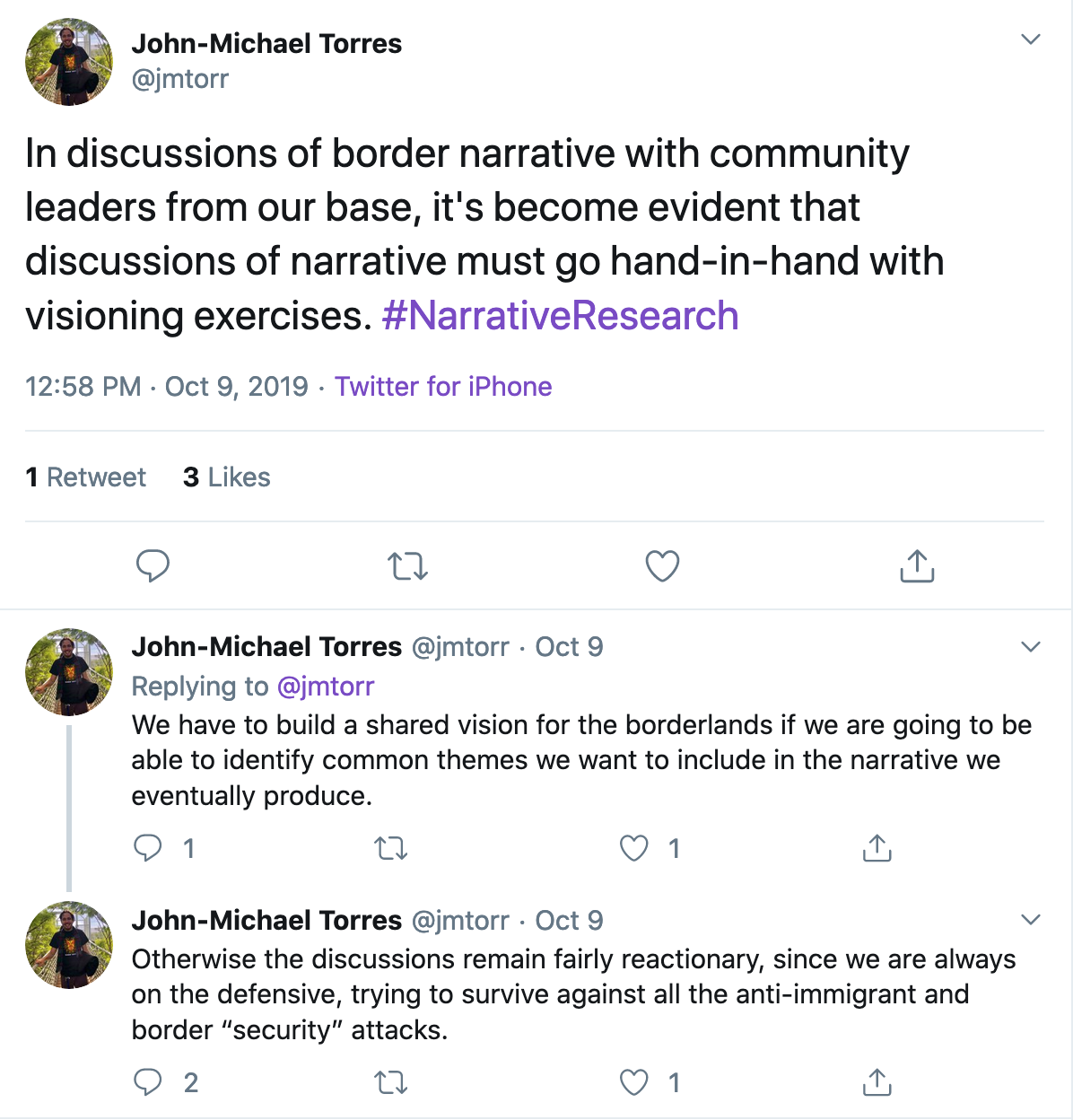
Tweet by John-Michael Torres on the value of collaboratively creating a narrative vision.
Emergent research methods offer sophisticated but unevenly distributed insights
We identified several emergent research methods. These methods respond to the complexity of identifying what shapes narrative. Emergent tools also track how narrative moves in an information rich world of social media, 24×7 news, and microtargeting.
- Big listening tools that find and track keyword data among social media, online news, online audio and video and more.
- Layered social and language analysis looks for patterns, network relationships and cause-effect in communications. While big listening identifies trends, layered analysis looks more deeply to find intention, influence and impact.
- Narrative analysis looks for metaphors, terms and subject-verb-object patterns. Narrative analysis patterns may reveal depth of narrative use and shift.
- Topos TalkBack is a proprietary messaging analysis approach that compares intent with people’s understanding and use of communications.
We also identified more standardized communications and messaging research methods that support and inform narrative work:
- Academic Literature Review
- Behavioral Science
- Cultural Models Research
- Field Testing
- Language Analysis
- Market and Political Research Standards (dial testing, polling and focus groups)
- Neuroscience
- Participatory Action Research
Interviewees identified discrepancies in access to all research methods. Training and capacity use the right research tools is uneven. Groups may misuse research (or avoid it altogether) when not knowing what methods to use, how to deploy research, how to interpret findings, and where to access support and more.
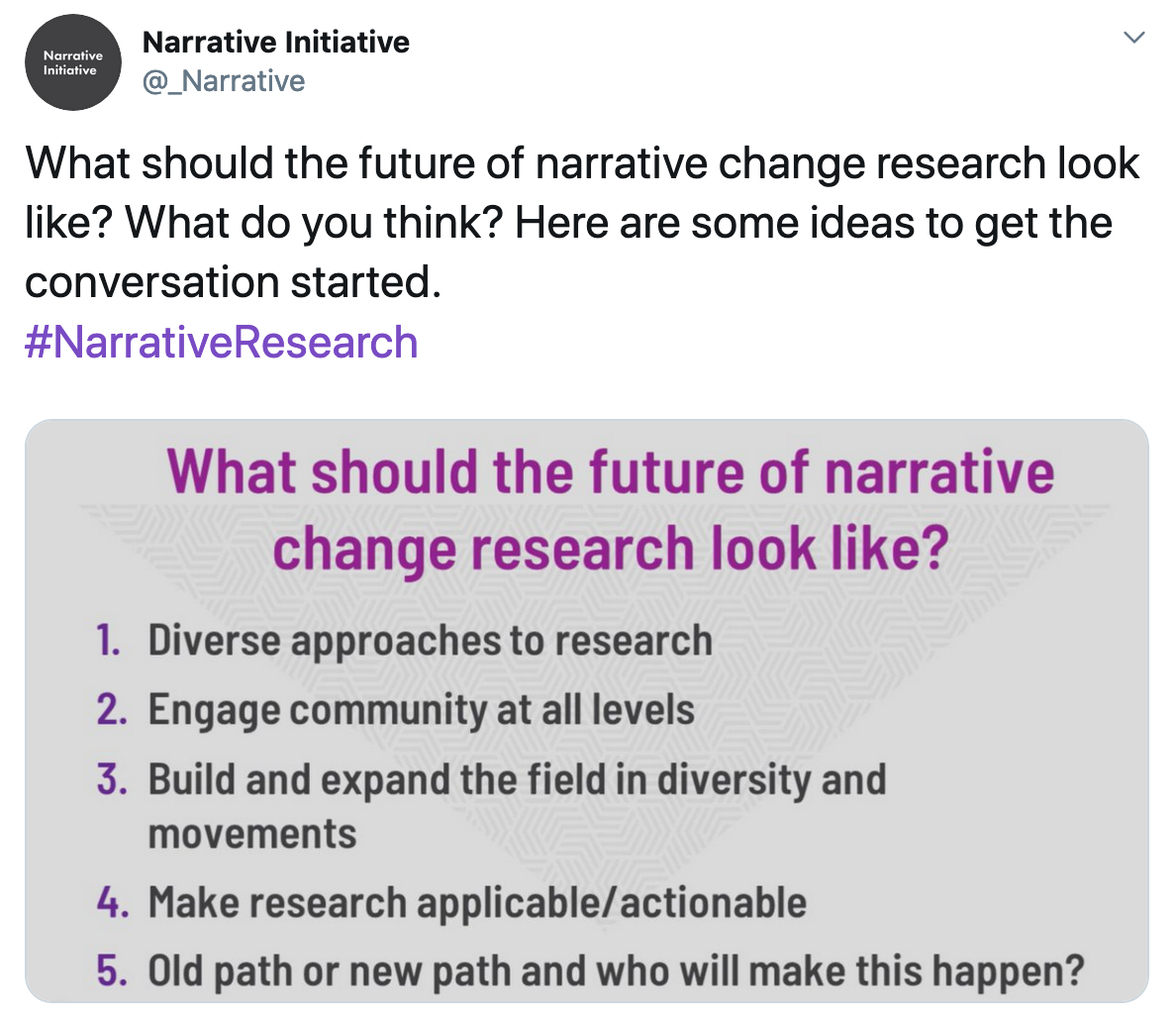
Tweet about the future of narrative research by Narrative Initiative .
Ten Pathways Forward
Access to research tools and findings is uneven. Emergent tools are advancing findings but they’re typically unavailable to much of the field, especially frontline and grassroots groups.
What do we do now? This is where researching narrative research methods gets into the field-building (or norming) phase. The field is looking for coherence, ethical standards, and consistently communicated information. Together, these are the stakes in the ground that map out the field, create expectations, and allow people to step in and work together.
We identified ten pathways that build capacity in organizations and scale the field. Each expands ability, access and reach. In combination, they serve as force multipliers that help narrative change practitioners better collaborate, access skills and use the right tools at the right time.
Do more education and capacity building – and expand access to narrative change research methods. This is especially critical for community activists and frontline groups.
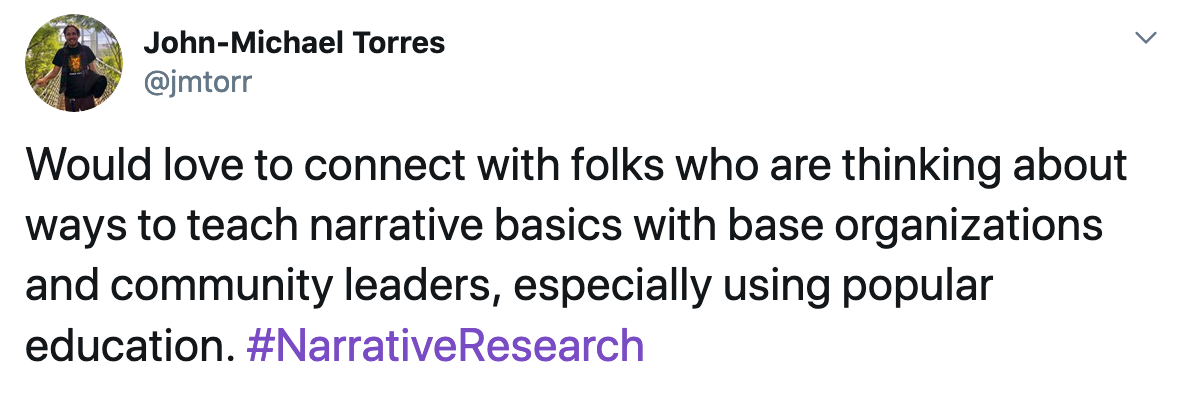
John-Michael Torres tweets about collaborating on narrative research .
Talk to people in the field. Don’t rely on polling and quantitative social media analytics gathered in the back office.
Focus on persuasion and action. Not just engagement. Building lists is relatively fast and easy. And of little use if you can’t go deep to change behavior. More persuasion research, please.
Embrace the role of culture change. Culture locks (and unlocks) the collective imagination. We need to see more, better, and more accessible research into how culture change works and how cultural narratives shift politics and policy.
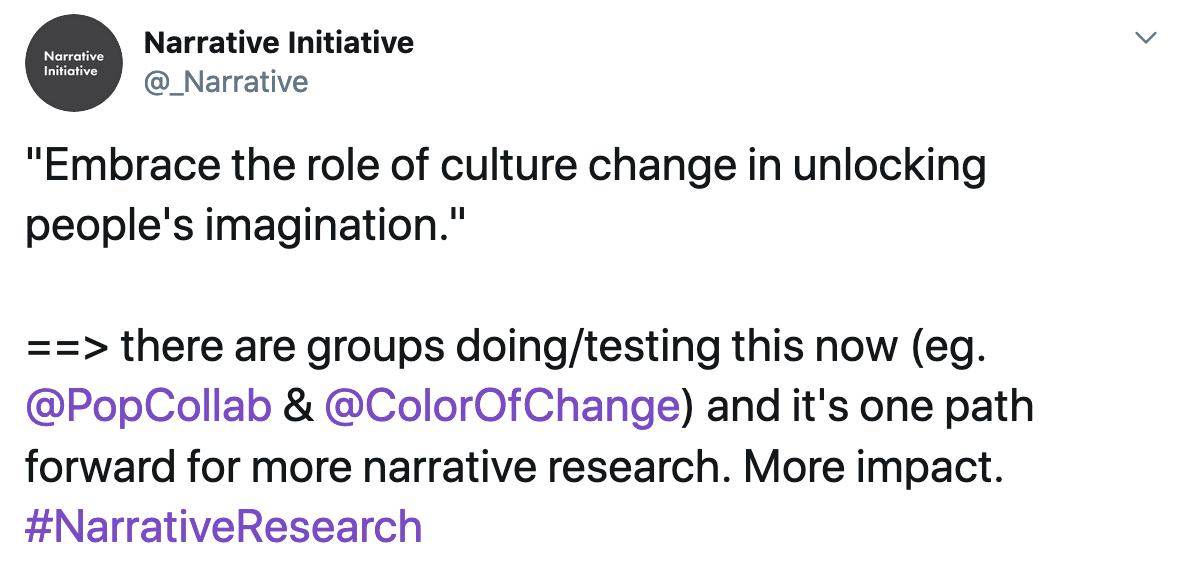
Narrative Initiative tweet about the need to do and share more research into the intersection of culture and narrative.
Do more research collaboration across social justice movements. Narrative change is long-term and multi-issue. For example, people consider many factors when acting (or choosing not to act) on economic inequality. Race, employment, and education are just a few issues that can’t conduct narrative research in isolation if we’re to shift deep economic narrative.
Improve equity and representation. Some interviewees told us that people of color face unique hurdles securing funding for narrative change research. One put it this way: “funders don’t trust black ingenuity.” This isn’t just about funders. People and groups working in the field can advocate for more equitable funding and diversified research.
Create ethical standards to help demonstrate coherence across the field. Polling, for example, is a widely used but seen as unreliable and a source of inequity when doing narrative research in frontline communities.
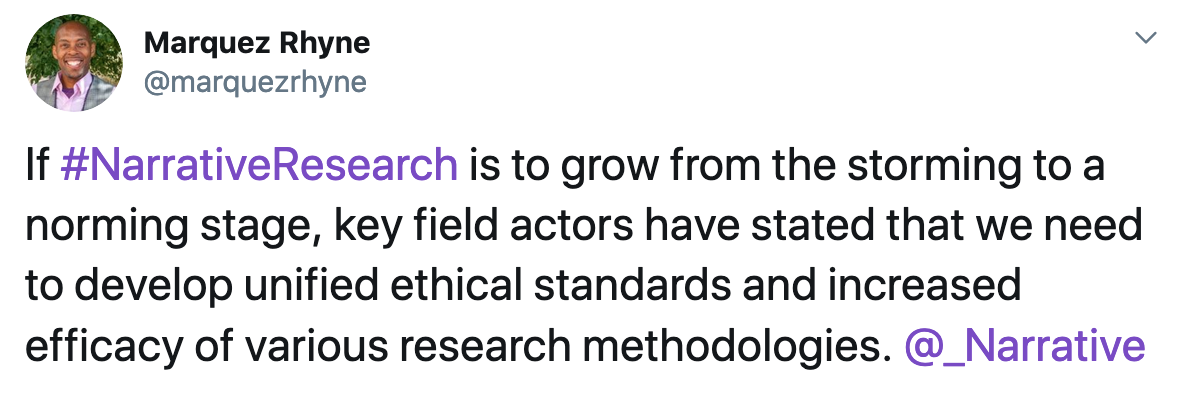
Márquez Rhyne , a lead on the narrative research project, on the value and role of ethical standards for research .
Advance research education and capacity building. Identify the people and groups who do research education and capacity building. Note the gaps. Support efforts to expand the number and reach of capacity builders.
Strengthen the capacity of organizations to do their own research. Narrative research often happens in academia, think tanks, or groups disconnected from practitioners. Doing narrative research in impacted communities, in real time, and making findings available could be a gamechanger.

Building the capacity of frontline groups to conduct and share narrative research could be a gamechanger . Tweet via Narrative Initiative .
Shift legacy funding patterns that result in unequal access, duplicative work, competition between groups, and disincentives to long-term research.

What’s Next
The choice of narrative research methodologies and insights gleaned from research have direct impacts on the efficacy of narrative change strategies. Research methods will continue to be limited until the field expands the capacity to perform and share research and puts research tools and training in the hands of more groups doing frontline work.
We look forward to taking the findings of this report to practitioners and other stakeholders in the field. These findings and ongoing conversations will help shape recommendations and outcomes that may benefit narrative change practice for years to come.
Big ideas in your inbox.
Narrative Report

As a student you have had countless encounters with report writing . These papers is no longer shocks you but in the midst of your paper writing, you have always come to a point where your don’t know how to write the academic paper, how to start it, what should be included and what should be excluded; before you even get the chance to begin you’re already facing a dilemma.
What is a Narrative Report? A narrative report is a detailed illustration of an event that has occurred in chronological order. Simply put, it is a detailed chronological piece of writing. It is comparable to that of a police report . Meaning, a narrative report presents things or events that has happened in the past through a logical progression of the relevant information.
The main purpose of a narrative report is to present a factual depiction of what has occurred. A strong attention to detail is used in order to accurately shed some light on the things or event that happened. A narrative report is commonly used in the legal or justice system. This report is written when resolving disputes, filing complaints, or as a piece of evidence in case settlements.
This report adheres and focuses on the five W questions — Who? Where? When? What? and Why? Since this report is used as evidence, those questions are addressed and answered along with the evidence necessary to prove such answers. Each question must be comprehensively answered and even the smallest details should be provided. In addition, the assumptions made on the report must be based on verified facts or evidence. If you fail to do so, your report might lose its value or your credibility as a writer.
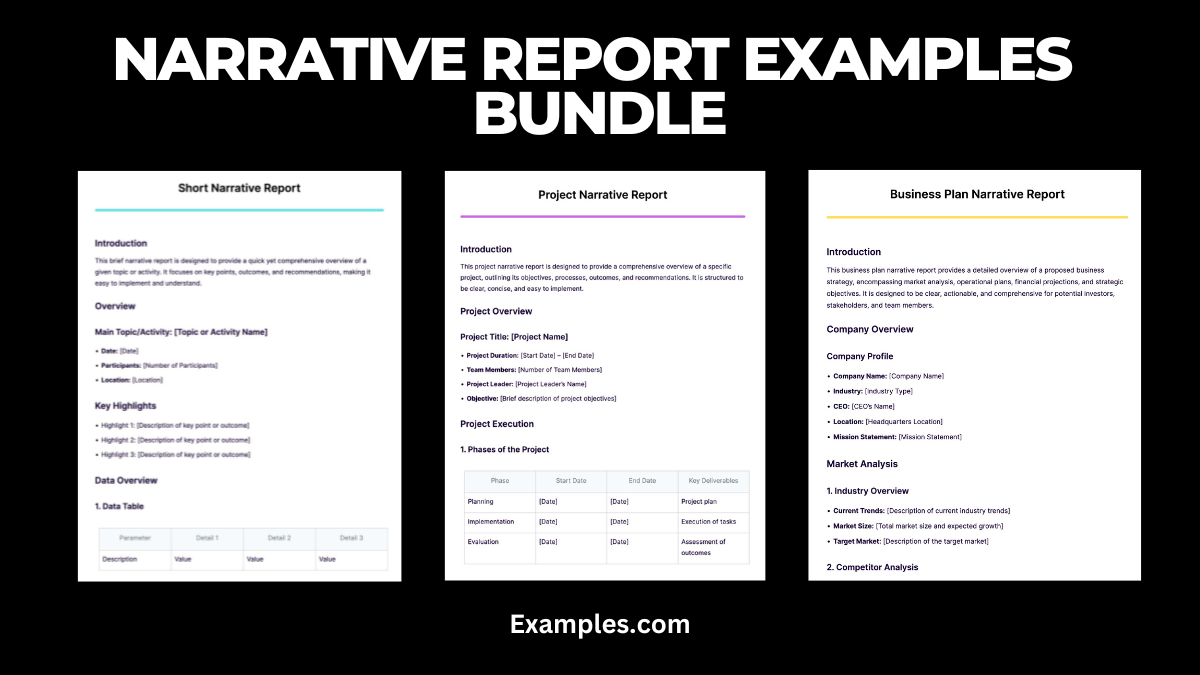
Download Narrative Report Bundle
As they say, students eat essays and reports for breakfast, therefore, this is not something new to you. Your teachers will require you to write essays or reports regarding a certain topic or circumstance with at least a thousand word count and even though you’re used to writing these documents it can still be a difficult task. You may also see consulting report examples.
Essays and reports are just some of the most common documents written while in the academe. It explores the students’ ability to logically examine another document and make a sensible judgment. Not only that, it also enhances the students’ thought process, writing skill and organization skills.
Narrative Report Format
This is the front page that displays the report’s title, the author’s name, and the date of the report. It provides a clear identification of the report’s content.
Introduction
This section sets the stage by providing background information and stating the purpose of the report. It gives readers context and helps them understand what the report will cover.
Context: Details the setting and circumstances of the events or the situation being reported. This part paints a picture of the environment and conditions under which the events occurred. Events: Narrates the actual events in the order they happened. This chronological detailing is crucial for clarity and coherence in the report. Personal Reflections: Here, the author includes their thoughts, feelings, and insights about the events. This section adds depth and personal perspective to the report.
Wraps up the report by summarizing the events and discussing their outcomes, implications, or lessons learned. It brings closure to the narrative.
Example of Narrative Report
Title: Science Fair Experience 2024 Introduction: This report describes my experience participating in the Regional Science Fair 2024, held at Lincoln High School. Body: Context: The fair was held on March 15th, 2024. Participants from various schools presented projects on environmental science. Events: My project was on ‘The Effects of Urbanization on Local Bird Populations’. I detailed my preparation, the research process, and how I interacted with attendees and judges during the fair. Personal Reflections: I reflect on the challenges faced during project preparation, my learning experience, and the satisfaction of presenting my research. Conclusion: The science fair was a rewarding experience that enhanced my research skills and increased my interest in environmental science.
1. Short Narrative Report Example
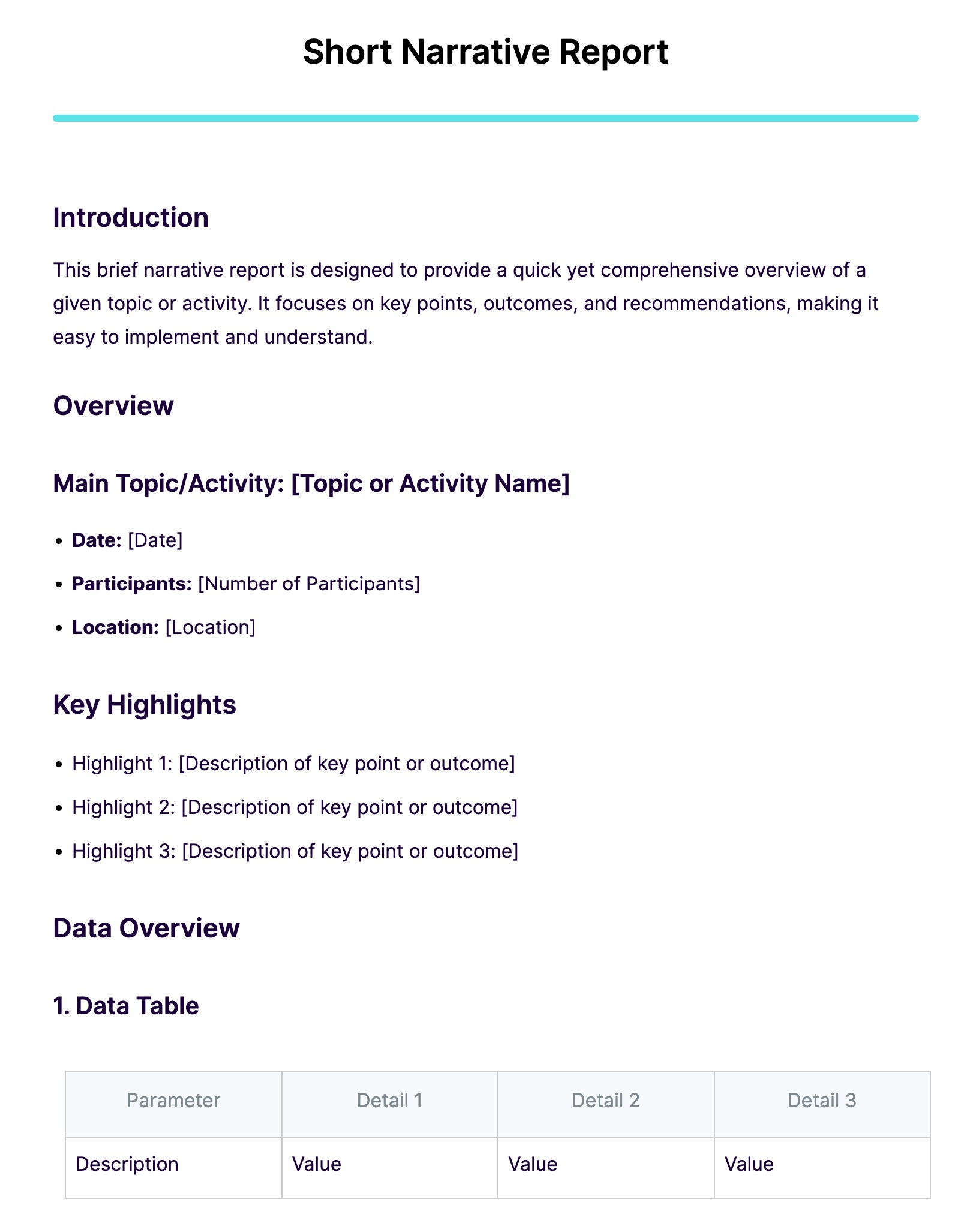
Free Download
2. Project Narrative Report Example
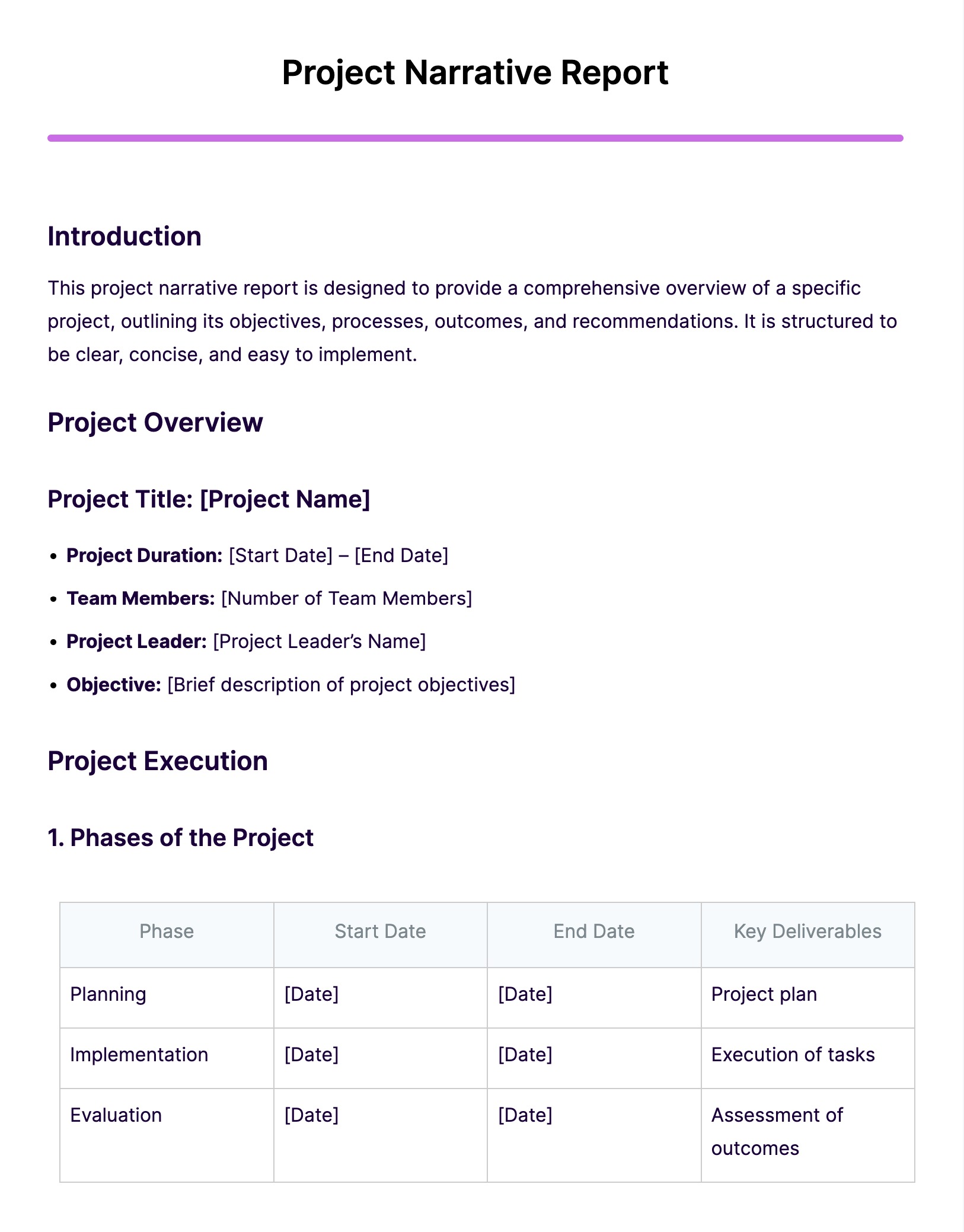
3. School Narrative Report Example
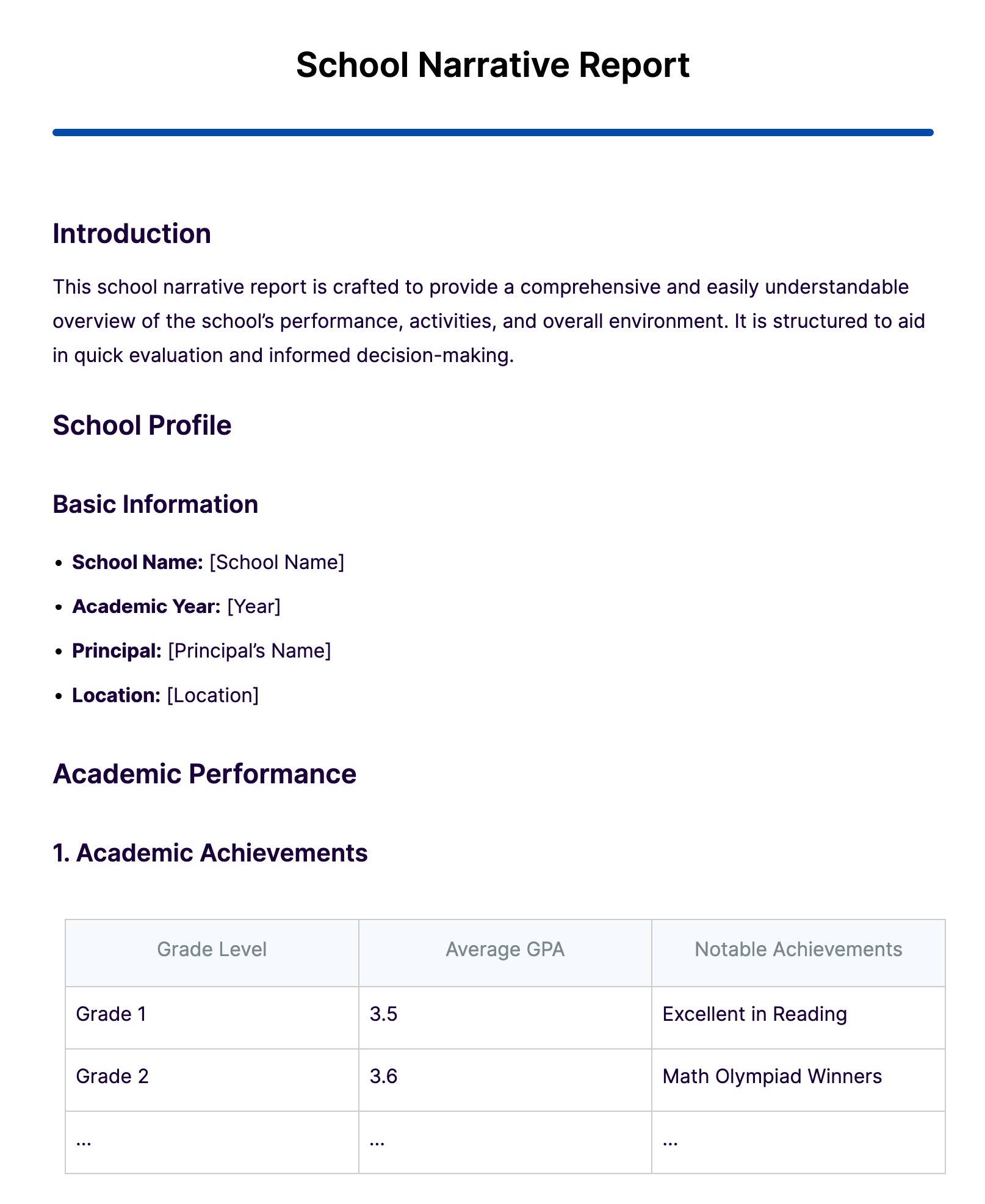
4. Business Plan Narrative Report Example
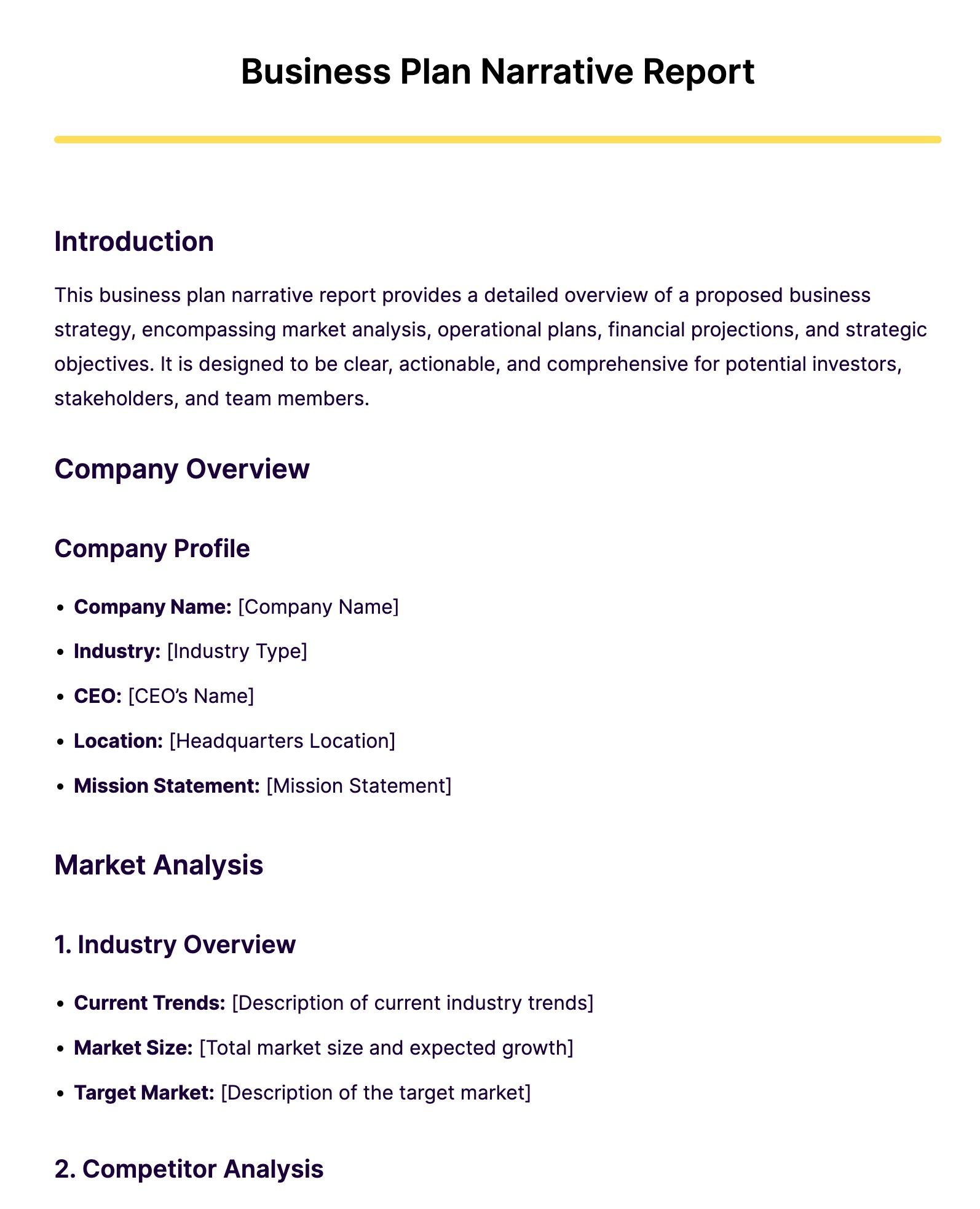
5. Example of Narrative Report Template
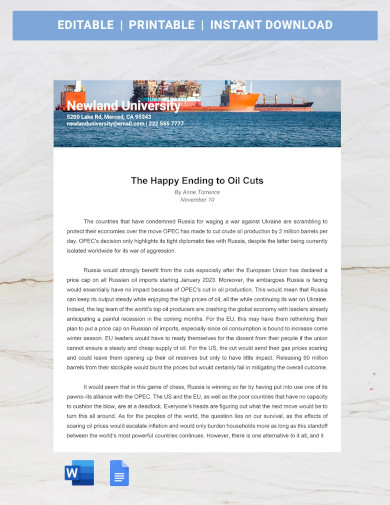
- Google Docs
Size: 57 KB
6. Business Plan Narrative Report Template
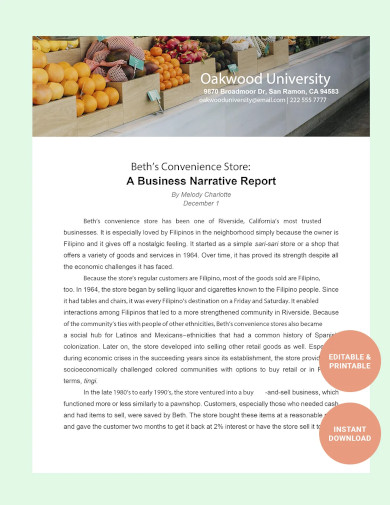
Size: 54 KB
7. Narrative Appraisal Report Template
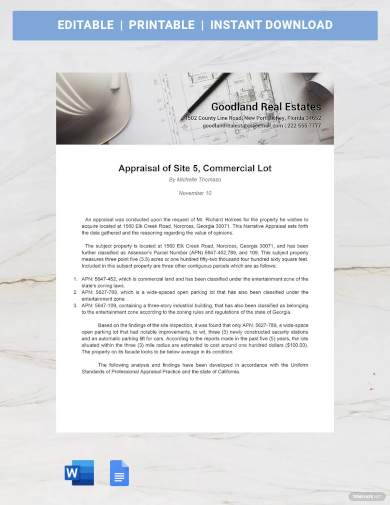
Size: 161 KB
8. Narrative Progress Report Template

Size: 160 KB
9. Narrative Report Format Example
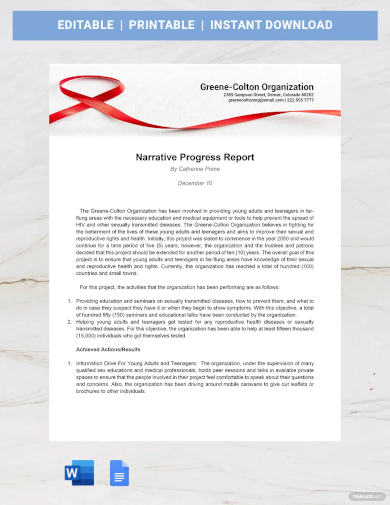
10. Monthly Narrative Report Template Example
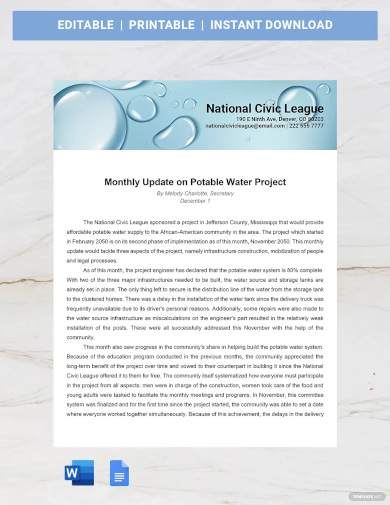
Size: 169 KB
11. Financial Narrative Report Template Example
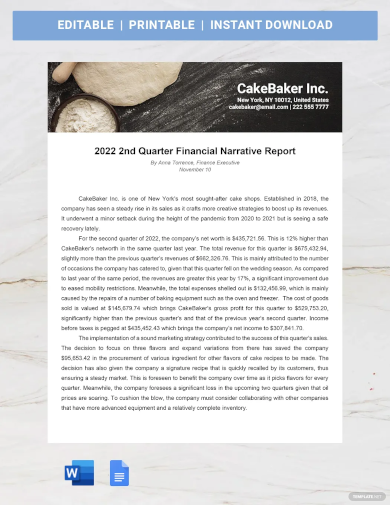
Size: 190 KB
12. Project Narrative Report Template Example

13. Business Narrative Report Template

Size: 180 KB
14. Narrative Report Template Example
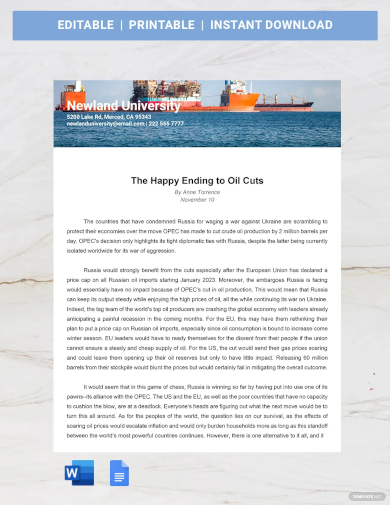
Size: 191 KB
15. Free Sample Narrative Report Template
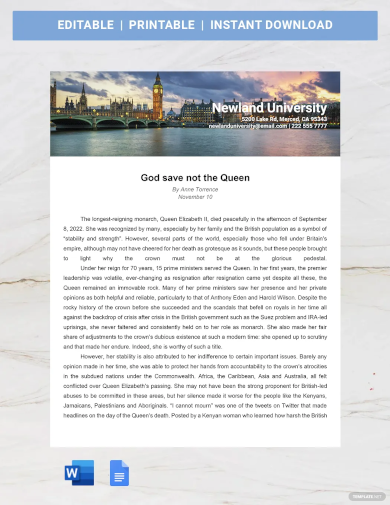
Size: 196 KB
16. Annual Narrative Report Template Example
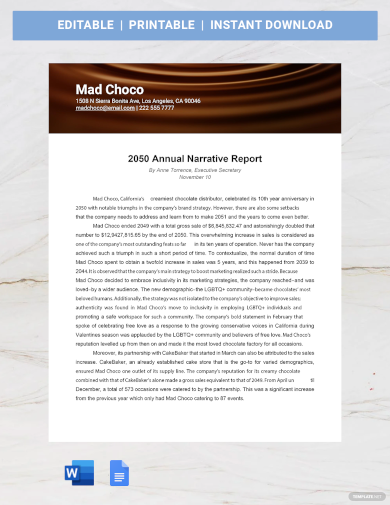
17. Final Narrative Report Template Example

Size: 200 KB
18. Narrative Report Example for Students
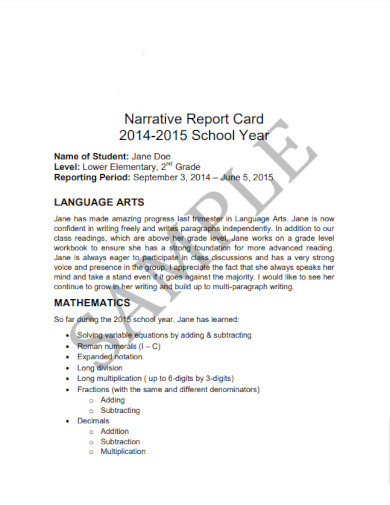
oakcrestacademy.org
Size: 252 KB
19. Student Narrative Report Example
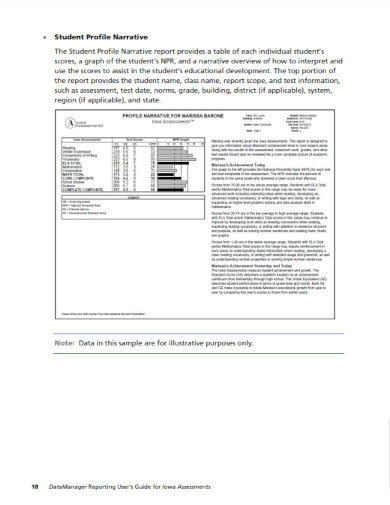
s3.amazonaws.com
Size: 209 KB
20. Narrative Report with Documentation
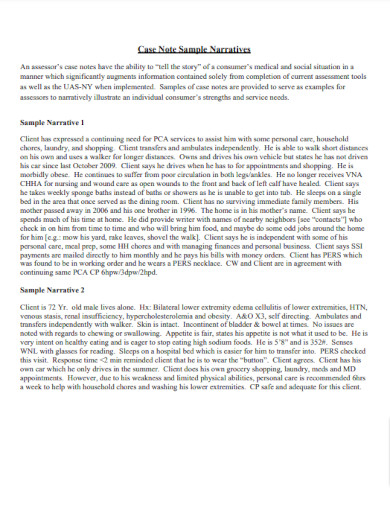
health.ny.gov
Size: 16 KB
21. Narrative Report For Work Example
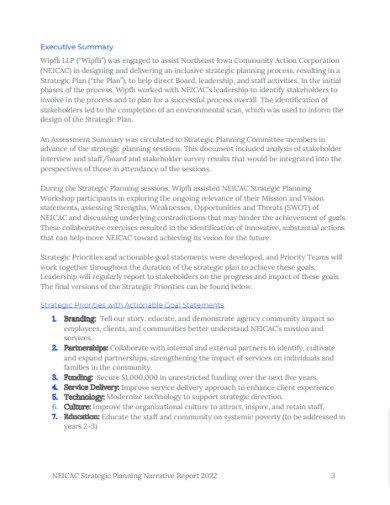
22. Construction Narrative Report Example
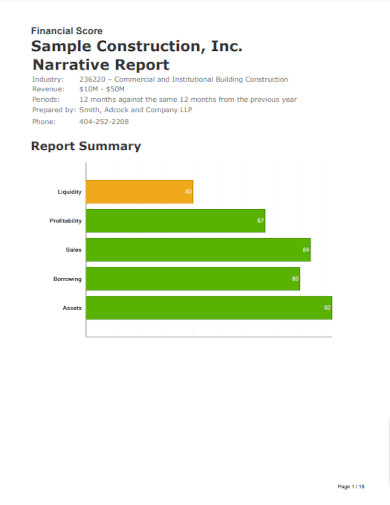
smithadcock.com
Size: 649 KB
23. Basic Report Writing Example
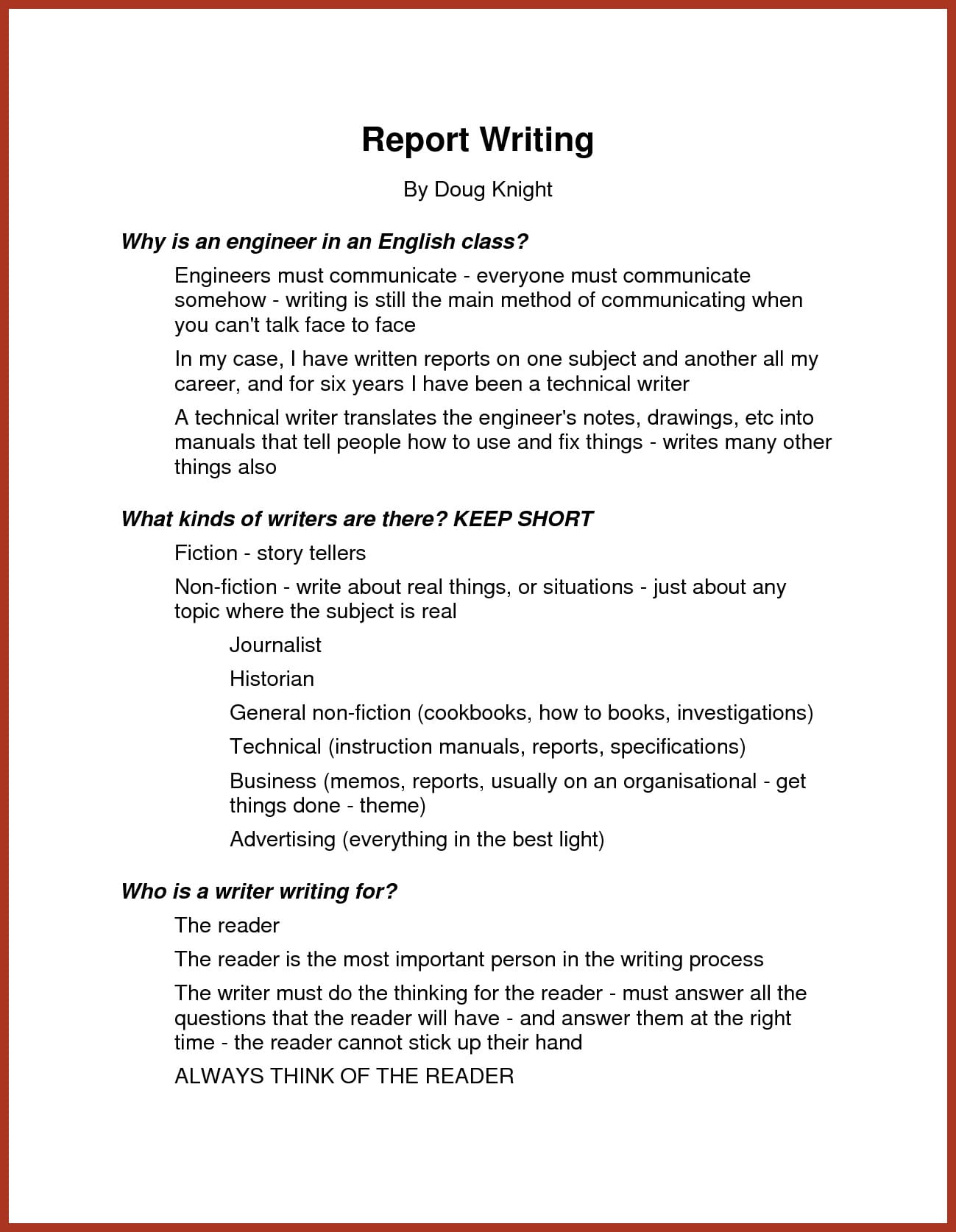
Size: 164 KB
24. Sample Police Narrative Report Example
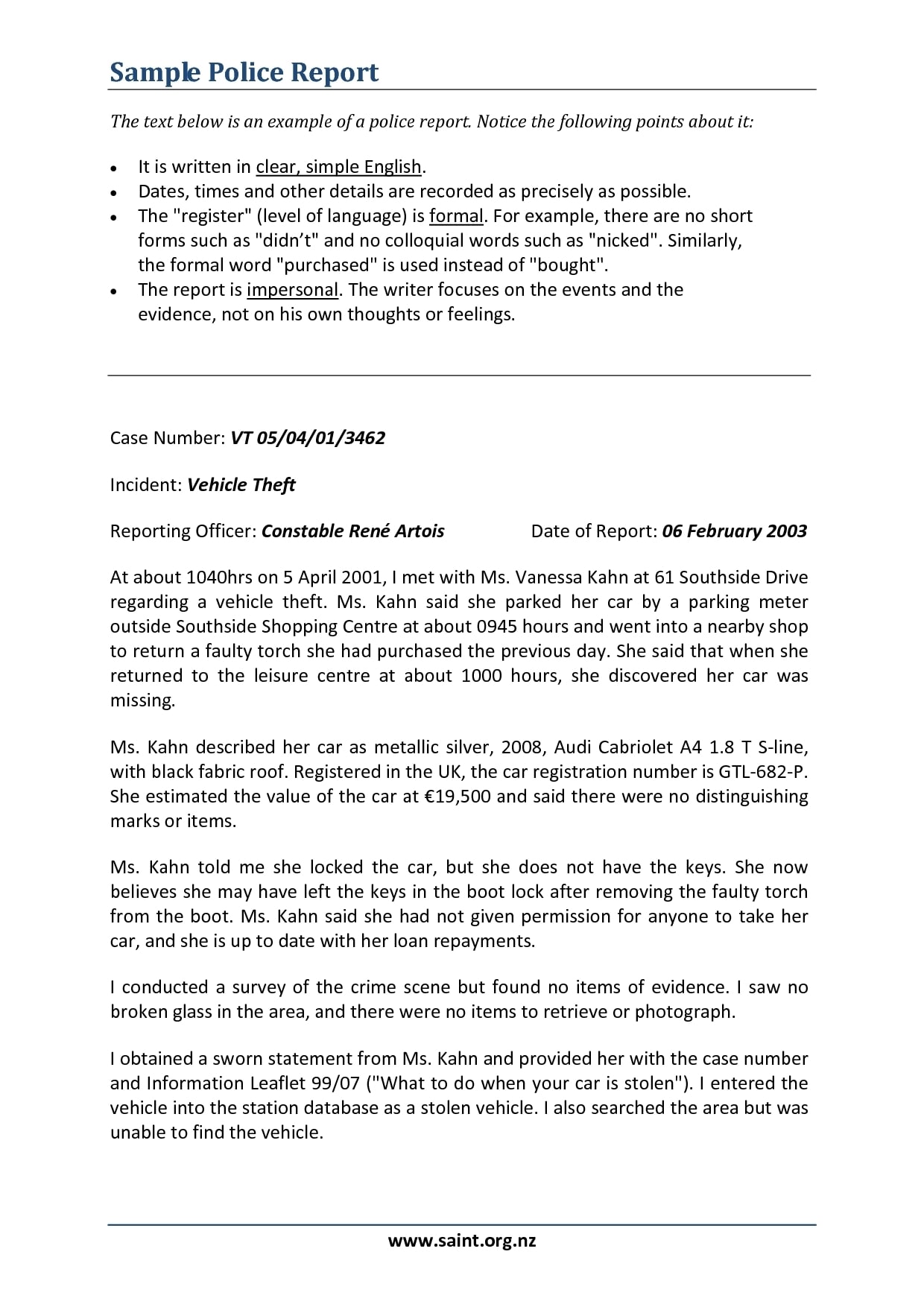
Size: 235 KB
Compare and Contrast: Essay and Report
Before this guide even starts to discuss all about a narrative report, it is important that you understand that an essay and report are not the same. Here is a list of the differences and similarities of an essay and a report:
1. Differences
- Essays give you more opportunity to expand on possibilities, ideas or concepts; this means essays can explore more hypothetical situations. On the other hand, simple reports deal with describing and/or analyzing real past events; it can be written to make predictions or recommendations for the future.
- Essays content flows without breakage meaning the organization of thoughts are only divided by paragraphs but still has continuity into it.
- Reports are usually divided into sections, headings and sub-headings. Illustrations, diagrams, attractive charts, tables, etc. are also used in a formal report .
- Reports can be presented orally while essay are usually submitted in a written or printed document.
- Essays are usually written in the third person while reports can use either first or third person.
- The usage of bullet points in a report is very common while it is not common in an essay.
- A Recommendation for Action section is included in a report but is very unusual in an essay.
2. Similarities
- Both have one or more central point to focus on and given emphasis. You may also see marketing report examples.
- Both can include references however they vary in the method for citing such references.
- Both should definitely include an introduction and conclusion.
- Both are comprehensively structured and has a logical progression of ideas.
- Although they use different method, both have text broken into readable chunks. Sections for reports, paragraphs for essay. You may also like management report examples.
- Only one key point is discussed in every report section or essay paragraph.
- Uses language suitable for their expected audience and is accepted in conventions of writing.
25. Free News Report Narrative Example
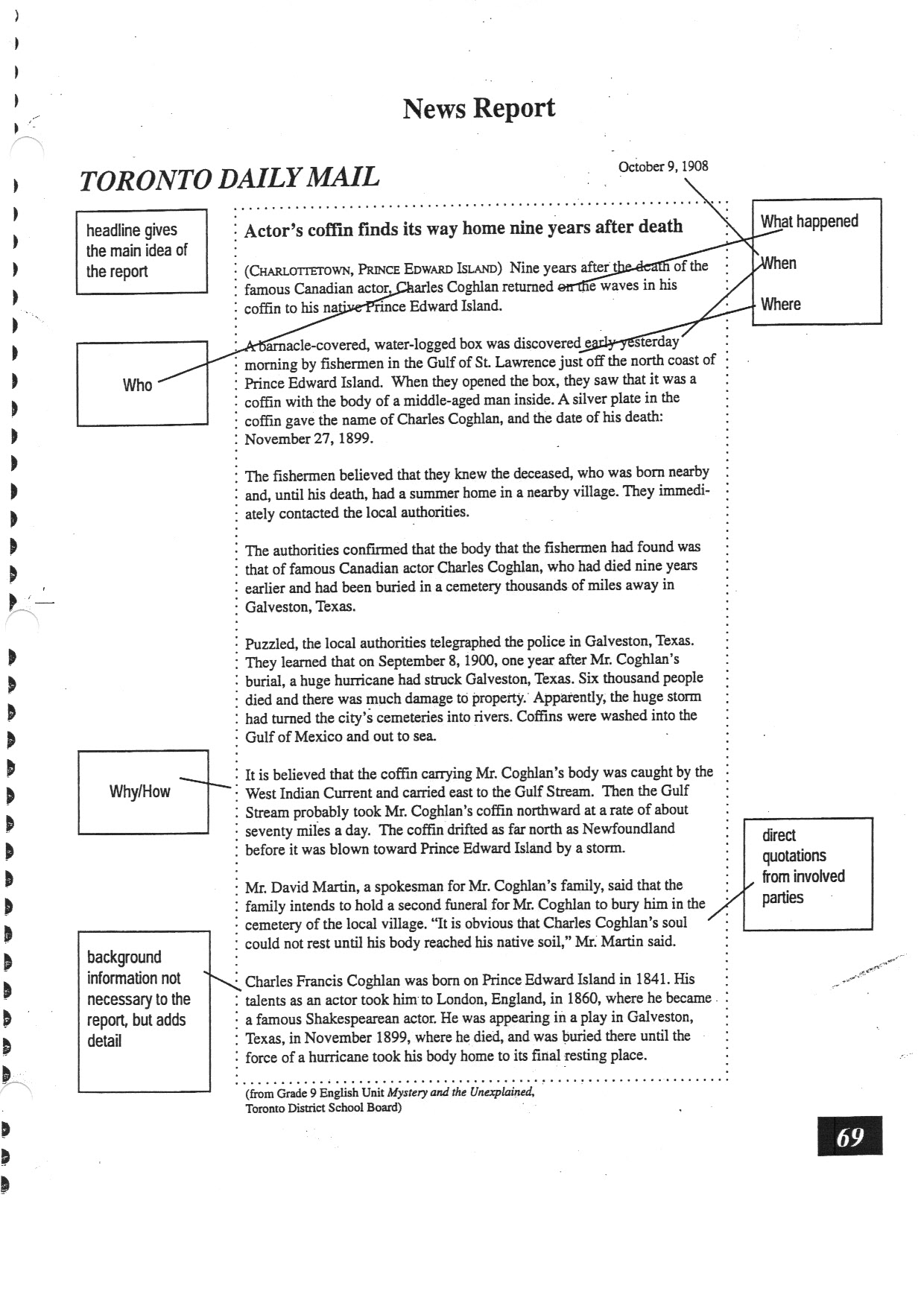
Size: 281 KB
26. Narrative and Financial Report Example
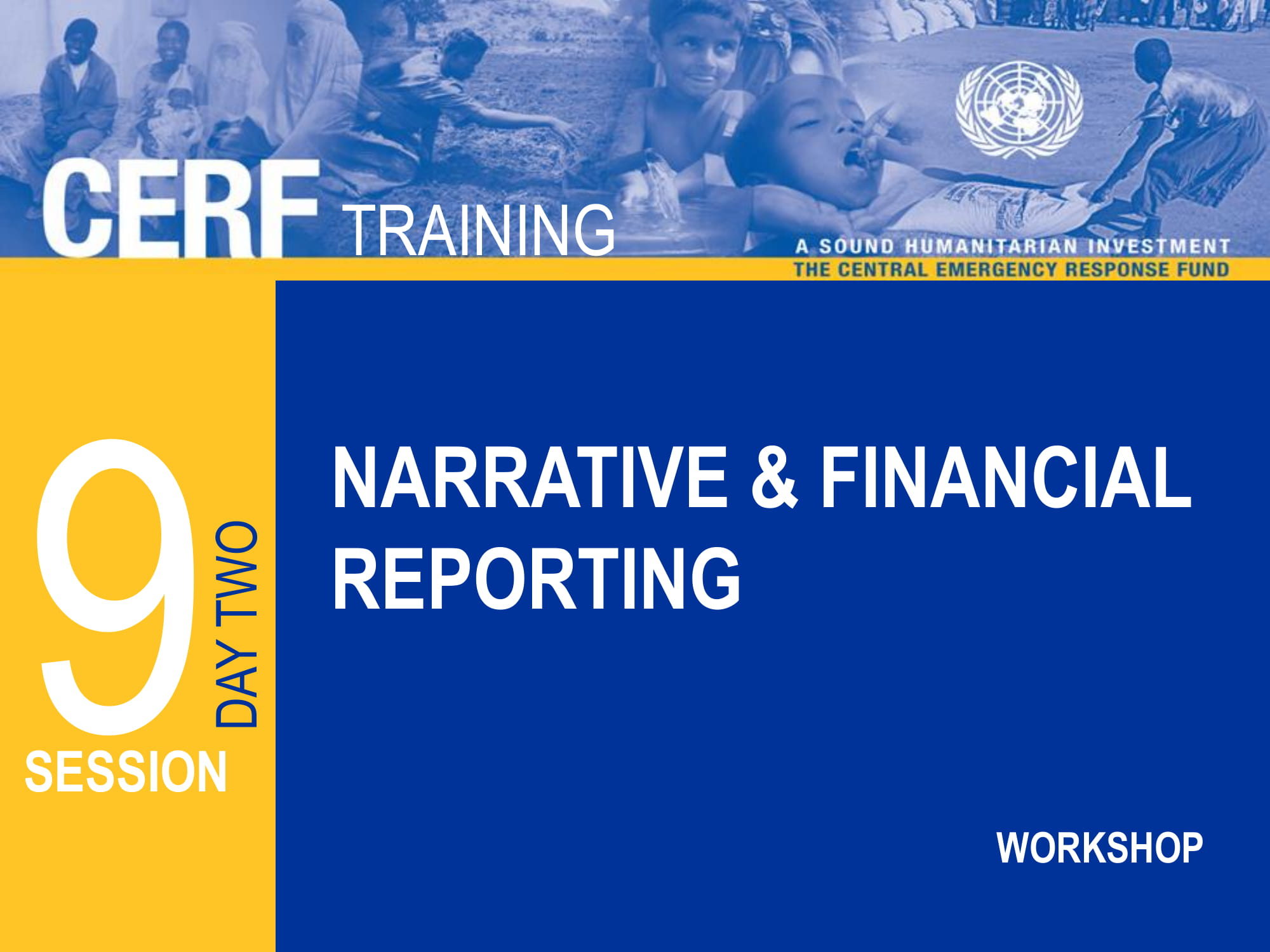
Size: 225 KB
27. Summer Camp Narrative Essay Example

apessay.com
Size: 264 KB
28. Direct Narrative Writing Example
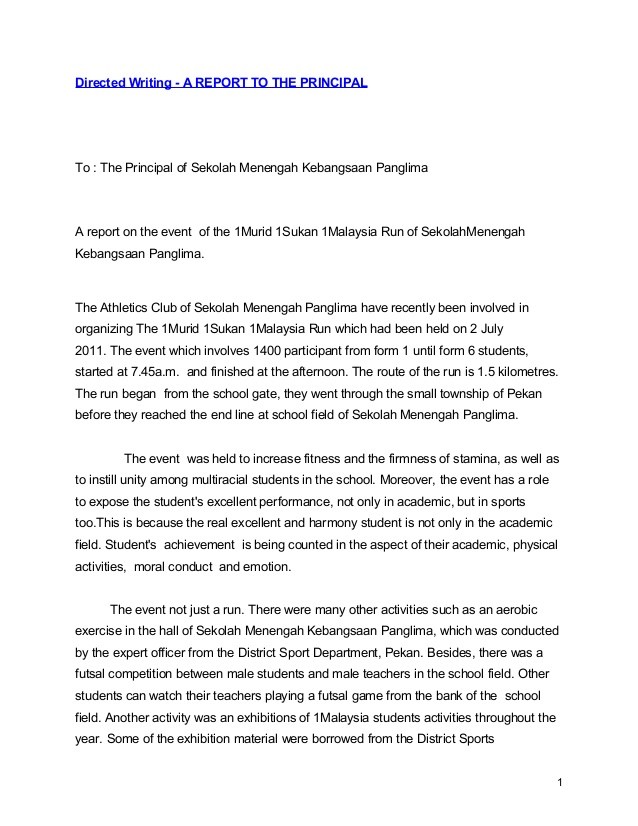
prithirajrestaurant.com
Size: 88 KB
29. Book Report How-To Example
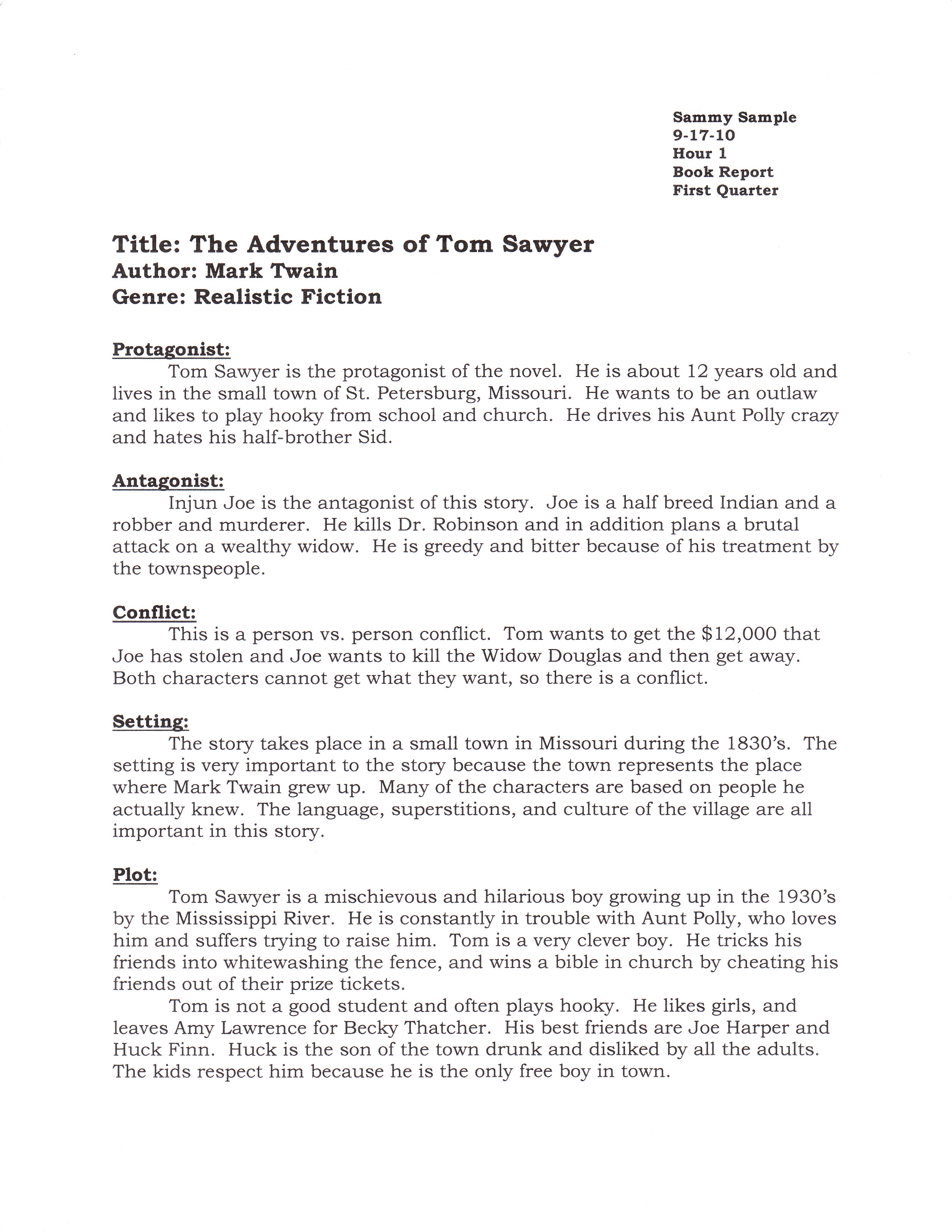
Size: 682 KB
30. Final Project Narrative Report Example
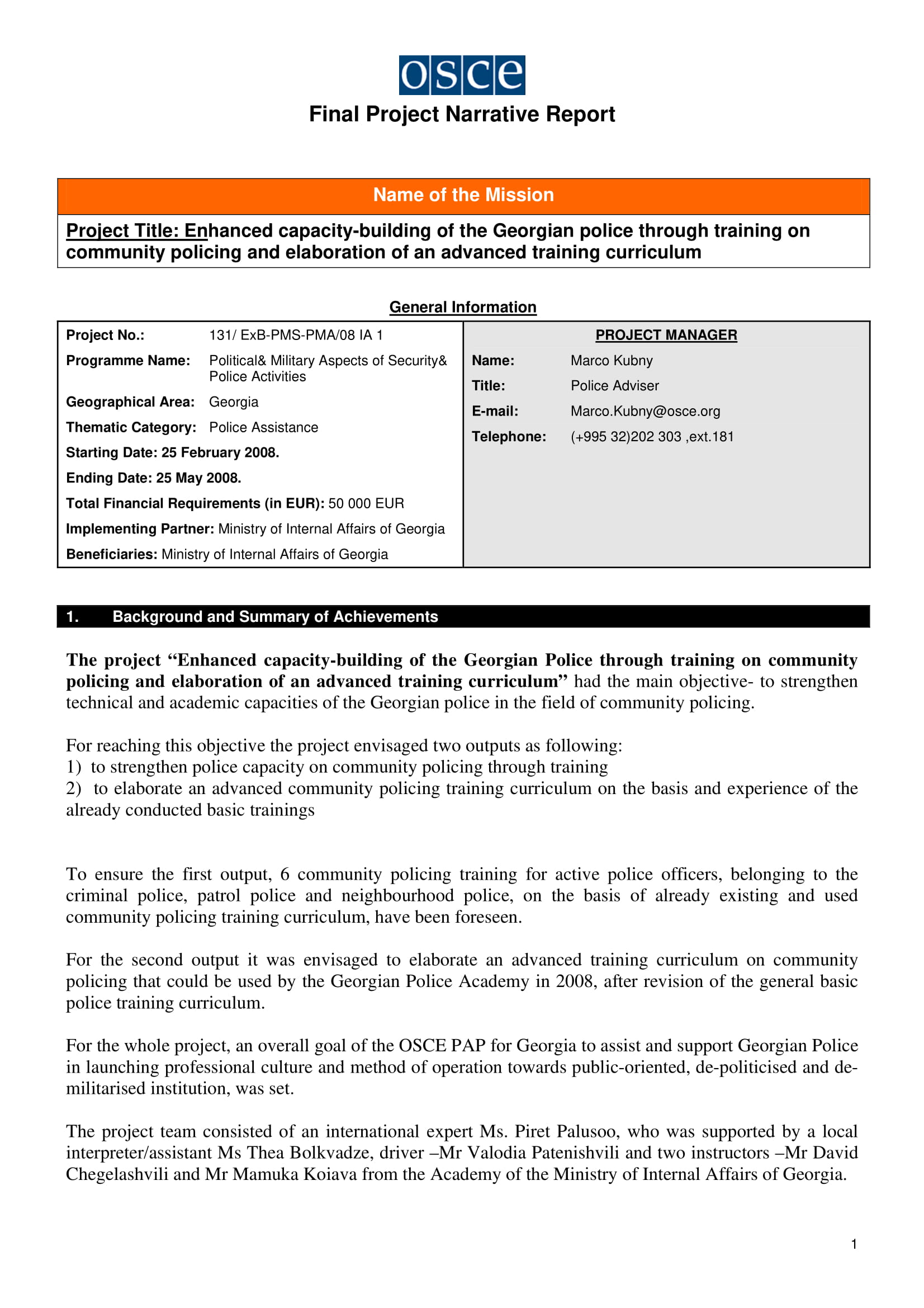
Size: 343 KB
Contents of a Narrative Report
In order to ensure you have an effective narrative report, these parts or contents must be found in your document. However, these are only the general sections found in a narrative report, the specific parts are up to the requirements of your course or professor. Listed below are the relevant contents of a narrative report:
1. Introduction
Th introduction of your narrative report must provide a short description of the report topic. This is the first section of the report that needs a thesis like general statement to convey what the rest of the report is going to talk about. Just like in any writing piece, a the introduction should be able to briefly but still accurately state the main point the report is trying to make.
For example, when writing a report about the end of collegiate term, you can start the introduction of your report with when you started and what you learned.
2. Knowledge or Learning Acquired
This section of the report contains all the relevant information to your main topic. In the given example above, you can write about what you have learned through the entire term in this section. You can talk about anything that you have actually learned however it must be presented in a nonfiction format. Since the a narrative report is solely based on facts, the information you should include must be truthful as well. You may also see recruitment report examples.
3. Observations
In this section, the things you have observed and the things you have learned through observation is stated. This is basically the art where you recount all of your observations during the period the topic of your report occurred. This can be lengthy or short depending on the amount and depth of the observations you want to expound on. Most of the time, this can be based on a person or activity you have observed and learned from. You may also like monthly report examples & samples.
4. Recommendations
In the recommendations section you focus on concluding what has been discussed in the previous sections. This section can also be used to express what can be done to improve certain activities or events you have attended. Say for example, a narrative report can be done on a seminar you have attended and this section can state how better quality hand-out could help the audience understand the topic more or other changes to improve your learning experience. You may also check out research report examples.
As mentioned beforehand, these are some of the most common parts in a narrative report. Depending on the requirement for your course or guidelines set by your professor, these sections can still have more. For example, a narrative report can also have objectives section, accomplishments and challenges section, description of activities, analysis and evaluation, etc.
31. Final Narrative Report Guidelines Example
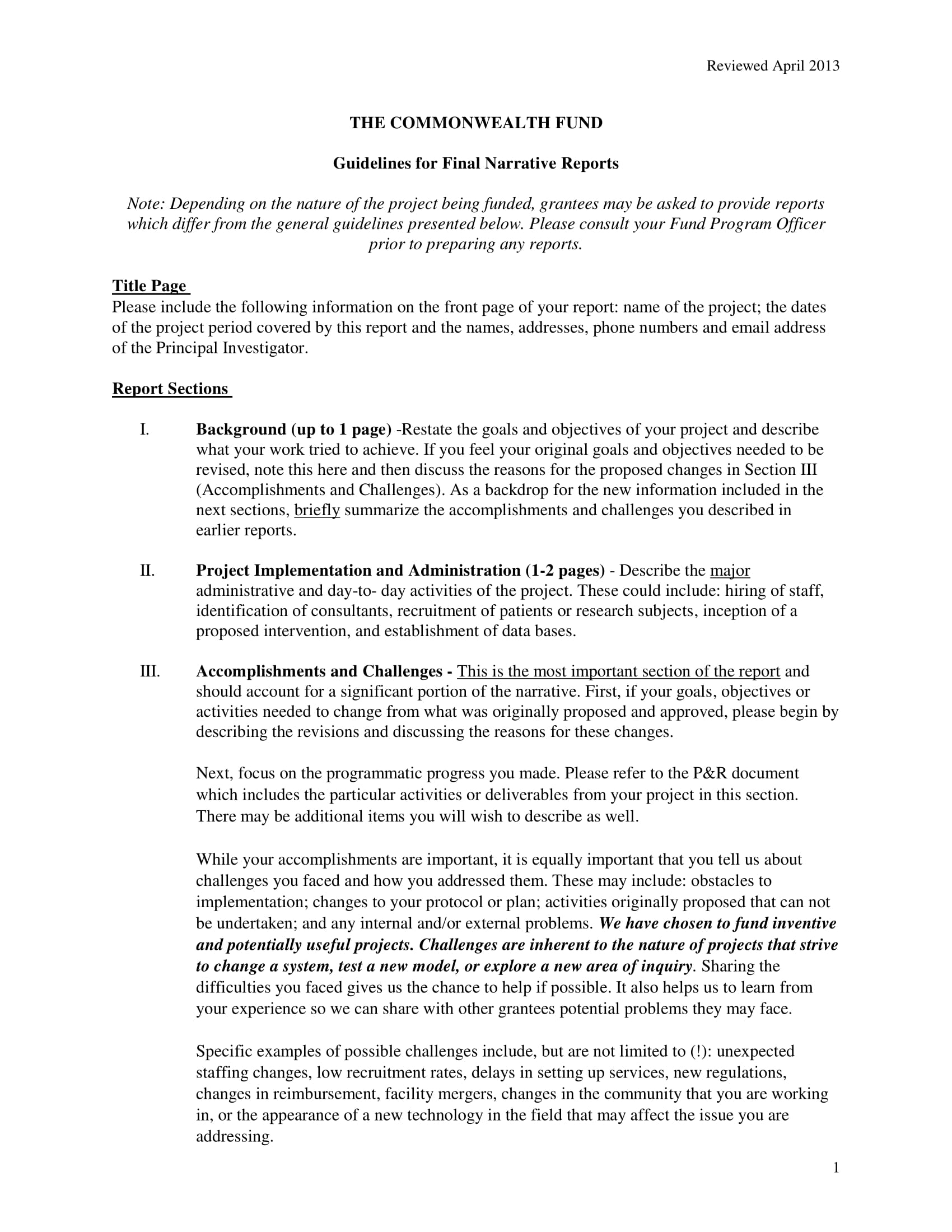
32. Seminar Narrative Report Template Example
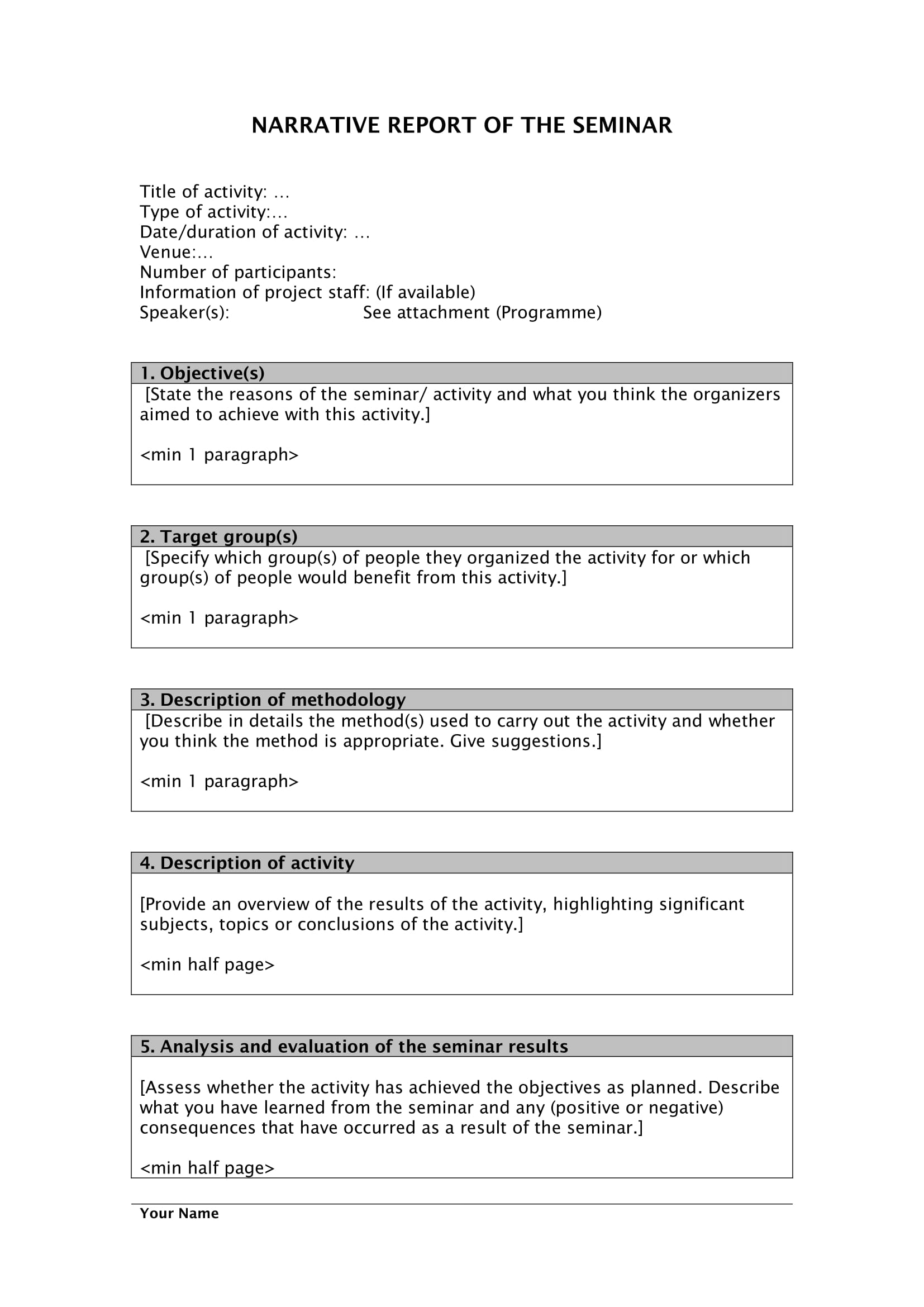
Size: 187 KB
33. Joint Program Final Narrative Report Example
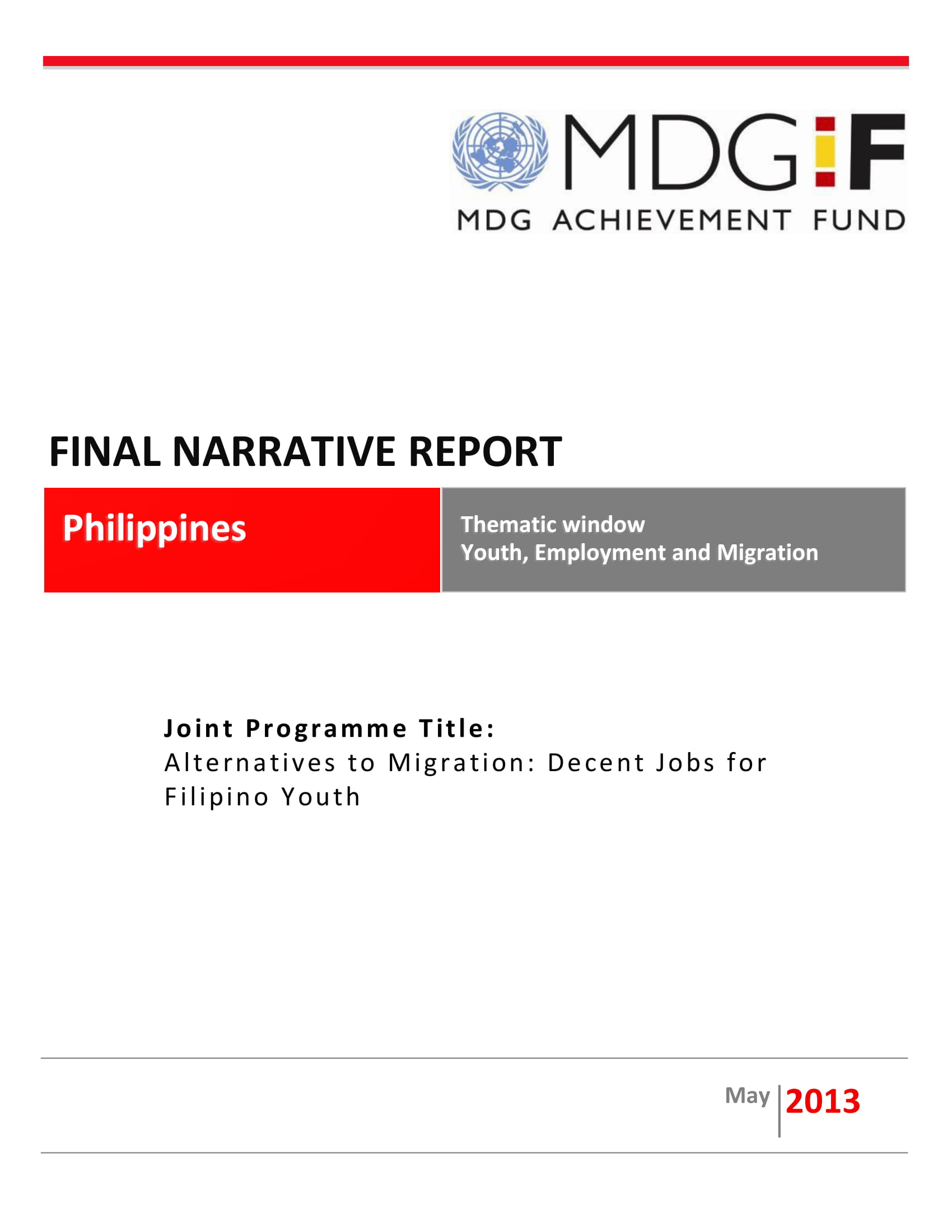
Size: 114 KB
34. Behavioral Health Index – Multimedia Version Narrative Report Example
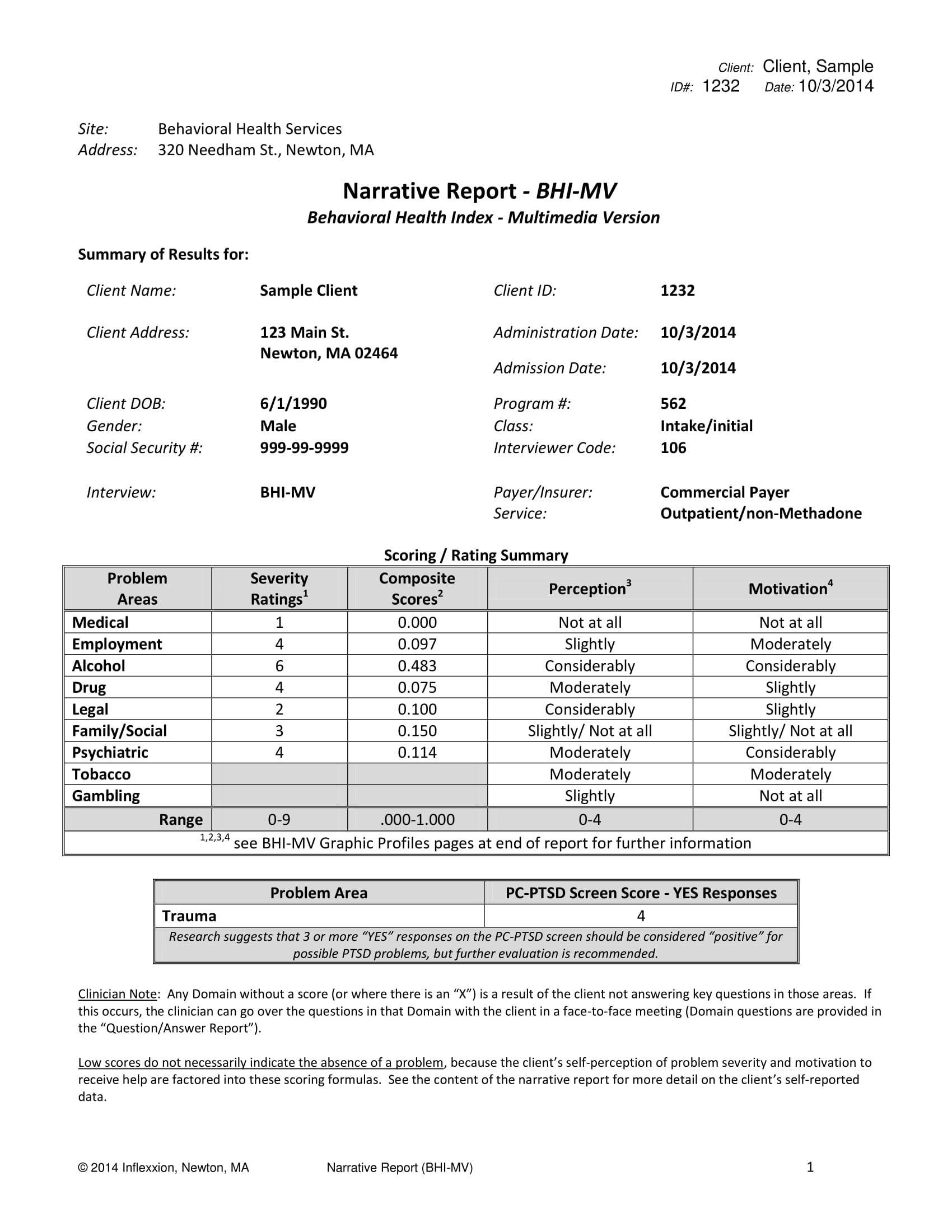
Size: 257 KB
Tips for Effective Narrative Report Writing
Writing an effective narrative report requires a blend of storytelling and factual accuracy. Whether it’s a business, academic, or personal narrative, the key lies in presenting information in an engaging and coherent manner.
Focus on Clarity and Detail
Start by ensuring clarity in your narrative. Whether it’s an Internship Narrative Report or an Annual Narrative Report, your information should be precise and detailed. This helps in conveying the complete picture to your audience.
Engage with Storytelling Techniques
Use storytelling techniques to make your Monthly Narrative Report or any other narrative report more engaging. This includes setting a scene, building a narrative arc, and developing a compelling conclusion.
Use Visuals Where Appropriate
Incorporating visuals like charts and graphs, especially in complex reports like a Quarterly Narrative Report, can aid in conveying information more effectively. Visuals can break monotony and help in better data interpretation.
Maintain a Logical Flow
Ensure that your report, be it a Narrative Report for School Activities or a Narrative Report in Research Paper , follows a logical flow. This helps in keeping the reader engaged and makes the report more digestible.
How to Make a Narrative Report?
Creating a narrative report involves several steps, each crucial to crafting a report that is informative, engaging, and well-structured.
Collect and Organize Information
Begin by gathering all necessary information. If it’s a Business Narrative Report , this might include data on market trends, financial statements, and strategic developments. Organize this information in a way that makes sense for your narrative.
Write with a Clear Objective
Every narrative report should have a clear objective. Whether it’s to inform, persuade, or entertain, the objective should guide the tone and content of your report. This is particularly important in specialized reports like a Narrative Report for Seminars .
Edit and Refine
After drafting your report, take time to edit and refine it. This includes checking for grammatical errors, ensuring coherence, and verifying facts. A well-edited Academic Narrative Report or any other type of narrative report is more credible and effective.
Include a Call-to-Action
If appropriate, conclude your report with a call-to-action. This is especially relevant in reports like a Grooming Narrative Report , where you might want to encourage specific behaviors or responses from your audience.
How to Write a Narrative Report?
Writing a narrative report involves conveying information through a story-like format, making it more engaging and memorable for the reader.
Crafting a Compelling Introduction
Begin with an introduction that sets the stage. For a Narrative Report in Research Paper , introduce your topic and research objectives clearly.
Developing a Clear Narrative
Structure the body of your report in a logical sequence. In an Internship Narrative Report , narrate your experiences chronologically, highlighting key learnings and observations.
Using Descriptive Language
Employ descriptive language to bring your narrative to life. This is particularly effective in a Narrative Report Essay , where vivid descriptions can engage the reader more deeply.
Concluding with Impact
End your report with a strong conclusion. In a Quarterly Narrative Report , summarize key findings and reflect on the implications or future directions.
What is the difference between narrative and report?
General faq’s, what is a narrative report.
A narrative report is a form of written or spoken communication that tells a story or sequence of events in a structured, engaging manner, often with a personal or creative touch.
How can I start my narrative report?
To begin a narrative report, start with a captivating hook or introduction that sets the scene, introduces characters, and establishes the context, engaging the reader’s interest.
What is a good sentence to start a narrative?
A strong sentence to start a narrative is one that captivates the reader’s attention and introduces the central theme, setting, or a compelling question that piques their curiosity.
Does narrative report have title?
A narrative report often has a title, which provides a brief and descriptive glimpse of the story’s content, helping the reader understand the subject or focus of the narrative.
How many paragraphs are in a narrative report?
The number of paragraphs in a narrative report can vary widely depending on the length and complexity of the narrative. It typically includes an introduction, multiple body paragraphs, and a conclusion.
What are the two writing style in narrative writing?
Two common writing styles in narrative writing are first-person and third-person. First-person uses “I” to tell the story from the protagonist’s perspective, while third-person uses “he,” “she,” or character names.
The guide on Examples.com about writing narrative reports for school activities emphasizes the importance of these reports as tools for reflection and learning. They offer students a unique opportunity to articulate and analyze their experiences, contributing to their personal and educational growth. By capturing the essence of school events and personal insights, narrative reports serve as an invaluable asset in the educational journey.
For further enrichment in narrative writing, Western Technical College presents a collection of narrative and reflection writing samples. These samples can provide inspiration and guidance for students and educators in creating compelling and reflective narratives ( Western Technical College Writing Samples ).
Additionally, Walden University offers a detailed guide on drafting narratives, especially useful for students in understanding the structure and elements of effective narrative writing. This resource provides practical advice on organizing thoughts, establishing a clear perspective, and persuasively conveying personal experiences ( Walden University Drafting a Narrative ). These resources collectively offer valuable insights and practical tools for enhancing the quality of narrative reports in educational contexts.
Report Generator
Text prompt
- Instructive
- Professional
Generate a report on the impact of technology in the classroom on student learning outcomes
Prepare a report analyzing the trends in student participation in sports and arts programs over the last five years at your school.
How To Write a Narrative Report
Published by Boni on May 18, 2021 May 18, 2021
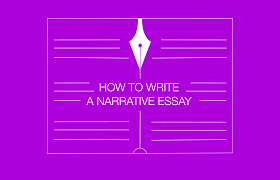
A narrative report is one of the most common assignments in the academic world. Students face this type of task more often in school. That is why it is vital to understand how to handle such for your success in school. The primary purpose of a narrative report is to curate a compelling story. For students looking to pass their TEAS exam, we also offer free TEAS practice tests to help students prepare for their exam.
Elevate Your Writing with Our Free Writing Tools!
Did you know that we provide a free essay and speech generator, plagiarism checker, summarizer, paraphraser, and other writing tools for free?
Here are some few hacks to enable you write exciting and thrilling reports that will get top grades.
How Long Should a Narrative Report Be?
Before getting into writing the report, consider the length of the report. In the preparation to write a narrative report, you ought to follow two rules regarding the length. One is that you should make your narrative report as informative and as concise as possible, and two, the report should follow your professor’s requirements. Make the narrative report unfold in a way that will exhaustively cover the topic and create a story that your intended audience will enjoy.
Have you ever experienced the struggle of trying to write your narrative report? You are not alone since many students, especially those who strive to combine work and studies, always seek research papers for sale from Gudwriter which is offered at an affordable price.
Narrative Report Format
A narrative report should contain three primary sections; the introduction, body, and conclusion.
- Introduction- the introductory paragraph should be about three to five sentences. Take this chance to write a narrative report introduction that warm-up your audience and ensure they read the entire report.
- Body- the body of the narrative report entails supportive arguments that relate to the main idea explained in the introduction. Ensure that every new concept you introduce is described in its paragraph with paragraphs of three to five sentences.
- Conclusion- the conclusion should be a summary of your report concerning the main idea indicated in the introduction.
Tips on Writing an Excellent Narrative Report
- Choose a good topic
Topic selection is aided by how good you are in writing. To select a good topic for your narrative report, ensure you read many narrative essays for inspiration. Broad reading provides you with ideas on how to organize your work and put across your points meticulously. Look for reports that your professors have assigned in the past and check out narrative essays on the internet.
- Put across a story that illustrates a specific topic
Having a theme confines you to the scope of information that you write about in your narrative report. To write a narrative report that makes sense to your audience, have a story, and analyze that story. A narrative report is about a theme where you use a personal account to illustrate that idea to the audience in an exciting manner.
- Your narrative report must fit the requirements
Narrative reports are mainly required for college admission or assignment, which means you are given a prompt to follow by the institution or the lecturer. Even though you have fascinating stories, you must ensure that you follow the requirements outlined in the prompt to avoid straying from the main point.
The common topics include your personality that was transformed. Still, some events, adversities you had to overcome, or how you dealt with consequences of failure in a particular juncture in your life, the topics are not cast in stone. Hence, you have to go through the prompt to understand the specific topic you must handle.
- Narrate a story with a manageable plot
Articulate narrative reports mostly tell stories with specificity. Since you are not writing a book or a novel, write a narrative report that is concise and contained with a proper limitation of characters, plot, and setting. Too broad narratives make bad narrative reports; thus, you should be specific on characters you involve in your story and ensure they participate in building the theme. Read on descriptive essay about a person and a sample.
- Narrate a story with lively details
To make a good narrative report explain specific details, particular images, and a language that makes the story lively for the audience. Discuss the smells and sights in your narrative with particular details with imagination filling the void. Narrative reports are not fictional; thus, you should stay true to the story while being as creative as possible.
The Writing Process of a Narrative Report
After understanding the structure and the elements of narrative report , the writing process becomes relatively easy. Have a captivating introduction and then outline the major points of the narrative report while describing them in the body. Finally, ensure that your description ends with a delightful punchline and an unpredictable twist.
1. Write the report in the first-person
A narrative report is very personal since it describes events that have occurred to you and relates to your identity. It is, therefore, a requirement to use “I” statements without changing to the favor of other characters in your report.
2. Describe places and characters
Although a narrative report is not descriptive, adorn your story with descriptions of crucial characters and places mentioned in the plot. Vivid description mainly goes for characters who are affected by the outcome of your case whose personalities should be disclosed.
3. Editing and proofreading
After creating the first draft, go through it to point out mistakes and essential ideas you might have left out. To do proper editing of your narrative report, take a rest after you finish drafting it, then read it afresh. Clear all repeated ideas and incorporate the critical ideas that you might have missed. Reread your narrative report to check for any grammatical errors. You could also run your report grammar checking software but do not entirely rely on them.
Finally, you can entrust a friend to go through your narrative report. They may point out a mistake that you might have missed while going through the report and give you their opinion on the report. Feel free to explore a racial profiling essay example with outline.
The Do’s and Don’ts of Narrative Report Writing
To smoothen the process of narrative report writing, have the following points in mind.
- Write your story in the first-person point of view.
- Follow the proper narrative report structure.
- Use straightforward and easy-to-read language.
- Put across your points in chronological order.
- Using all the five senses while writing the report- inform the audience what the characters saw and what they felt, smelt, and heard.
Don’ts
- Don’t use the second-person point of view while writing your narrative report.
- Don’t create fictional stories; narratives should be as natural and true as possible.
- Write a concise and short story that is not too broad.
More resources; How to write an information report.
Free Personal Narrative Essay Sample – With Outline
A personal narrative essay is one that tells a story from a defined point of view, often the author’s, so there is feeling as well as specific and often sensory details provided to get the reader involved in the elements and sequence of the story.
The Loan: A Personal Experience Essay Outline
Introduction.
Thesis: In spite of my unending struggles, I hoped and believed I would one day make it in life, and that all that I needed was to identify an opportunity and maximally utilize it.
Paragraph 1:
An opportunity presented itself through a conversation with a workmate called John.
- I learnt that John was receiving ten thousand dollars yearly from an uncle of his.
- I faked a mail order business plan and used it to request him for a four thousand dollars loan for half a year.
- He however only afforded me three thousand dollars, as I gave him an old printing machine of mine as interest.
- I used part of the money to acquire a postal box number and then embarked on squandering what had remained of it.
Paragraph 2:
John demanded back his money by October the same year.
- According to our original plan, I would settle the loan by the 10th of December.
- We however again reached a “mini agreement” and the deadline was revised to the 10th of November.
- I decided to start participating in lottery using the eight hundred dollars I had remained with by then so I could repay the loan.
- I would purchase five tickets bearing similar numbers, which would enable me make 1,500 dollars upon winning the lottery.
Paragraph 3:
I did not win the lottery contrary to my expectations.
- The numbers I had so much trusted had failed me.
- I continued playing but lost every time I tried.
- I was not yet ready to repay the loan even as we reached the 9th of November, and I once again tried my luck in the lottery by picking fifteen numbers.
- I would add what I would win to the $600 I was remaining with at that time.
Paragraph 4:
I decided to use numbers that had been picked by the computer instead of those I had earlier picked.
- I additionally purchased a Super-Cash out of which I would earn $250,000.
- The drawing of my pick would occur at exactly 5.42 p.m. and I would be two thousand five hundred dollars richer if I won.
- I again failed as my numbers did not match the winning “formula.”
- I bought another Super-Cash ticket and banked all my hopes on it.
Paragraph 5:
The drawing was conducted at 11.02 p.m. and I tried my best to have my numbers drawn.
- I once again failed and retired to bed, with depression quickly taking over me.
- I plunged myself into deep thoughts, even wishing I had used my last pick of numbers to play.
- This thought was a bit too little too late.
Paragraph 6:
It was the 10th of November, the deadline for repaying the loan.
- I gave John the six hundred dollars I had remained with and explained to him my situation.
- I received five dollars from my parents, who had empathized with me.
- John lost his job at the end of the month.
Paragraph 7:
On the 3rd of December, I took a step that would culminate in the end of my financial woes.
- I applied for a bank loan and was awarded the amount I had requested.
- This was a simpler and more workable thought than the lottery idea.
- After passing through another period of financially challenging situations, I fully appreciated that it is never a dependable idea to rely on credit.
- Never have I again asked a friend to loan me any amount of money.
Paragraph 8:
Another lesson I should have learnt is not to depend on lottery.
- I could not learn fast enough at that time as I came close to winning every time I played.
- I now appreciate that nothing comes on a silver platter under the sun.
- I also learnt that problems are solved by facing them, not quitting.
- From the entire experience, I learnt the importance of explaining one’s problem to their benefactors.
- John understood my situation after I explained it to him.
- Had I avoided him, our friendship could probably have crumbled.
Enhance your presentations using AI speech generator to easily turn written information into an engaging speech.
The Loan: A Personal Experience Essay
This was my last chance. I would need three thousand dollars by the following day but unfortunately, only seven hundred was in my possession. I would perhaps need to win a lottery in order to raise the remaining amount. Trouble was beckoning for me. I had a tolerable life five months earlier. I was then twenty years old and was staying with my fiancé and our young baby. The apartment we lived in was cramped. Under normal circumstances, the rent that was charged for the apartment should have been affordable for us. However, our meager income could not grant affordability and continuance. Even as I went through unceasing struggles, I still had hopes and belief that I would one day make it in life. All I needed was to identify an opportunity and make good use of it.
It was during a conversation with a workmate that I landed an opportunity. The colleague, John by name, told me that a wealthy uncle of his had been giving him a whopping ten thousand dollars on a yearly basis. Even a small percentage of that amount would change my wanting situation forever. I quickly drafted a fake mail order business plan. I then requested John to give me four thousand dollars in the form of a loan for a period of half a year. I gave him my old printing machine, whose worth was about 300 hundred dollars, as interest. However, John could only afford me three thousand dollars. I could not turn it down. I quickly sprang into action with my business plan. I acquired a postal box number but sadly, that marked my end with the plan. I acted no more on it. Unperturbed, I embarked on squandering the remainder of the three thousand dollars. Whenever John inquired about the progress of my business, I would tell him all was well.
Fast-forward to October the same year, John demanded back his money. Noteworthy, our original agreement indicated that the 10th of December would mark the deadline for settling the loan. At this point, we again reached a “mini-agreement” that I would settle the loan on the 10 th of November. By then, I had been left with eight hundred dollars out of the three thousand I had received. My decision to start taking part in the lottery at this time was informed by the lack of a source that could help me repay the loan. As per this new plan of mine, I would purchase five tickets bearing similar numbers. Upon winning the lottery, I would make 1,500 dollars given that each ticket would fetch five hundred dollars. Since I would have personally purchased the tickets, each store would issue me with a check as opposed to having my prize given to me by Madison. Additionally, no taxes would reduce the amount I would earn.
Strange enough and contrary to my expectations, I would not win the lottery. I had put immense trust on the numbers I had picked to get me the prize. This is why it came to me as a big surprise that the numbers failed to win! I never threw in the towel. I picked on new numbers the following day but sadly, I once again failed to win. I continued playing with unending hopes even though I lost every time I tried. Before I could get ready, it was already the 9th of November. I had to raise the money on this particular day. Relying on my luck and that of nature, I picked fifteen numbers in the lottery. I would spend $75 in buying the numbers since each would cost $5. I would add what I would win to the $600 I was remaining with at that time.
My playing time came and I decided not to use the numbers I had earlier picked. My luck was not definitely in the numbers. I decided to rely on numbers picked by the computer at least for this last chance. In addition, I purchased a Super-Cash. Out of it, I would earn $250,000. On this particular day, I had to go back home early from work since the drawing of my pick would occur at exactly 5.42 p.m. I was already glued to my television screen by 5.30 p.m. Within me; I knew this was my chance. I was just a few minutes away from becoming two thousand five hundred dollars richer. My heart throbbed in my chest as the drawing got underway. ‘3’ was the first number to be drawn. Looking at my ticket, ‘3’ was the first among the numbers. Again, ‘3’ was the second one. On my ticket, the second number was not ‘3’. The same number was supposed to be the third in my ticket. The winning “formula” was to be 3-3-3 which I did not have. I had once again failed. However, not all my hopes had been dashed as the Super-Cash would give me another drawing chance. My financial woes would be over if I won the Super-Cash even though I would not have the cash the following day. My conviction pushed me into purchasing another ticket of Super-Cash. I had never before in my life concentrated the way I did in picking the numbers. This was my last source of hope.
The drawing was conducted at 11.02 p.m. Again, I tried my best to have my numbers drawn. ‘13’ was the first number to appear. It was not on my ticket. I plunged into desperation. Not even a single number out of the numbers that were drawn was on my ticket. I had no more options left. Where would I turn to next? Of course the next thing was to go to bed given that the day was literally over. My problem was that I could not sleep. I wallowed in miser. I wished the following day would not come. I dreaded facing it. I did not want to face tomorrow. As countless thoughts crisscrossed my mind in my bed, I remembered about the numbers I had arranged for my picks. My last pick had been 3-3-3. Had I used this particular pick for playing, I would have been a winner. However, this thought was a bit too little too late.
Morning had come. It was the 10th of November, the day I was to honor my pledge of fully servicing the loan. I woke up and carried with me all the six hundred dollars I was left with to work. I gave John the entire amount and narrated to him my ordeal. Within the week, my parents sent me some five hundred dollars after empathizing with my situation. John lost his job at the end of the month. The reason for his dismissal was failure to report to work. Apparently, he had got a greener pasture and thus had decided to quit his former employer. He had informed me of this. However, things did not turn out as he had expected and thus he tried to plead with the company to have him back. Unfortunately for him, the company would have none of his pleas. He even went as far as asking me to convince the company’s management on his behalf as a close friend.
On the 3rd of December, I took a step that would culminate in the end of my financial woes. Noteworthy, this was some seven days to the 10th of December, the date that I was originally to resettle John’s loan. I applied for a bank loan and was awarded the amount I had requested. As is now evident, this was a simpler and more workable thought than the lottery idea. The incident should have taught me a host of lessons. However, I did not fully learn from it. I would again have to pass through some financially challenging situations in order for me to fully appreciate that relying on credit is often not a dependable idea. As a result, never have I again asked a friend to loan me any amount of money. If that is what being in debt with a friend’s money would cost me, let the idea of borrowing from a non-financial institution be.
Another lesson that the situation should have taught me is not to be dependent on lottery. However, I could not learn fast enough at that time as my chances of winning came so close. I only missed winning because I did not use all the numbers I had picked. As a matter of fact, winning would have made me a ‘wizard’ at choosing lottery numbers. However, all would not come to pass; I kept on failing! I now have enough and valuable experience about the challenging nature of the world. It is never easy. Nothing comes on a silver platter under the sun, not even the lottery. Another hard lesson I learnt out of the situation is the importance of being in a position to face one’s problems with courage. One’s problems are one’s problems; one can never solve them by quitting!
Finally, I learnt the importance of explaining one’s problem to their benefactors. As already seen, I had only remained with $600 by the time John’s loan was due. However, instead of trying to avoid him, I walked right up to him and faced him with my situation. I explained everything that had transpired to him and pleaded with him to understand my situation. My efforts were not in vain as he understood and took my promise that I would settle the debt as soon as I could. Had I started avoiding him, the issue could have caused our friendship to deteriorate drastically. Thus, one should always communicate with those they owe irrespective of whether or not they are in a position to repay their loans.
Stuck in your personal narrative essay despite having insights on the key elements of a narrative essay ? Gudwriter is here to help you sail through. We have top notch writers who understand how to craft narrative essays on any topic. Use our write my narrative essay service and receive a quality paper that is plagiarism free.
Writing a narrative report might be one of the assignments that you find particularly complicated and struggle with. Why risk letting your grade average drop and getting a lower mark overall? Instead, simply say help me write my papers ! and get help from a quality service that will guarantee high marks.

Special offer! Get 20% discount on your first order. Promo code: SAVE20
Related Posts
Free essay guides, how to write a graduation speech.
What is a Graduation Speech? A graduation speech is delivered at the graduation event to congratulate the graduates and provide them with advice and motivation. The speaker could be a student or professor. Your chance Read more…
Free TEAS Practice Test
Study and prepare for your TEAS exam with our free TEAS practice test. Free ATI TEAS practice tests are valuable resources for those hoping to do well on their TEAS exams. As we all know, Read more…

How to Write a Profile Essay
To learn how to write a profile essay, you must first master where to begin. Given that this is a profile essay, it will be much simpler for students who have previously read autobiographical articles Read more…
New report 'braids' Indigenous and Western knowledge for forest adaptation strategies against climate change
Forests could also be potential bulwarks against climate change. But, increasingly severe droughts and wildfires, invasive species, and large insect outbreaks -- all intensified by climate change -- are straining many national forests and surrounding lands in the United States. A report by a team of 40 experts outlines a new approach to forest stewardship that "braids together" Indigenous knowledge and Western science to conserve and restore more resilient forestlands. Published March 25, the report provides foundational material to inform future work on climate-smart adaptive management practices for USDA Forest Service land managers.
There are 154 national forests in the United States, covering nearly 300,000 square miles of forests, woodlands, shrublands, wetlands, meadows and prairies. These lands are increasingly recognized as vital for supporting a broad diversity of plant and animal life; for water and nutrient cycling; and for the human communities that depend on forests and find cultural and spiritual significance within them. Forests could also be potential bulwarks against climate change. But, increasingly severe droughts and wildfires, invasive species, and large insect outbreaks -- all intensified by climate change -- are straining many national forests and surrounding lands.
A report by a team of 40 experts outlines a new approach to forest stewardship that "braids together" Indigenous knowledge and Western science to conserve and restore more resilient forestlands. Published March 25, the report provides foundational material to inform future work on climate-smart adaptive management practices for USDA Forest Service land managers.
"Our forests are in grave danger in the face of climate change," said Cristina Eisenberg, an associate dean of forestry at Oregon State University. "By braiding together Indigenous knowledge with Western science, we can view the problems with what is known as 'Two-Eyed Seeing,' to develop a path forward that makes our forests more resilient to the threats they are facing. That is what this report is working to accomplish."
Eisenberg co-led the report team with Susan Prichard, a fire ecologist in the School of Environmental and Forest Sciences at the University of Washington.
"Climate change is stressing these forests even as they are considered for their potential role in slowing rates of climate change," said Prichard. "We want this report to provide not just guidance, but also hope -- hope in the practical measures we can take now to promote resiliency and help forests thrive."
Initiated by interest from the Forest Service on Indigenous knowledge and Western science, the report stems from direction to protect old and mature forests outlined in Executive Order 14072, signed by President Joe Biden in April 2022. These types of forests, some hundreds of years old, are often dominated by larger trees, with fewer seedlings and saplings. Some management practices over the past century have made many of these forests vulnerable to drought, fire, insects and other stressors, all of which will likely increase with climate change.
The executive order included guidance on strengthening relationships with tribal governments and emphasized the importance of Indigenous knowledge, a theme highlighted repeatedly in the new report. This knowledge includes the time-tested practices of Indigenous stewardship that for millennia shaped forest structure and species composition. Following European colonization, these practices were sharply curtailed by genocide, displacement, and forced assimilation of Indigenous peoples. Western scientists increasingly recognize that Indigenous stewardship practices built and maintained forests that were more resilient and ecologically diverse than today.
Many Indigenous cultures, for example, used a practice called intentional burning -- also known as cultural burning -- which decreased forest density, promoted healthy understory growth, and hosted a broad diversity of plant and animal life. These practices over time yielded "mosaics" of forests made up of diverse patches of trees varying in age, density, and overstory and understory composition. These "mosaic" forests are less prone to the types of large, severe wildfires that have burned swathes of North American forests this century, according to Prichard.
Other members of the core leadership team for the report are Paul Hessburg, a senior research ecologist with the Forest Service's Pacific Northwest Research Station, and Michael Paul Nelson, a professor and director of the Center for the Future of Forests and Society at OSU.
"Two powerful ideas we heard from our Indigenous colleagues in developing this are those of reciprocity and the seven generations principle. Collectively, the writing team agrees that we can frame a more sustainable land ethic with these ideas," said Hessburg. "These perspectives guided our recommendations, which suggest taking from the land and giving back in equal measure, and proactively stewarding these lands with seven generations in mind."
Report co-authors come from tribal nations, universities, U.S. Forest Service research stations, consulting groups, Natural Resources Canada, Parks Canada, and Tall Timbers Research Station and Land Conservancy.
"Our report is deeper than changes in policy and management -- it proposes a fundamental change in the worldview guiding our current practices," said Nelson. "Our writing team's cultural, geographic and disciplinary diversity allows for guidance on a shift in paradigms around how we approach forest stewardship in the face of climate change."
The report may also inform Forest Service work on the proposed national forest land plan amendment intended to steward and conserve old-growth forest conditions.
"We are very interested in understanding how Indigenous knowledge can be used in combination with western science to improve our management of all forest conditions including old growth," said Forest Service Deputy Chief Chris French. "This report is a big step in improving our understanding of how to do that."
- Ecology Research
- Endangered Animals
- Rainforests
- Environmental Awareness
- Environmental Policy
- Consensus of scientists regarding global warming
- Climate change mitigation
- IPCC Report on Climate Change - 2007
- Scientific opinion on climate change
- Global warming controversy
- Climate engineering
- Deforestation
- Kyoto Protocol
Story Source:
Materials provided by University of Washington . Original written by James Urton. Note: Content may be edited for style and length.
Cite This Page :
Explore More
- Genes for Strong Muscles: Healthy Long Life
- Brightest Gamma-Ray Burst
- Stellar Winds of Three Sun-Like Stars Detected
- Fences Causing Genetic Problems for Mammals
- Ozone Removes Mating Barriers Between Fly ...
- Parkinson's: New Theory On Origins and Spread
- Clash of Stars Solves Stellar Mystery
- Secure Quantum Computing at Home
- Ocean Currents: Collapse of Antarctic Ice ...
- Pacific Cities Much Older Than Previously ...
Trending Topics
Strange & offbeat.
Suggestions or feedback?
MIT News | Massachusetts Institute of Technology
- Machine learning
- Social justice
- Black holes
- Classes and programs
Departments
- Aeronautics and Astronautics
- Brain and Cognitive Sciences
- Architecture
- Political Science
- Mechanical Engineering
Centers, Labs, & Programs
- Abdul Latif Jameel Poverty Action Lab (J-PAL)
- Picower Institute for Learning and Memory
- Lincoln Laboratory
- School of Architecture + Planning
- School of Engineering
- School of Humanities, Arts, and Social Sciences
- Sloan School of Management
- School of Science
- MIT Schwarzman College of Computing
A new way to detect radiation involving cheap ceramics
Press contact :.

Previous image Next image
The radiation detectors used today for applications like inspecting cargo ships for smuggled nuclear materials are expensive and cannot operate in harsh environments, among other disadvantages. Now, in work funded largely by the U.S. Department of Homeland Security with early support from the U.S. Department of Energy, MIT engineers have demonstrated a fundamentally new way to detect radiation that could allow much cheaper detectors and a plethora of new applications.
They are working with Radiation Monitoring Devices , a company in Watertown, Massachusetts, to transfer the research as quickly as possible into detector products.
In a 2022 paper in Nature Materials , many of the same engineers reported for the first time how ultraviolet light can significantly improve the performance of fuel cells and other devices based on the movement of charged atoms, rather than those atoms’ constituent electrons.
In the current work, published recently in Advanced Materials , the team shows that the same concept can be extended to a new application: the detection of gamma rays emitted by the radioactive decay of nuclear materials.
“Our approach involves materials and mechanisms very different than those in presently used detectors, with potentially enormous benefits in terms of reduced cost, ability to operate under harsh conditions, and simplified processing,” says Harry L. Tuller, the R.P. Simmons Professor of Ceramics and Electronic Materials in MIT’s Department of Materials Science and Engineering (DMSE).
Tuller leads the work with key collaborators Jennifer L. M. Rupp, a former associate professor of materials science and engineering at MIT who is now a professor of electrochemical materials at Technical University Munich in Germany, and Ju Li, the Battelle Energy Alliance Professor in Nuclear Engineering and a professor of materials science and engineering. All are also affiliated with MIT’s Materials Research Laboratory
“After learning the Nature Materials work, I realized the same underlying principle should work for gamma-ray detection — in fact, may work even better than [UV] light because gamma rays are more penetrating — and proposed some experiments to Harry and Jennifer,” says Li.
Says Rupp, “Employing shorter-range gamma rays enable [us] to extend the opto-ionic to a radio-ionic effect by modulating ionic carriers and defects at material interfaces by photogenerated electronic ones.”
Other authors of the Advanced Materials paper are first author Thomas Defferriere, a DMSE postdoc, and Ahmed Sami Helal, a postdoc in MIT’s Department of Nuclear Science and Engineering.
Modifying barriers
Charge can be carried through a material in different ways. We are most familiar with the charge that is carried by the electrons that help make up an atom. Common applications include solar cells. But there are many devices — like fuel cells and lithium batteries — that depend on the motion of the charged atoms, or ions, themselves rather than just their electrons.
The materials behind applications based on the movement of ions, known as solid electrolytes, are ceramics. Ceramics, in turn, are composed of tiny crystallite grains that are compacted and fired at high temperatures to form a dense structure. The problem is that ions traveling through the material are often stymied at the boundaries between the grains.
In their 2022 paper, the MIT team showed that ultraviolet (UV) light shone on a solid electrolyte essentially causes electronic perturbations at the grain boundaries that ultimately lower the barrier that ions encounter at those boundaries. The result: “We were able to enhance the flow of the ions by a factor of three,” says Tuller, making for a much more efficient system.
Vast potential
At the time, the team was excited about the potential of applying what they’d found to different systems. In the 2022 work, the team used UV light, which is quickly absorbed very near the surface of a material. As a result, that specific technique is only effective in thin films of materials. (Fortunately, many applications of solid electrolytes involve thin films.)
Light can be thought of as particles — photons — with different wavelengths and energies. These range from very low-energy radio waves to the very high-energy gamma rays emitted by the radioactive decay of nuclear materials. Visible light — and UV light — are of intermediate energies, and fit between the two extremes.
The MIT technique reported in 2022 worked with UV light. Would it work with other wavelengths of light, potentially opening up new applications? Yes, the team found. In the current paper they show that gamma rays also modify the grain boundaries resulting in a faster flow of ions that, in turn, can be easily detected. And because the high-energy gamma rays penetrate much more deeply than UV light, “this extends the work to inexpensive bulk ceramics in addition to thin films,” says Tuller. It also allows a new application: an alternative approach to detecting nuclear materials.
Today’s state-of-the-art radiation detectors depend on a completely different mechanism than the one identified in the MIT work. They rely on signals derived from electrons and their counterparts, holes, rather than ions. But these electronic charge carriers must move comparatively great distances to the electrodes that “capture” them to create a signal. And along the way, they can be easily lost as they, for example, hit imperfections in a material. That’s why today’s detectors are made with extremely pure single crystals of material that allow an unimpeded path. They can be made with only certain materials and are difficult to process, making them expensive and hard to scale into large devices.
Using imperfections
In contrast, the new technique works because of the imperfections — grains — in the material. “The difference is that we rely on ionic currents being modulated at grain boundaries versus the state-of-the-art that relies on collecting electronic carriers from long distances,” Defferriere says.
Says Rupp, “It is remarkable that the bulk ‘grains’ of the ceramic materials tested revealed high stabilities of the chemistry and structure towards gamma rays, and solely the grain boundary regions reacted in charge redistribution of majority and minority carriers and defects.”
Comments Li, “This radiation-ionic effect is distinct from the conventional mechanisms for radiation detection where electrons or photons are collected. Here, the ionic current is being collected.”
Igor Lubomirsky, a professor in the Department of Materials and Interfaces at the Weizmann Institute of Science, Israel, who was not involved in the current work, says, “I found the approach followed by the MIT group in utilizing polycrystalline oxygen ion conductors very fruitful given the [materials’] promise for providing reliable operation under irradiation under the harsh conditions expected in nuclear reactors where such detectors often suffer from fatigue and aging. [They also] benefit from much-reduced fabrication costs.”
As a result, the MIT engineers are hopeful that their work could result in new, less expensive detectors. For example, they envision trucks loaded with cargo from container ships driving through a structure that has detectors on both sides as they leave a port. “Ideally, you’d have either an array of detectors or a very large detector, and that’s where [today’s detectors] really don’t scale very well,” Tuller says.
Another potential application involves accessing geothermal energy, or the extreme heat below our feet that is being explored as a carbon-free alternative to fossil fuels. Ceramic sensors at the ends of drill bits could detect pockets of heat — radiation — to drill toward. Ceramics can easily withstand extreme temperatures of more than 800 degrees Fahrenheit and the extreme pressures found deep below the Earth’s surface.
The team is excited about additional applications for their work. “This was a demonstration of principle with just one material,” says Tuller, “but there are thousands of other materials good at conducting ions.”
Concludes Defferriere: “It’s the start of a journey on the development of the technology, so there’s a lot to do and a lot to discover.”
This work is currently supported by the U.S. Department of Homeland Security, Countering Weapons of Mass Destruction Office. This support does not constitute an express or implied endorsement on the part of the government. It was also funded by the U.S. Defense Threat Reduction Agency.
Share this news article on:
Related links.
- Harry Tuller
- Tuller Research Group
- Materials Research Laboratory
Related Topics
- Nuclear security and policy
- Materials science and engineering
- Nuclear science and engineering
- Department of Energy (DoE)
Related Articles

A simple way to significantly increase lifetimes of fuel cells and other devices

Harry Tuller honored for career advancing solid-state chemistry and electrochemistry

Light could boost performance of fuel cells, lithium batteries, and other devices
Previous item Next item
More MIT News

A biomedical engineer pivots from human movement to women’s health
Read full story →

MIT tops among single-campus universities in US patents granted

A crossroads for computing at MIT

Growing our donated organ supply

New AI method captures uncertainty in medical images

Improving drug development with a vast map of the immune system
- More news on MIT News homepage →
Massachusetts Institute of Technology 77 Massachusetts Avenue, Cambridge, MA, USA
- Map (opens in new window)
- Events (opens in new window)
- People (opens in new window)
- Careers (opens in new window)
- Accessibility
- Social Media Hub
- MIT on Facebook
- MIT on YouTube
- MIT on Instagram

Your company may already be a member. View our member list to find out, or create a new account .
Forgot Password?
Content Library
You can search our content library for case studies, research, industry insights, and more.
You can search our website for events, press releases, blog posts, and more.
ANA Collection of Summary Reports on Artificial Intelligence
April 10, 2024
2 023 will go down as the year artificial intelligence (AI), in particular Generative AI, scaled to the masses and became a priority across almost every vertical. From its ability to revolutionize the creative process to the democratization of data, AI is changing the entirety of the advertising business. Regardless of whether the report is advertising-specific, the ANA feels that there is tremendous value, to CMOs or those who lead in-house agencies, to have a strong grasp of the impact AI is having on business.
The ANA has compiled and summarized a collection of 18 AI research reports that most closely align with the interests of marketers. This collection is a starting point and strong resource for your strategic discussions about AI adoption in 2024 and beyond.
Click the DOWNLOAD NOW button for the full report.
"ANA Collection of Summary Reports on Artificial Intelligence." ANA, 4/10/24.
Read our research on: Gun Policy | International Conflict | Election 2024
Regions & Countries
9 facts about americans and marijuana.

The use and possession of marijuana is illegal under U.S. federal law, but about three-quarters of states have legalized the drug for medical or recreational purposes. The changing legal landscape has coincided with a decades-long rise in public support for legalization, which a majority of Americans now favor.
Here are nine facts about Americans’ views of and experiences with marijuana, based on Pew Research Center surveys and other sources.
As more states legalize marijuana, Pew Research Center looked at Americans’ opinions on legalization and how these views have changed over time.
Data comes from surveys by the Center, Gallup , and the 2022 National Survey on Drug Use and Health from the U.S. Substance Abuse and Mental Health Services Administration. Information about the jurisdictions where marijuana is legal at the state level comes from the National Organization for the Reform of Marijuana Laws .
More information about the Center surveys cited in the analysis, including the questions asked and their methodologies, can be found at the links in the text.
Around nine-in-ten Americans say marijuana should be legal for medical or recreational use, according to a January 2024 Pew Research Center survey . An overwhelming majority of U.S. adults (88%) say either that marijuana should be legal for medical use only (32%) or that it should be legal for medical and recreational use (57%). Just 11% say the drug should not be legal in any form. These views have held relatively steady over the past five years.
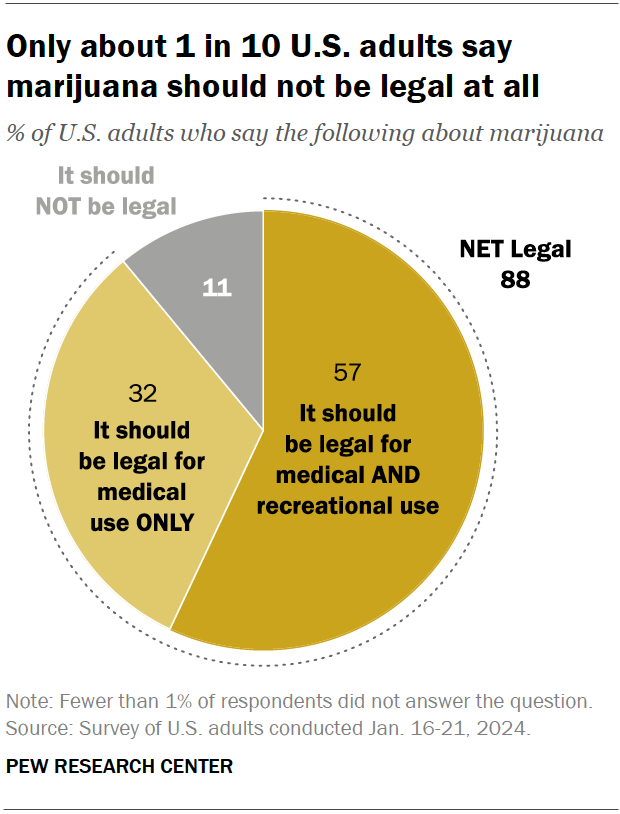
Views on marijuana legalization differ widely by age, political party, and race and ethnicity, the January survey shows.

While small shares across demographic groups say marijuana should not be legal at all, those least likely to favor it for both medical and recreational use include:
- Older adults: 31% of adults ages 75 and older support marijuana legalization for medical and recreational purposes, compared with half of those ages 65 to 74, the next youngest age category. By contrast, 71% of adults under 30 support legalization for both uses.
- Republicans and GOP-leaning independents: 42% of Republicans favor legalizing marijuana for both uses, compared with 72% of Democrats and Democratic leaners. Ideological differences exist as well: Within both parties, those who are more conservative are less likely to support legalization.
- Hispanic and Asian Americans: 45% in each group support legalizing the drug for medical and recreational use. Larger shares of Black (65%) and White (59%) adults hold this view.
Support for marijuana legalization has increased dramatically over the last two decades. In addition to asking specifically about medical and recreational use of the drug, both the Center and Gallup have asked Americans about legalizing marijuana use in a general way. Gallup asked this question most recently, in 2023. That year, 70% of adults expressed support for legalization, more than double the share who said they favored it in 2000.
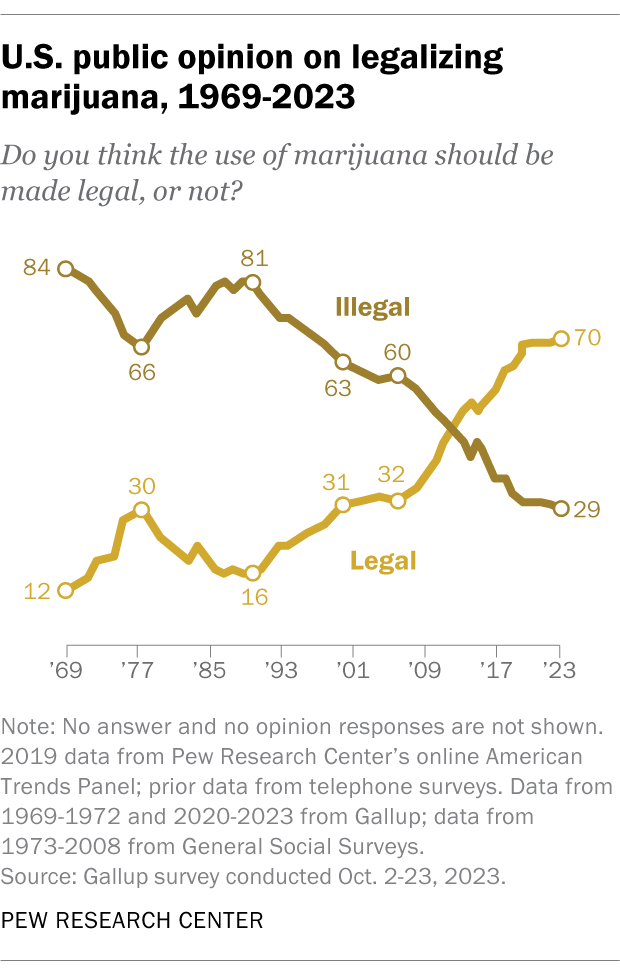
Half of U.S. adults (50.3%) say they have ever used marijuana, according to the 2022 National Survey on Drug Use and Health . That is a smaller share than the 84.1% who say they have ever consumed alcohol and the 64.8% who have ever used tobacco products or vaped nicotine.
While many Americans say they have used marijuana in their lifetime, far fewer are current users, according to the same survey. In 2022, 23.0% of adults said they had used the drug in the past year, while 15.9% said they had used it in the past month.
While many Americans say legalizing recreational marijuana has economic and criminal justice benefits, views on these and other impacts vary, the Center’s January survey shows.
- Economic benefits: About half of adults (52%) say that legalizing recreational marijuana is good for local economies, while 17% say it is bad. Another 29% say it has no impact.
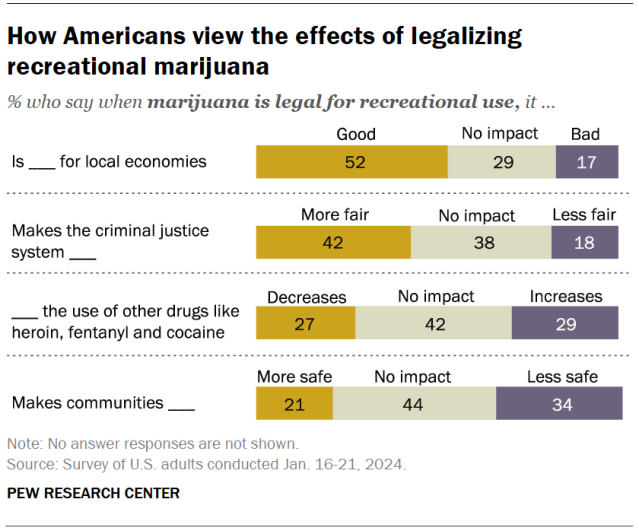
- Criminal justice system fairness: 42% of Americans say legalizing marijuana for recreational use makes the criminal justice system fairer, compared with 18% who say it makes the system less fair. About four-in-ten (38%) say it has no impact.
- Use of other drugs: 27% say this policy decreases the use of other drugs like heroin, fentanyl and cocaine, and 29% say it increases it. But the largest share (42%) say it has no effect on other drug use.
- Community safety: 21% say recreational legalization makes communities safer and 34% say it makes them less safe. Another 44% say it doesn’t impact safety.
Democrats and adults under 50 are more likely than Republicans and those in older age groups to say legalizing marijuana has positive impacts in each of these areas.
Most Americans support easing penalties for people with marijuana convictions, an October 2021 Center survey found . Two-thirds of adults say they favor releasing people from prison who are being held for marijuana-related offenses only, including 41% who strongly favor this. And 61% support removing or expunging marijuana-related offenses from people’s criminal records.
Younger adults, Democrats and Black Americans are especially likely to support these changes. For instance, 74% of Black adults favor releasing people from prison who are being held only for marijuana-related offenses, and just as many favor removing or expunging marijuana-related offenses from criminal records.
Twenty-four states and the District of Columbia have legalized small amounts of marijuana for both medical and recreational use as of March 2024, according to the National Organization for the Reform of Marijuana Laws (NORML), an advocacy group that tracks state-level legislation on the issue. Another 14 states have legalized the drug for medical use only.
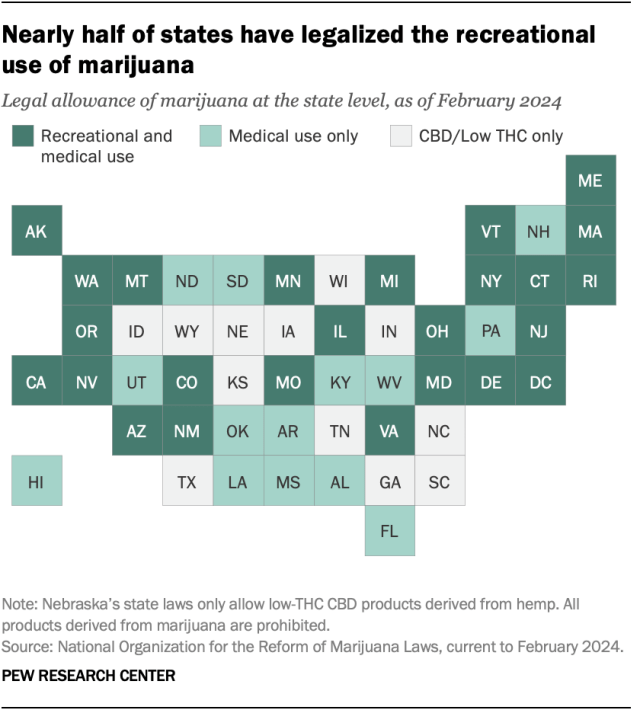
Of the remaining 12 states, all allow limited access to products such as CBD oil that contain little to no THC – the main psychoactive substance in cannabis. And 26 states overall have at least partially decriminalized recreational marijuana use , as has the District of Columbia.
In addition to 24 states and D.C., the U.S. Virgin Islands , Guam and the Northern Mariana Islands have legalized marijuana for medical and recreational use.
More than half of Americans (54%) live in a state where both recreational and medical marijuana are legal, and 74% live in a state where it’s legal either for both purposes or medical use only, according to a February Center analysis of data from the Census Bureau and other outside sources. This analysis looked at state-level legislation in all 50 states and the District of Columbia.
In 2012, Colorado and Washington became the first states to pass legislation legalizing recreational marijuana.
About eight-in-ten Americans (79%) live in a county with at least one cannabis dispensary, according to the February analysis. There are nearly 15,000 marijuana dispensaries nationwide, and 76% are in states (including D.C.) where recreational use is legal. Another 23% are in medical marijuana-only states, and 1% are in states that have made legal allowances for low-percentage THC or CBD-only products.
The states with the largest number of dispensaries include California, Oklahoma, Florida, Colorado and Michigan.
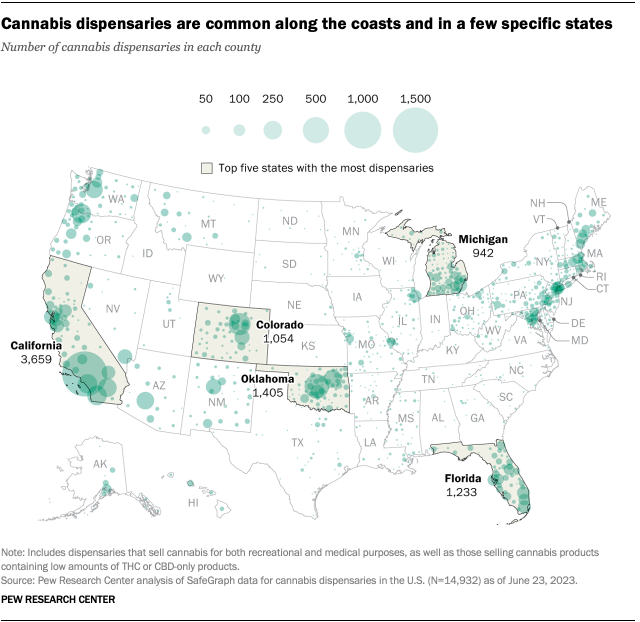
Note: This is an update of a post originally published April 26, 2021, and updated April 13, 2023.

Sign up for our weekly newsletter
Fresh data delivered Saturday mornings
Americans overwhelmingly say marijuana should be legal for medical or recreational use
Religious americans are less likely to endorse legal marijuana for recreational use, four-in-ten u.s. drug arrests in 2018 were for marijuana offenses – mostly possession, two-thirds of americans support marijuana legalization, most popular.
About Pew Research Center Pew Research Center is a nonpartisan fact tank that informs the public about the issues, attitudes and trends shaping the world. It conducts public opinion polling, demographic research, media content analysis and other empirical social science research. Pew Research Center does not take policy positions. It is a subsidiary of The Pew Charitable Trusts .

COMMENTS
Focus on a specific event or detail to make your narrative more focused and impactful. Look for universal themes like love or personal transformation that connect with readers on a deeper level. Brainstorm ideas and write freely to uncover compelling topics. Decide on storytelling techniques like flashbacks or foreshadowing and choose a topic ...
When To Use Narrative Analysis. As a qualitative method focused on analysing and interpreting narratives describing human experiences, narrative analysis is usually most appropriate for research topics focused on social, personal, cultural, or even ideological events or phenomena and how they're understood at an individual level.. For example, if you were interested in understanding the ...
As part of our Understanding Narrative Research Methodologies project, Narrative Initiative worked with Spitfire Strategies to produce a field guide to narrative research methodologies. Based on nearly 20 interviews with researchers, practitioners and academics, this report explores the landscape of both existing and emergent narrative research ...
Several research topics and questions indicate when using a narrative approach is appropriate. The key criterion of narrative research is storytelling (Fraser, 2004). A narrative study can be conducted with a single participant, such as with a biographical study or an autoethnography, or with several people who share common experiences, using ...
The antecedents of contemporary narrative social research are commonly located in two parallel academic moves (Andrews et al., 2004; Rustin, 2000).1 The first is the post-war rise of humanist approaches within western sociology and psychology. These approaches posed holistic, person-centred approaches, often including attention to individual ...
Narrative analysis in research. Narrative analysis is an approach to qualitative research that involves the documentation of narratives both for the purpose of understanding events and phenomena and understanding how people communicate stories. Collecting narrative data means focusing on individual research participants to understand particular ...
Interactive example of a narrative essay. An example of a short narrative essay, responding to the prompt "Write about an experience where you learned something about yourself," is shown below. Hover over different parts of the text to see how the structure works. Narrative essay example.
Introduction. Narrative research systematically codes individual differences in the ways in which participants story crucial events in their lives to understand the extent to which they create meaning and purpose (McAdams, 2008).These narrative descriptions of life events address a diverse array of topics, such as personality (McAdams and Guo, 2015), development (Fivush et al., 2006), clinical ...
Introduction. Narrative research systematically codes individual differences in the ways in which participants story crucial events in their lives to understand the extent to which they create meaning and purpose (McAdams, 2008).These narrative descriptions of life events address a diverse array of topics, such as personality (McAdams and Guo, 2015), development (Fivush et al., 2006), clinical ...
Narrative inquiry or narrative emerged as a subject stream in the field of qualitative research in the early twentieth century. Contemporary narrative inquiry can be characterized as an amalgam of interdisciplinary analytic lenses, diverse disciplinary approaches, and both traditional and innovative methods—all revolving around and interest in biographical particulars as narrated by the one ...
Narrative reviews have many strengths. They are flexible and practical, and ideally provide a readable, relevant synthesis of a diverse literature. Narrative reviews are often helpful for teaching or learning about a topic because they deliver a general overview. They are also useful for setting the stage for future research, as they offer an ...
Introduction and background. A literature review provides an important insight into a particular scholarly topic. It compiles published research on a topic, surveys different sources of research, and critically examines these sources [].A literature review may be argumentative, integrative, historical, methodological, systematic, or theoretical, and these approaches may be adopted depending ...
Narrative research aims to unravel consequential stories of people 's lives as. told by them in their own words and worlds. In the context of the health, social. sciences, and education ...
Narrative analysis is a qualitative research methodology that involves examining and interpreting the stories or narratives people tell in order to gain insights into the meanings, experiences, and perspectives that underlie them. Narrative analysis can be applied to various forms of communication, including written texts, oral interviews, and ...
There are various ways in which to present a paper using Narrative Writing. Here are examples: 1. Introduction: in this section, you present your topic and thesis statement. Body: in this section, you discuss the issue. Do not inject your personal opinion. Present the story and images in your own words. Conclusion: here, you present your ...
The Field Guide: Narrative Research Methodologies details the project and findings. We were fortunate to share our findings with about 100 practitioners on the webinar. Here are highlights of the findings, including a look at the disparities in research access and what this project says about steps forward. Márquez Rhyne on narrative research.
Writing a narrative report involves conveying information through a story-like format, making it more engaging and memorable for the reader. Crafting a Compelling Introduction. Begin with an introduction that sets the stage. For a Narrative Report in Research Paper, introduce your topic and research objectives clearly. Developing a Clear Narrative
1. Write the report in the first-person. A narrative report is very personal since it describes events that have occurred to you and relates to your identity. It is, therefore, a requirement to use "I" statements without changing to the favor of other characters in your report. 2.
The aim of this study is to create a framework to narrate positive and n egative ex-. periences of two higher education faculty members in using social media; pros and. cons of using social media ...
Prior studies are reviewed for overall characteristics, research topics, theoretical foundations, and methods. Articles published between 2000 and 2018 were analyzed using the content analysis method. ... For example, Kang et al. (2018), in their approach to the measurement of tone in the narrative sections in annual reports, ...
5.2 Narrative Research. Narrative research stems from the sense that narrative is a mode of thinking—an expression of cultures' storehouse of knowledge (Bruner 1986 ). It is argued that teachers' knowledge and understanding of school and classroom practice is stored in narrative and discourse about practice is often in narrative form.
Narrative inquiry: a relational research methodology for medical education.. PubMed. Clandinin, D Jean; Cave, Marie T; Berendonk, Charlotte. 2017-01-01. Narrative research, an inclusive term for a range of methodologies, has rapidly become part of medical education scholarship.In this paper we identify narrative inquiry as a particular theoretical and methodological framework within narrative ...
A report by a team of 40 experts outlines a new approach to forest stewardship that "braids together" Indigenous knowledge and Western science to conserve and restore more resilient forestlands.
In the current paper they show that gamma rays also modify the grain boundaries resulting in a faster flow of ions that, in turn, can be easily detected. And because the high-energy gamma rays penetrate much more deeply than UV light, "this extends the work to inexpensive bulk ceramics in addition to thin films," says Tuller.
The first step in conducting a narrative review requires researchers to describe the rationale and justification for the review. Narrative reviews are useful for research questions across many different topics. For example, researchers may be seeking clarity on a topic where there is limited knowledge, or to synthesize and analyze an existing ...
This analysis draws from several Pew Research Center reports on Americans' use of and attitudes about social media, based on surveys conducted in 2023. For more information, read: Americans' Social Media Use; How U.S. Adults Use TikTok; Social Media and News Fact Sheet; Teens, Social Media and Technology 2023
A majority of Americans feel that corporations and wealthy people don't pay their fair share in taxes, according to a Center survey from spring 2023.About six-in-ten U.S. adults say they're bothered a lot by the feeling that some corporations (61%) and some wealthy people (60%) don't pay their fair share.
Research Topics . All Publications Methods Short Reads Tools & Resources Experts About. ... The analysis in this report is based on an online survey of 2,531 U.S. public K-12 teachers conducted from Oct. 17 to Nov. 14, 2023. The teachers surveyed are members of RAND's American Teacher Panel, a nationally representative panel of public K-12 ...
Regardless of whether the report is advertising-specific, the ANA feels that there is tremendous value, to CMOs or those who lead in-house agencies, to have a strong grasp of the impact AI is having on business. The ANA has compiled and summarized a collection of 18 AI research reports that most closely align with the interests of marketers.
Around nine-in-ten Americans say marijuana should be legal for medical or recreational use, according to a January 2024 Pew Research Center survey.An overwhelming majority of U.S. adults (88%) say either that marijuana should be legal for medical use only (32%) or that it should be legal for medical and recreational use (57%).Just 11% say the drug should not be legal in any form.